Below is a blog written by Yuuki Blakeney, ゆ(Yu) う(U) き(Ki), a trained forest school leader and parent in our school who volunteered to help with our forest school sessions. We are very grateful to Yuuki for capturing some of what happened during a block of nine forest school sessions with Senior Infants and some of the benefits of this child led approach to regularly learning in a natural environment.
On a lovely sunny autumn day, the Senior Infants had their first Forest School this year in the Killiney Hill.
In this session, the children got to know their new basecamp, at which they will be spending the rest of the Forest School sessions. They gave names to the places and natural objects such as rocks, trees and logs in the basecamp, by using all their senses; observing, touching, listening, smelling and even tasting. They explored, drew pictures of the place and played in nature.
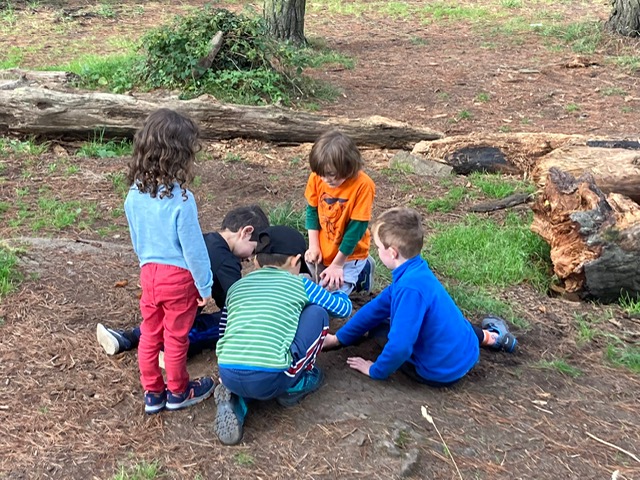
We started the session with everyone gathering in a circle, and introduced each other with our names and our “nature names”. Everyone chose to be a different creature, such as Squirrel, rabbit, fox, pine tree etc. and our circle became full of lively animals.
Then we reminded ourselves of the Green Agreements of the Forest School, which are;
This is a very important part of Forest School, where each child has responsibility to be safe in nature, to cooperate and protect each other, and to look after nature.
Then it was time to move to the basecamp. On our way, each child was given an opportunity to name a place or a natural object. They were encouraged to use all types of responses such as imaginative, descriptive, and sensory for naming. They had to observe objects carefully, and find something unique about them, such as “Spiky Silver Tree”, “Three Toes tree”, “Stony Bridge”, “Rainbow Tree”. By giving them names, they also feel that those places and natural objects are familiar, like their friends, and they will notice changes in those places throughout the seasons by returning to them every week.
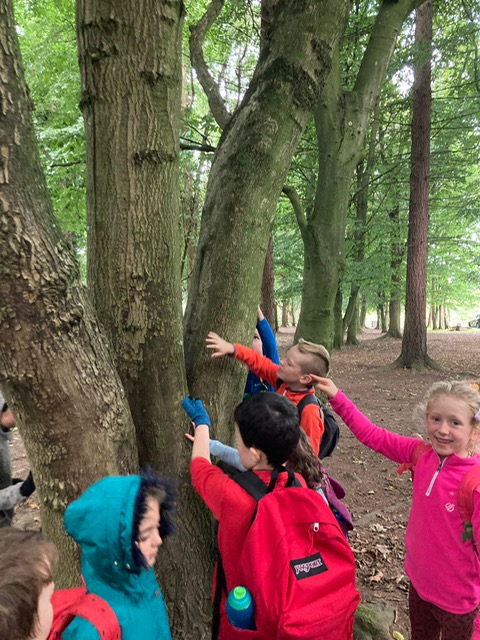
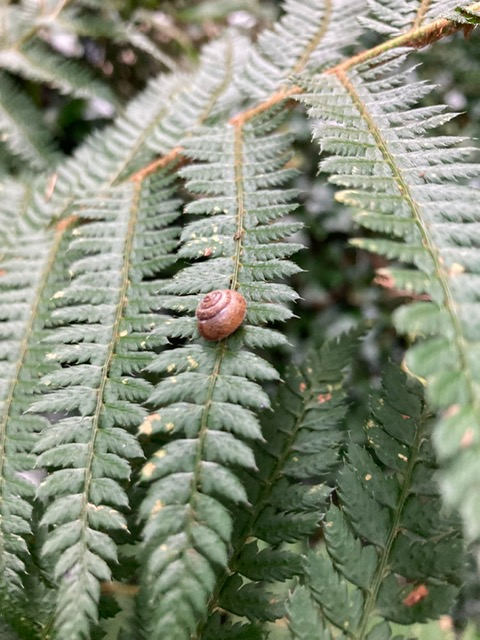
At the basecamp, we first checked our boundaries by taking a walk together. It is important for the children to know their boundaries, inside which they are allowed to explore and play. We named the trees along the boundary, and made sure to call out if one of the children went beyond. In this way, the children feel a sense of responsibility and try to protect each other.
Also, we learned the Wolf Call which is used when the teacher wants everyone to come back to where she/he is. This call, like a real wolf call, can be heard from a distance so that the group can be gathered in quickly and everyone can take part in the call.
Then, there was time for free play – during this time the children could explore their basecamp freely without any guidance from their teachers.
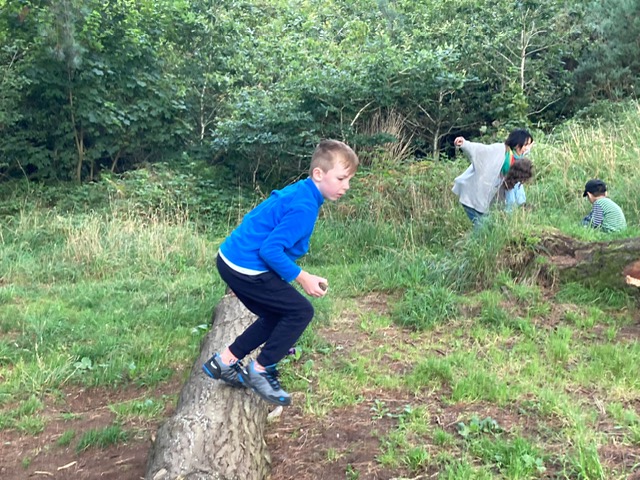
Some of them started to make a fairy house from fallen branches, leaves, stones etc. The children in this age group love imaginary play, which enforces their creative mind, allowing them to explore their inner imaginary world, express their emotions, and get a sense of connection with nature by making their fairy friends living in the forest. Through these activities, they touch different shapes, textures and patterns of fallen leaves, branches, and tree bark, and they may notice the berries and flowers found in the basecamp.
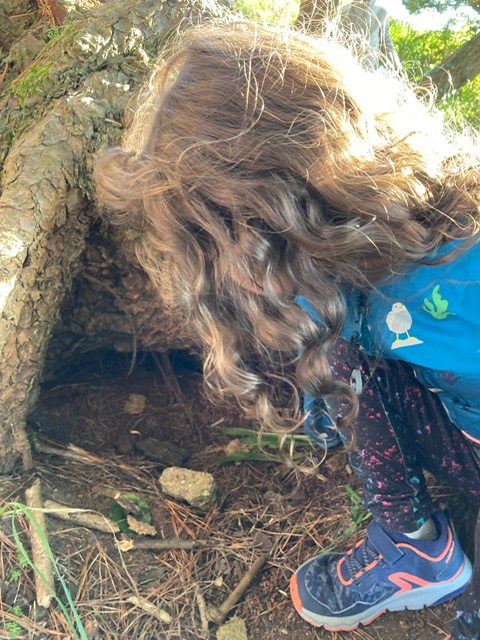
Others loved digging holes using sticks or broken tree bark. Often they liked to challenge themselves; finding the longest branch, or digging as fast as possible or as deep as possible. They naturally formed teams in which they learned how to communicate, cooperate, and have as much fun as possible. This helps to promote development of their emotional intelligence.
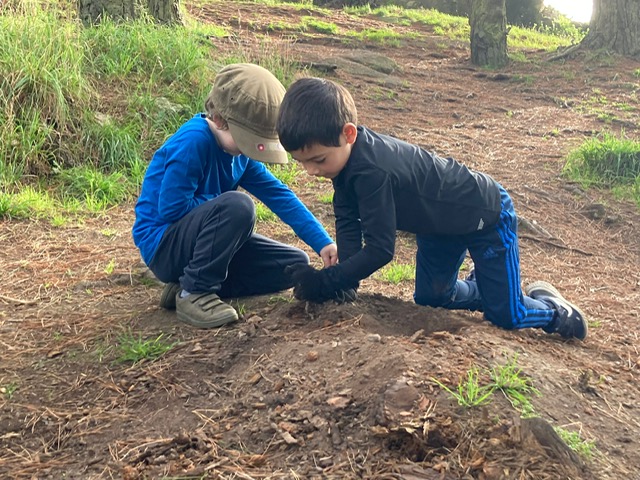
Climbing trees is something all children love, and those who had confidence wanted to go up higher. The teacher showed them which branches were safe to climb on (i.e. not the dead branches). During the Forest School sessions, there are many occasions where the children tried taking risks, such as climbing trees and slippy rocks, or carrying big logs etc. According to Rinaldi (2006) and Stterby (2009), taking appropriate risks is essential for children at any stage of their development and learning. The children learn their own limits by taking risks, and trying to improve results through repetitive trials. This supports not only physical development but also cognitive development – children try to solve problems, they try to understand their situation and learn by trial and error.
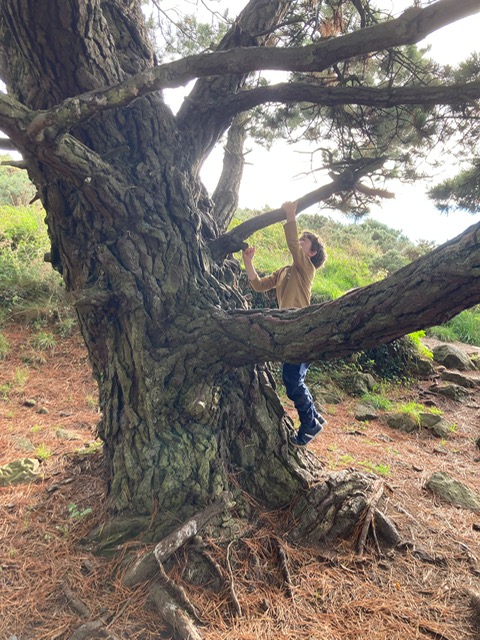
One of the children was very good at finding moths. He found them fascinating and observed their shapes, colours, and how they rested on the leaves. He told his friends where he found them. There is no better way to learn about plants, animals and ecosystems than exploring nature. This stimulates their curiosity, their desire to the knowledge and enhance their intellectual development.
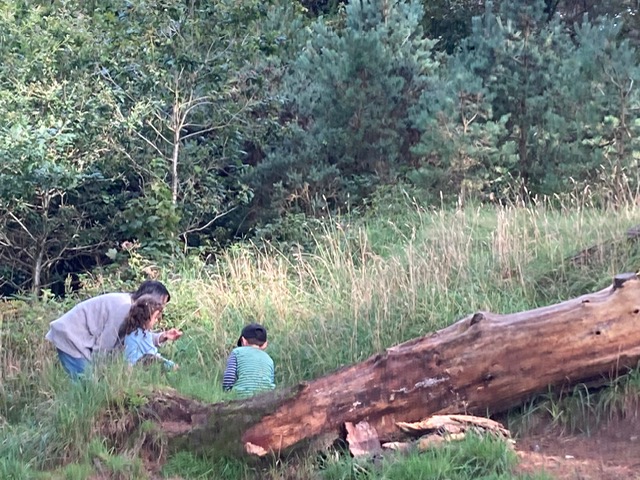
The last half of the activity was to name a place or natural object by pairs. They observed using all senses, recognised its uniquenes, considered the appropriate words to describe the object, discussed with each other, and tried writing the name in a paper with some help from the teachers. In Forest School, there are “No Right or Wrong” so that the children are able to express themselves freely, which may give them more confidence in their own senses and decision making.
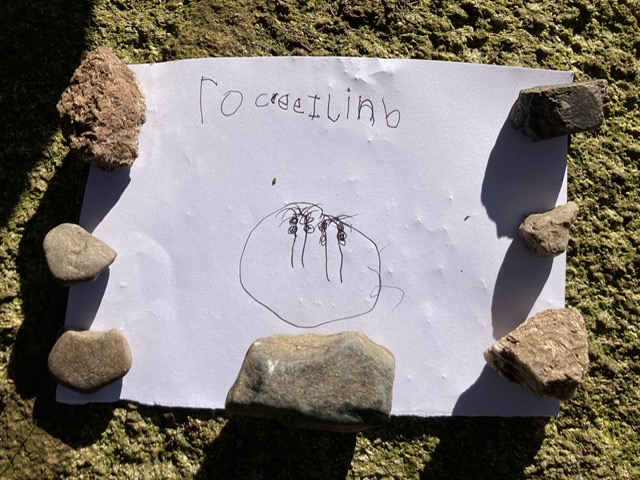
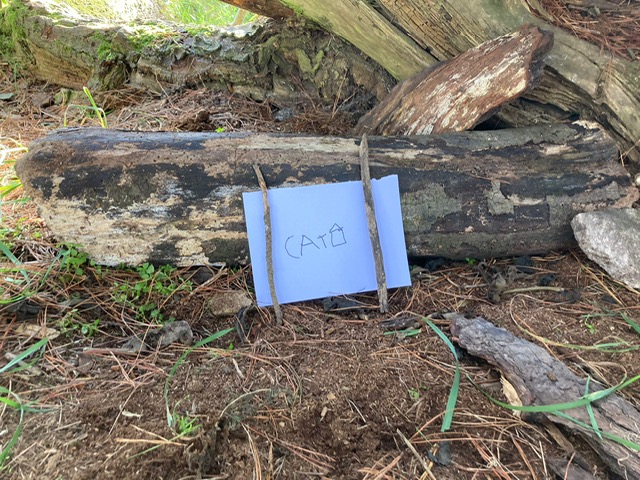
Then it was a time for a “sit spot”; everyone sat, leant back on a tree trunk or lay down at any place they liked, and was just being with the nature – watching trees swaying, leaves falling, and clouds moving, listening to the birds singing, feeling the wind blowing on their cheeks or the warmth of sunshine. A quiet time in the forest gives children an opportunity for meditation, a distance from everyday life or any pressures or stress they might be feeling, and a spiritual experience to feel a natural world larger than the human world. Knowing this method may give them mental resilience in the future, when they have anxiety or any inner problems.
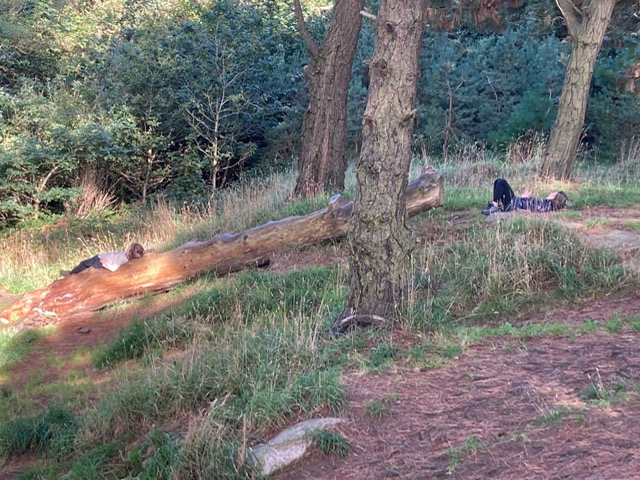
At the end of the session, we shared what we had noticed during the sit spot, and we also shared what we were grateful for from today’s Forest School session. It is a great experience for them to share the things they have noticed and their feelings within a group, which can give them a sense of unity, and they can learn to express themselves, to listen to others, to know other people’s perspectives and to respect each other.
In this way, Forest School gives the children opportunities for holistic growth (physical, emotional, intellectual, social, cultural and spritural), the development of their emotional intelligence, risk management skills, and mental resilience, while giving them precious memories.
Today’s session was to meet the grandmother tree in the basecamp. At the beginning, we talked about our own grandmothers. What is she like? Is she kind, wise, always cares about you, always gives you treats, or may tell you when you are not behaving well? Or perhaps some have never met their grandmothers, but only heard of them. Usually, grandmothers have a lot of life experience, and have witnessed changes through time. Trees live much longer than us, so that the grandmother tree must have lived for a long long time in the forest.
We collected some presents such as cones, leaves, sticks or berries to the grandmother tree on our way to the basecamp.
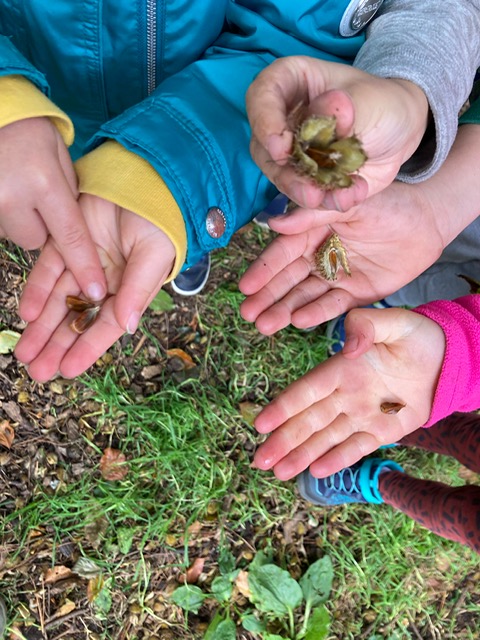
It was a windy day, and everyone noticed that there were more fallen leaves than the previous week. The Rainbow tree, a huge horse chestnut tree, had also turned its leaves more yellowy, shed more leaves, and dropped more conkers on the ground.
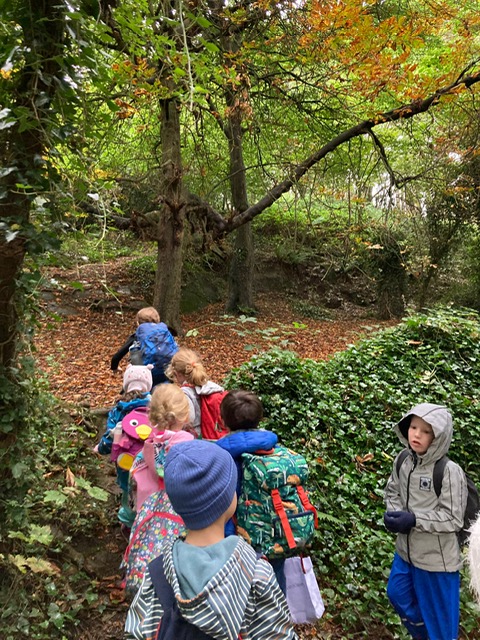
The grandmother tree in our basecamp looked very old and shrinking, but was still alive with some leaves on it. We looked at its roots spreading over, supporting other young trees and noticed that its branches bent and connected with an adjacent tree. The children had a look at it, and called it the grandfather tree.
The children touched them and gave them presents they’d collected. Then they started to expand their imaginary world around the grandmother and grandfather trees.
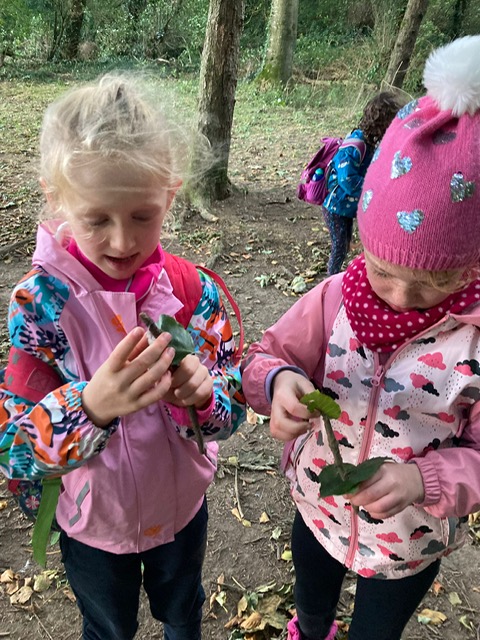
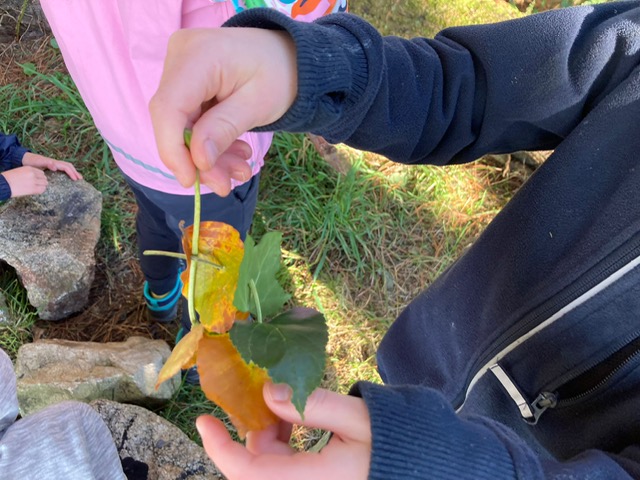
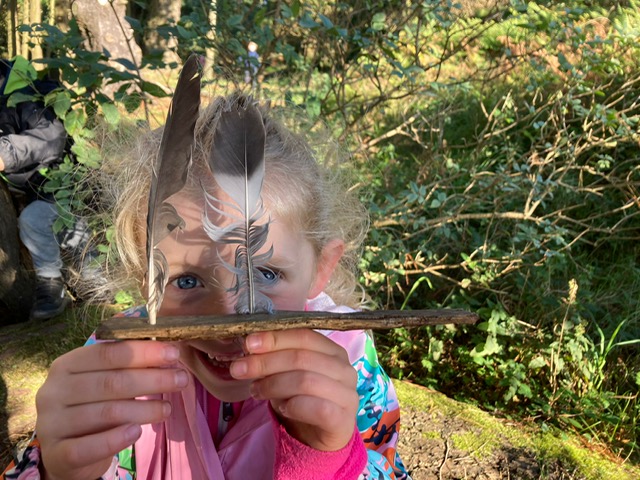
Some of them started to make a little dining room for the grandfather tree using fallen branches and leaves. They made tables, chairs, plates and put blackberries for him. Then they started to collect more food from other places in the boundary, and eventually they spread out within the boundary.
The children who enjoyed digging holes last week found the same hole again, and started to make it bigger and deeper. Then one of them noticed that the ground was covered by dead wood. He found an enormous piece of tree bark which had become so soft and fragile that it was easy to break down into small powdery pieces. Here they learnt that the dead trees become a part of the soil, and support other life in the forest.
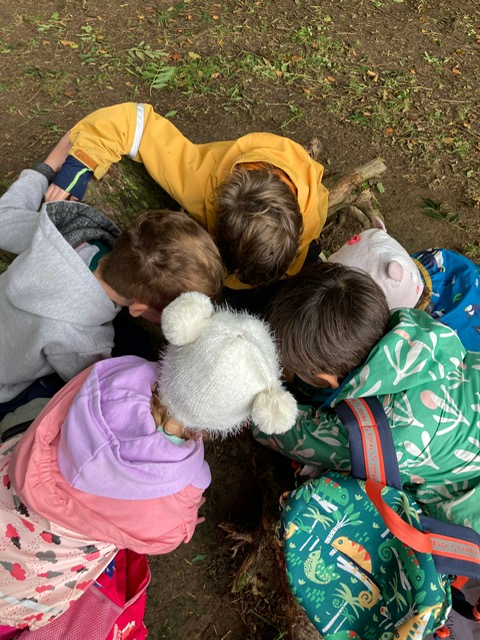
Others found a very fun game, which was to catch falling pine leaves. As it was a very windy day, so many pine leaves were falling so quickly. One of the children kept trying until he finally caught one. Because it was not easy, it brought him huge satisfaction, and joy accomplishing his challenge.
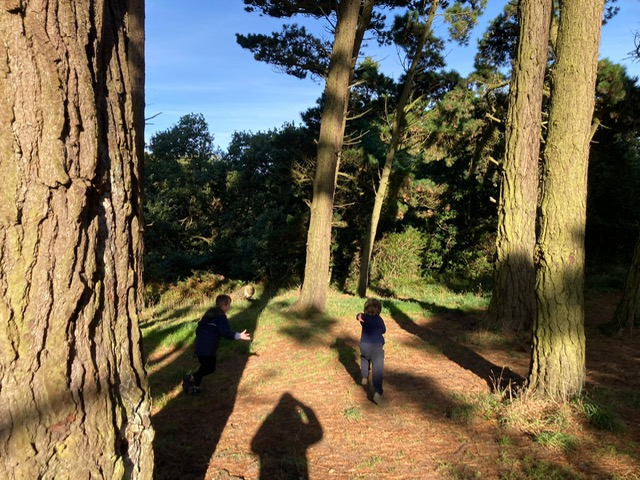
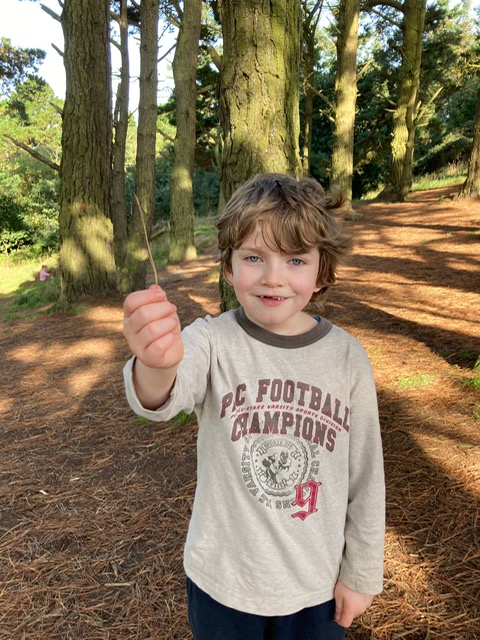
All the children were so engaged with their own activities that there was no need for the teacher to introduce new games or activities. (Learning how not to “adult-erate” play is an important skill for a forest school leader!) Some love physical challenges, or hanging around with their friends, some prefer more delicate play, such as making fairy houses, some enjoyed group work such as making a fort, and some liked drawing and writing letters. They often shared what they found interesting, interacted with each other and learnt fun and new things from each other.
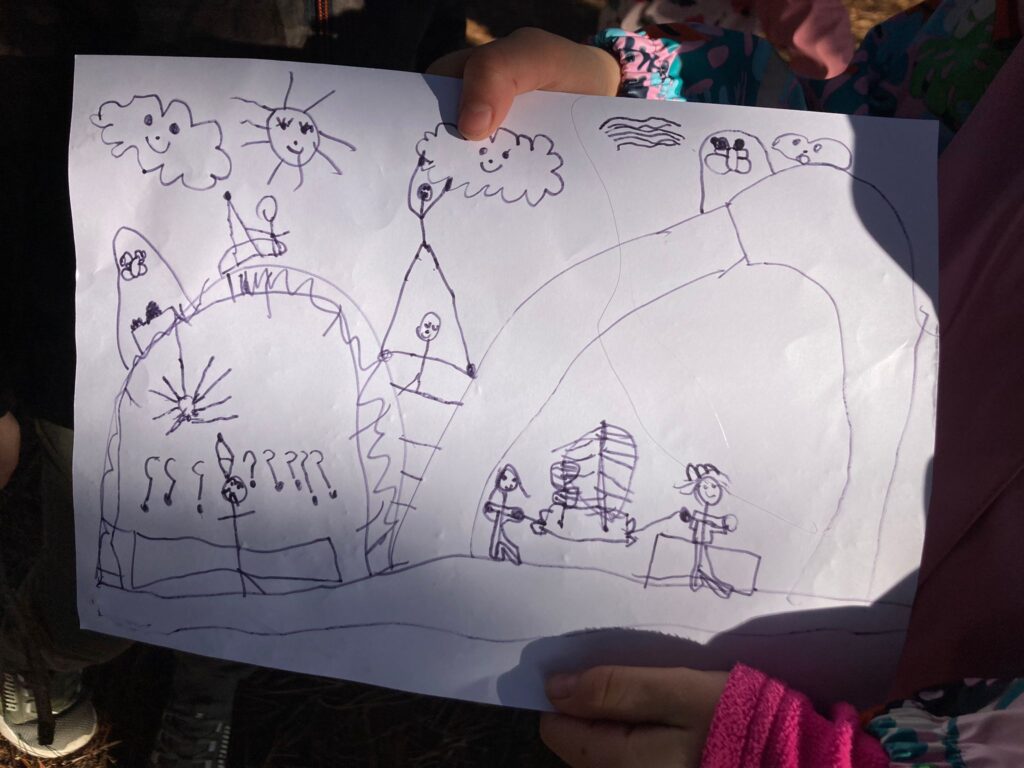
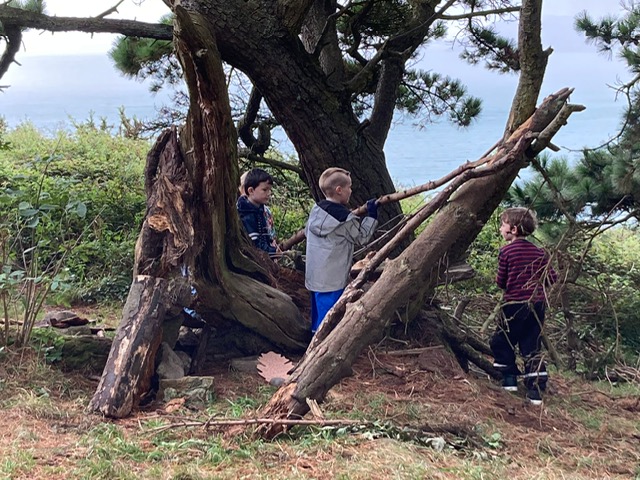
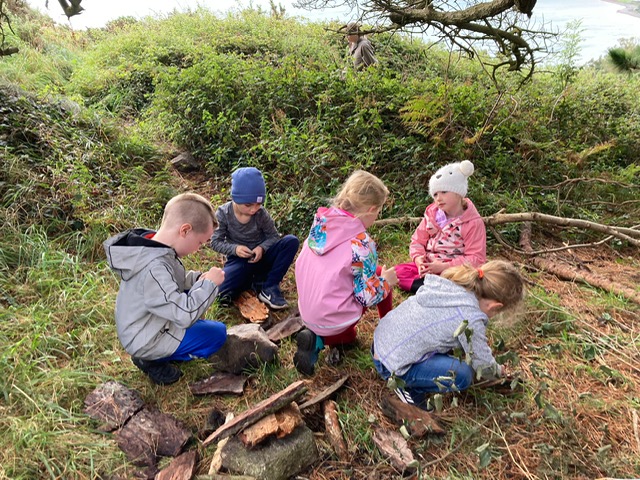
At a break, we talked more about our grandmother and the free play continued until the time for the sit spot. The children lay down wherever they liked and looked at the windy sky, where the trees were moving in such a lively way. We shared what we found during the sit spot, and what they were grateful for from today’s forest school session. We said good bye to the grandmother tree, and left her behind in the forest.
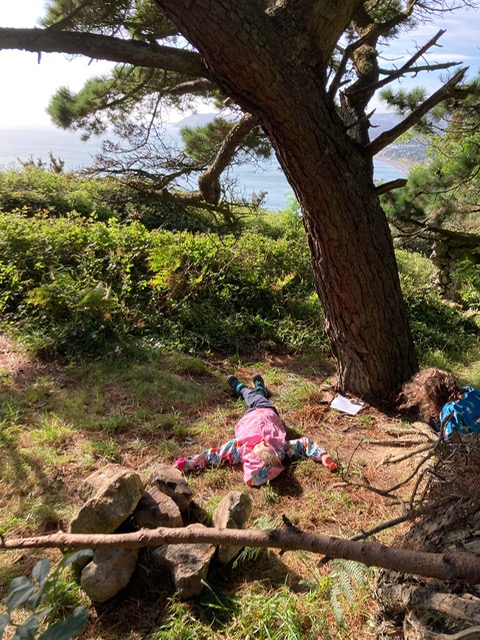
Today, we went back to the grandmother tree, and we found a letter and presents from her!
In the letter, she thanked the children for all the presents they had given to her, and wrote that she loved watching everyone playing in the forest and also felt lonely after everyone had left. So she collected the presents – berries and conkers from the forest and asked the children to make some little creatures to play with her and to take home.
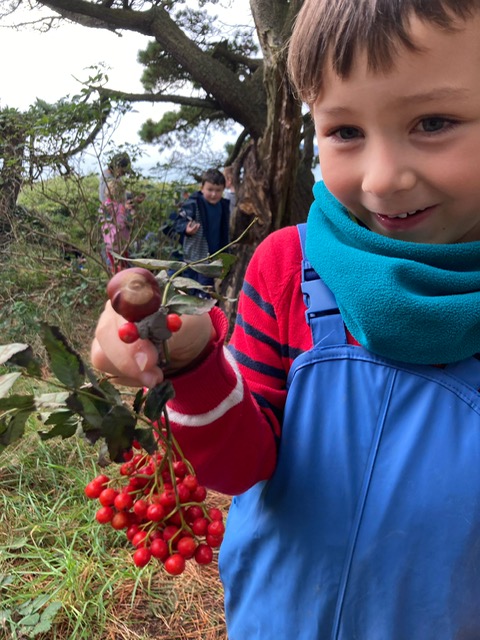
The eyes of everyone were shining with excitement when the teacher was reading the letter, and also puzzled to wonder how it could be possible. The forest became a magical forest and the children loved it.
They started to make little creatures using the natural clay and sticks, leaves, berries and acorns from the presents from the grandmother tree and something they found in the forest.
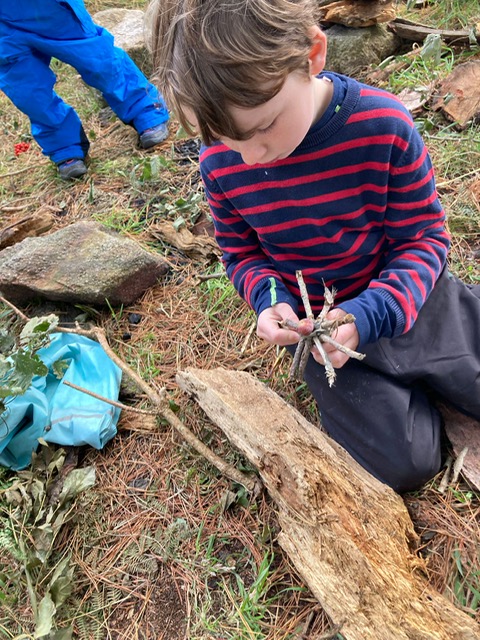
They made many creative, imaginative and unique creatures such as a dog, a fairy door, a spiky creature, a smiley face, and a forest fish etc. One of the children was so concentrated on making a creature, and was taking a long time to put many sticks on clay like a lion’s mane. Finally, he combined it with a body part which was also made with clay. However, he struggled to make it stand with four legs using sticks. He was so desperate to make it stand, that he pulled all the sticks out from the head part, and concentrated on figuring out how to make it stand.
It showed that the process is far more important than the outcome when children play, and when they are learning something by themselves. In the Forest School, the children are not judged as long as they keep the Golden Rules. Therefore, they don’t have to feel any pressure not to make mistakes, rather, they are encouraged to learn from their own trial and error.
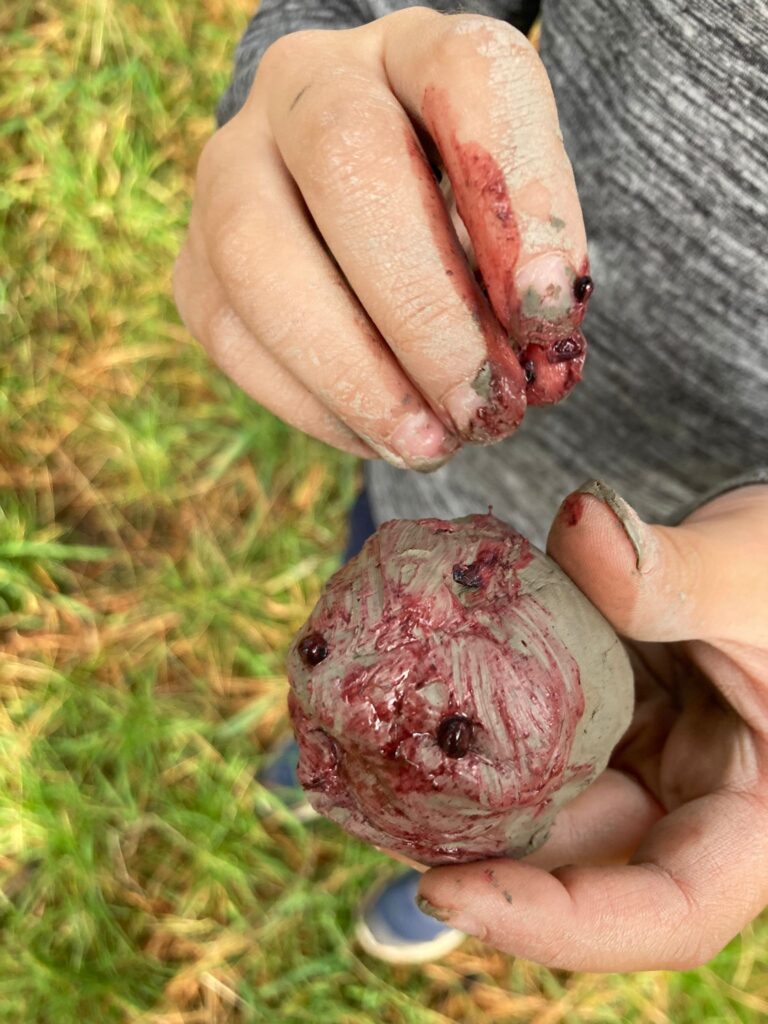
Some of them found a baby oak tree near the grandmother tree, and they started to make a table and dishes with blackberries on top of it. They gave the nettle tea to the baby oak tree, and talked to it in a nicest and softest way.
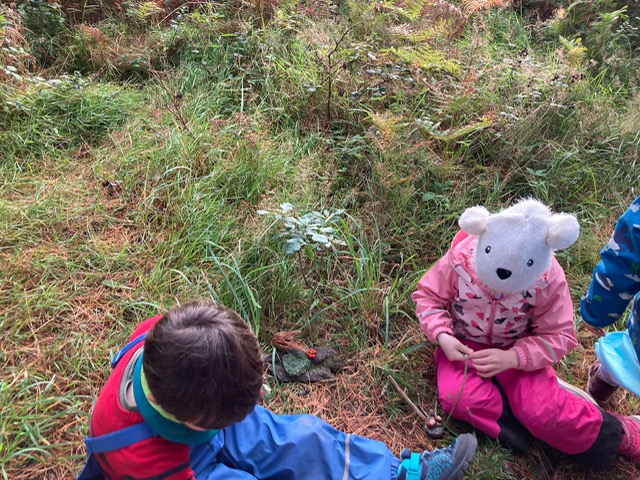
Some of them wanted to write a letter to the grandmother tree, saying “I love you grandmother”. Some drew pictures, some tried writing using symbols, and some tried spelling.
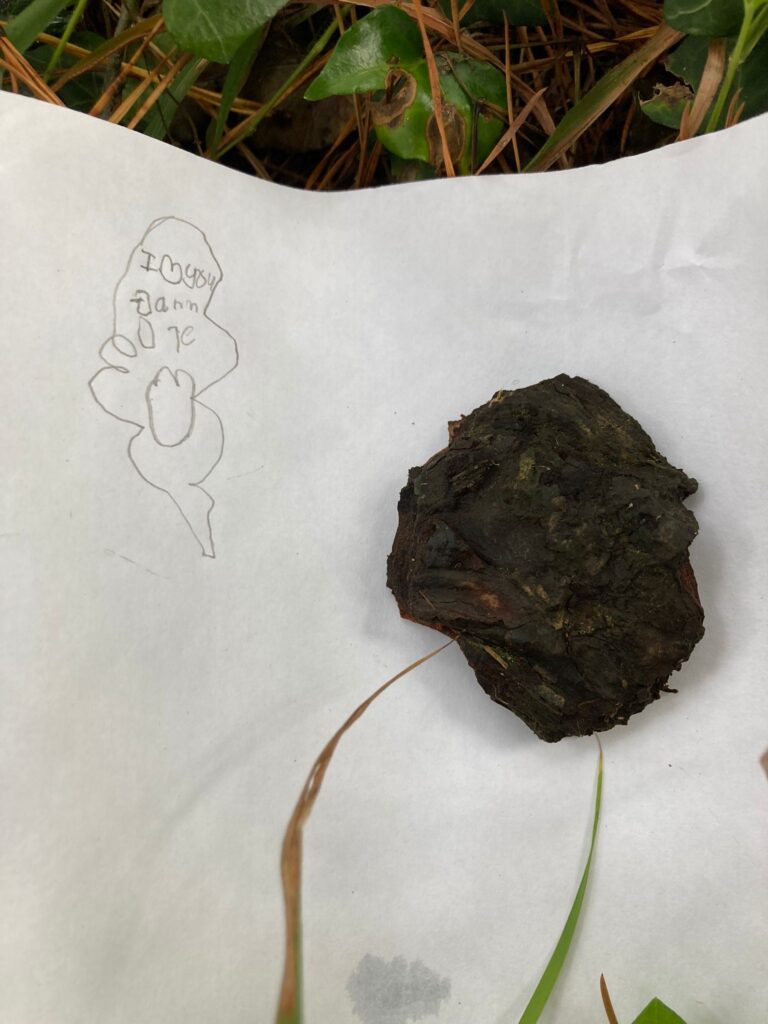
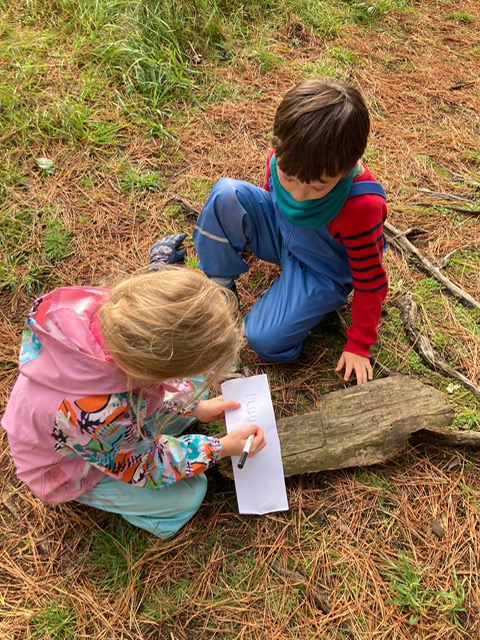
The teacher suggested to write a letter to the grandmother from everyone at a break time, and it went like this;
“To Grandmother Tree
We loved your presents. Thank you so much for your presents. We love to play with you. We hope you had a lovely time with us. We will be here every week
What do yo do when we’ve gone?
What age are you?
Do you like our presents?
How did you get the presents you gave us on your trunk table?
Do you have any friends? We can be your friends if you want!
Where did you get this card from?
From most of Senior Infants”
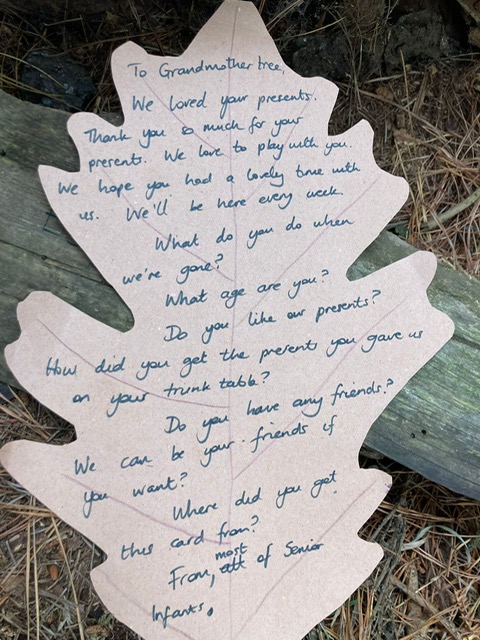
The letter was left on the trunk table of the grandmother tree. Then the teacher talked about how our breath was connected to trees – we take in oxygen when we breathe in, which are released by the trees, and produce carbon dioxide when we breathe out, which trees take in. By breathing, we felt the forest more closely, and realised that we are connected to each other all the time.
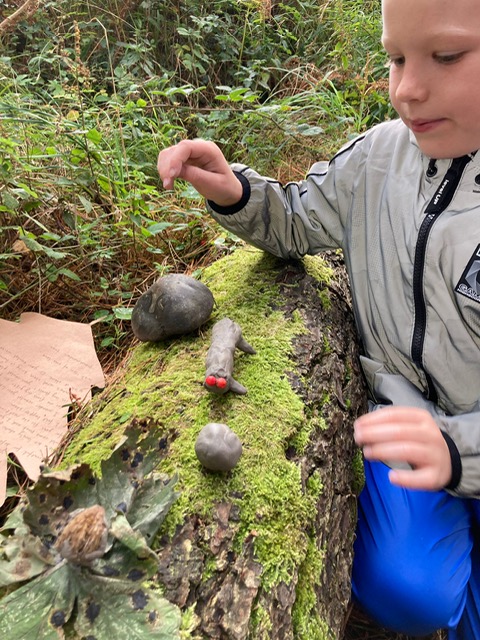
There was more free play until the time for a sit spot, and when we gathered again, we talked about what we noticed during the sit spot and what we found grateful for. It seemed that the children felt the grandmother tree more closely through this session.
One of the reasons why the forest school is beneficial in the school might be because the teachers know the children’s learning stages well. The children are learning writing, reading, mathematics, science, or critical thinking in their classroom. They can apply it in a practical way in the Forest School. For example, they may write letters, observe their surroundings or inner emotions and put them into words to share in the group, use appropriate words when they are working together, or apply their knowledge of science for making something work.
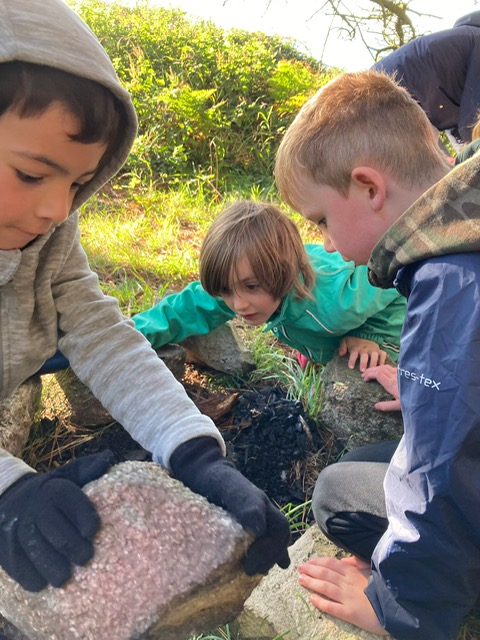
In the classroom, the teachers can use the curiosity and findings and skills which the children gain in the Forest School. Also, the teachers may also see the children’s different characters, hidden talents, or personality deeper, and it might help enhance their learning better. Foremost, the forest may bring learning to the children, which teachers have never thought about, and which give the teachers new discoveries.
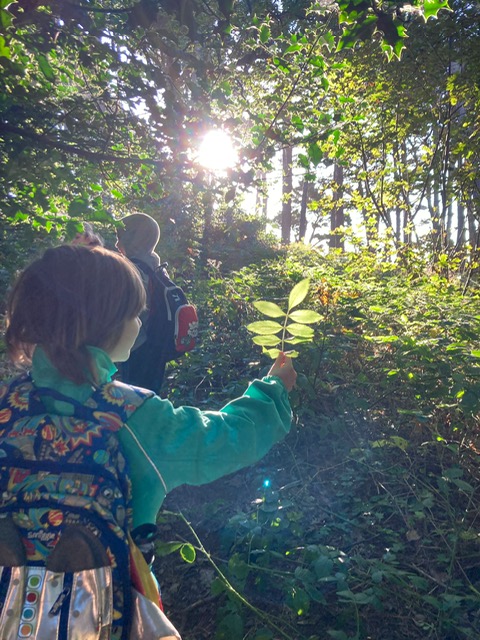
Today was a mild day with a grey sky, and sometimes the warm sunshine came through the trees. To start with we played a game of bat and moth.
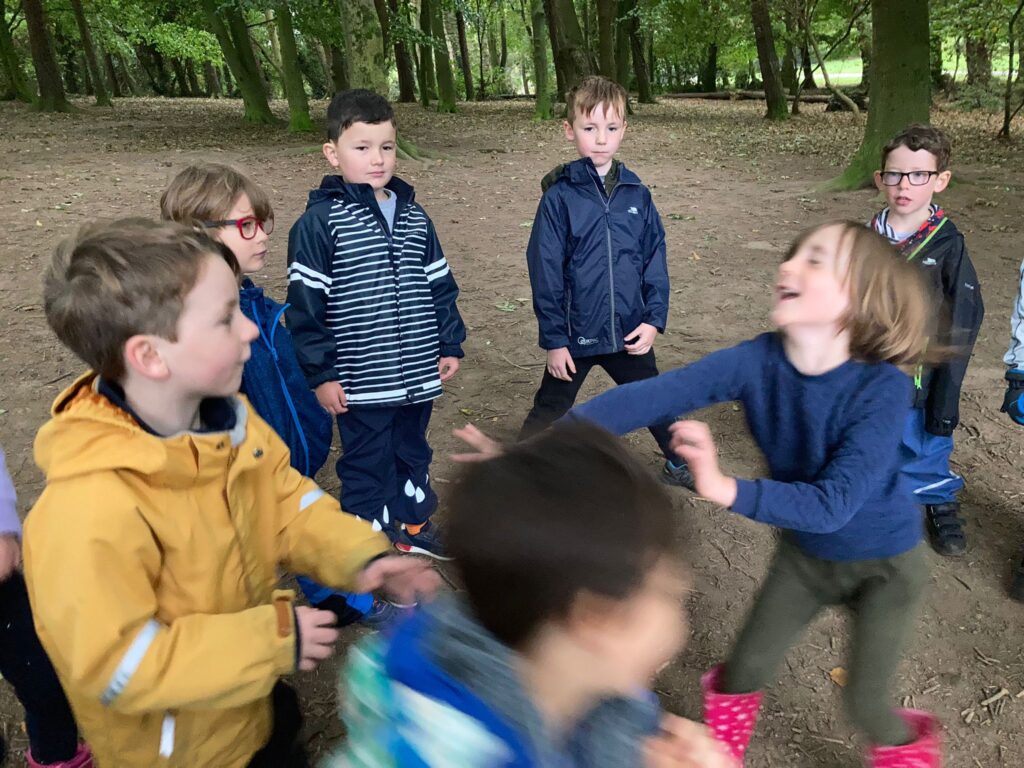
On our way to the basecamp, we followed a leader in turn, who counted the given footsteps and found something interesting. They already had good eyes for finding interesting things in the forest, such as sticks which looked like a letter of “H”, bird toes and deer horns or the hairs on the edge of the beech leaves. Some children remembered what the leaves of ash trees looked like, which we talked about in the previous week.
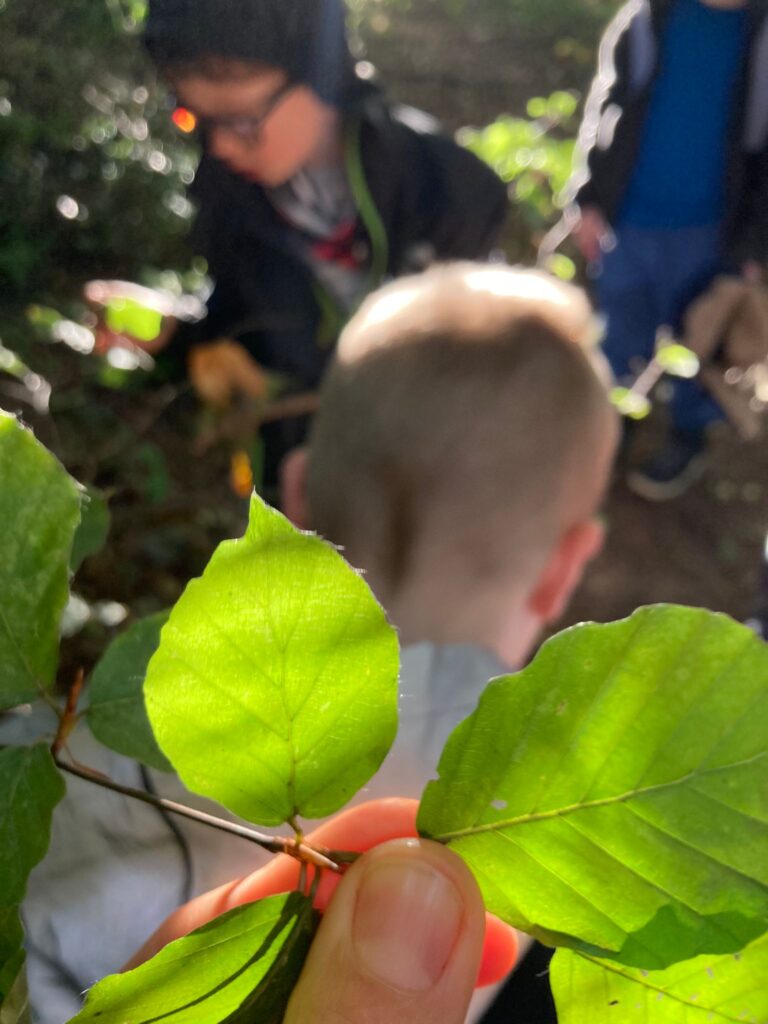
At the Rainbow tree, the children found so many fallen leaves, which covered the ground like a carpet. First, they started to play scooping with their feet and sticks, then eventually started to use their hands and whole body to collect the leaves and threw them into the sky. “Like fireworks!” Someone shouted, and everyone became wild under the Rainbow tree. Someone called the place “a leaf pit”.
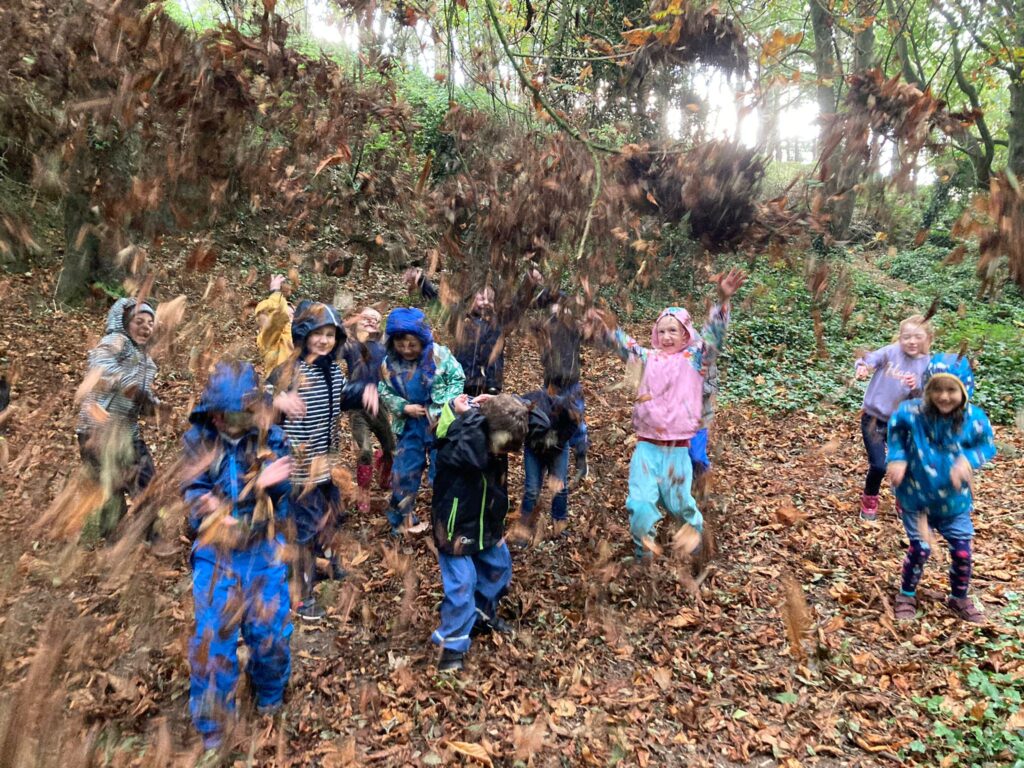
Some children gathered the leaves and made a big pile of the leaves which was named as a “jumping castle of leaves. ” One of the children kept scooping the leaves. Some children enjoyed throwing the leaves into the air together. One of the children started a business where everyone had to pay a leaf coin to jump on the pile of leaves.
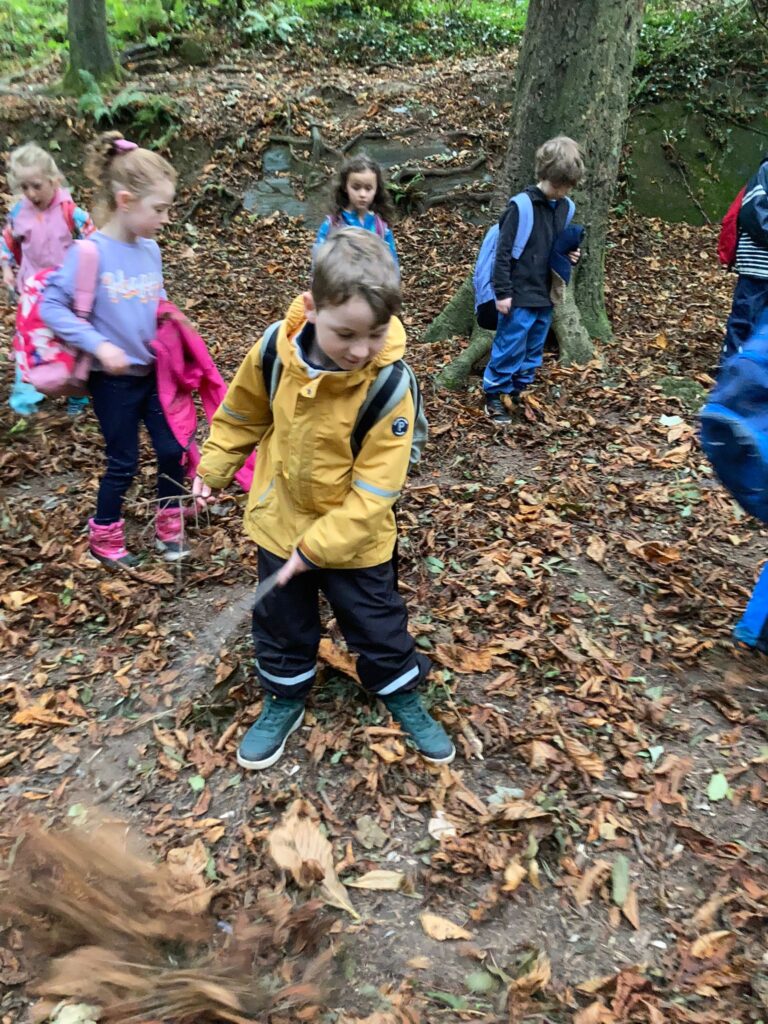
Playing with fallen leaves is one of the best things children can do at this time of the year. They use all their senses and whole body, feeling the crunchiness of leaves in their hands and feet, lying down in the leaf piles, gathering as many leaves as possible.
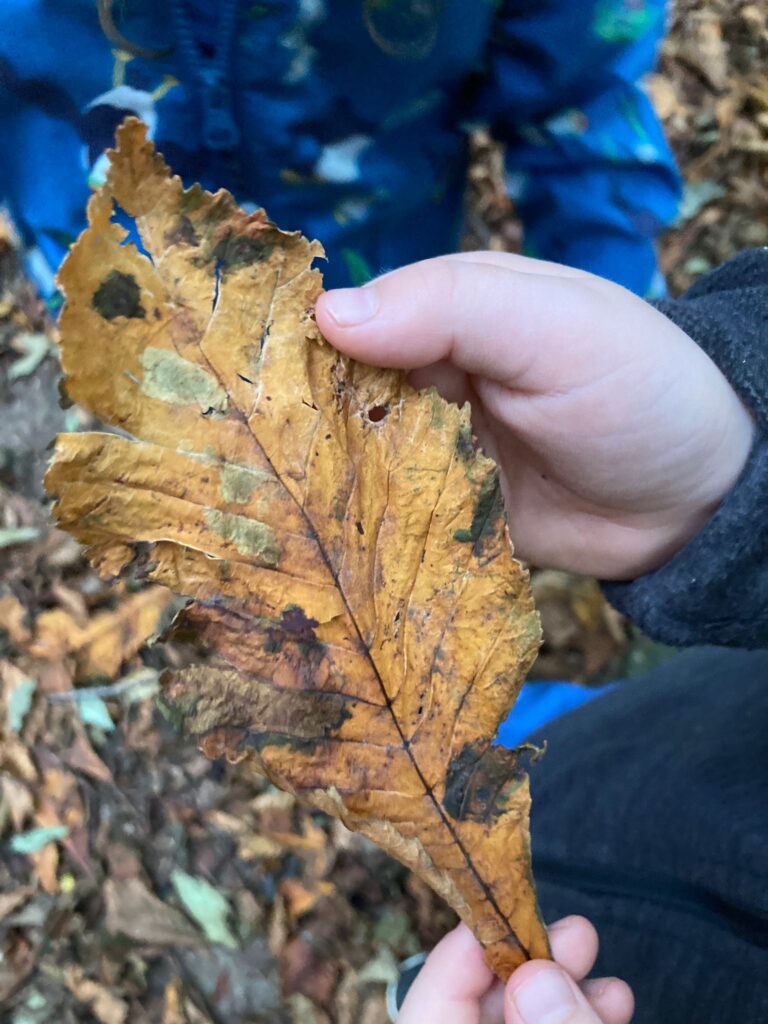
We also found some signs of creatures at the leaf pit. One of the children found a spider crawling out from underneath the leaves, and another found a leaf with birds’ poop on it.
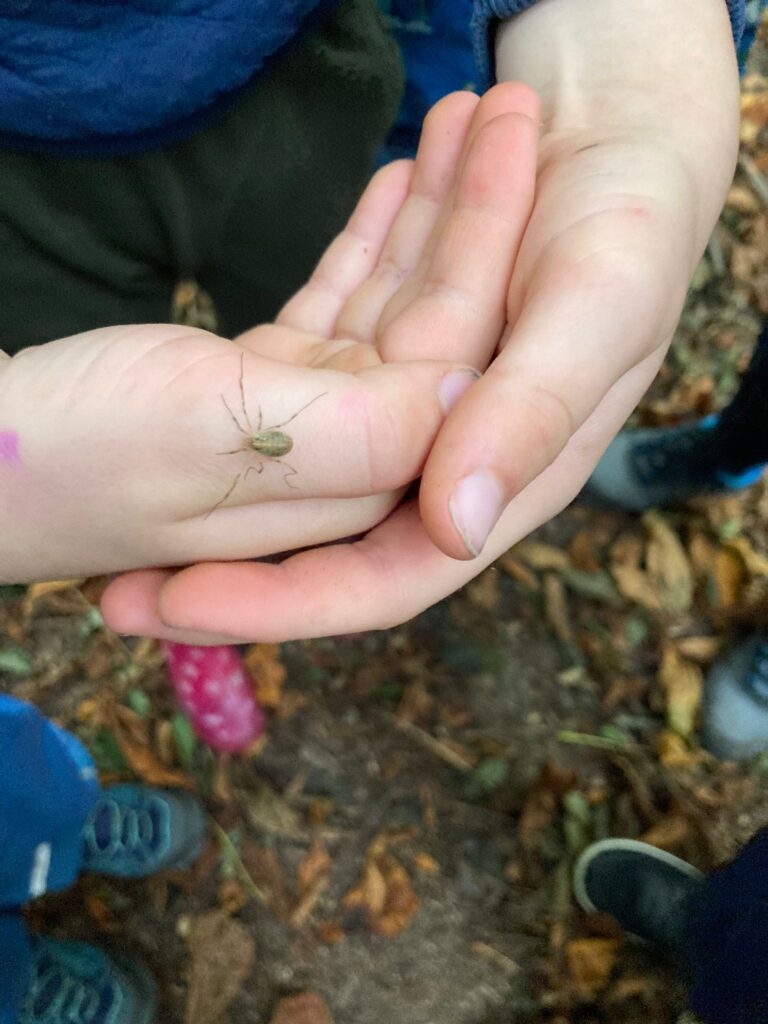
Then we moved to the grandmother’s tree, and found a letter back from her. In the letter, she answered the questions which the children asked her in the previous letter. For example, to the question “how old are you?”, she answered that “I have lived so long, longer than your great grandparents”, which made the children think about the length of time the trees could live.
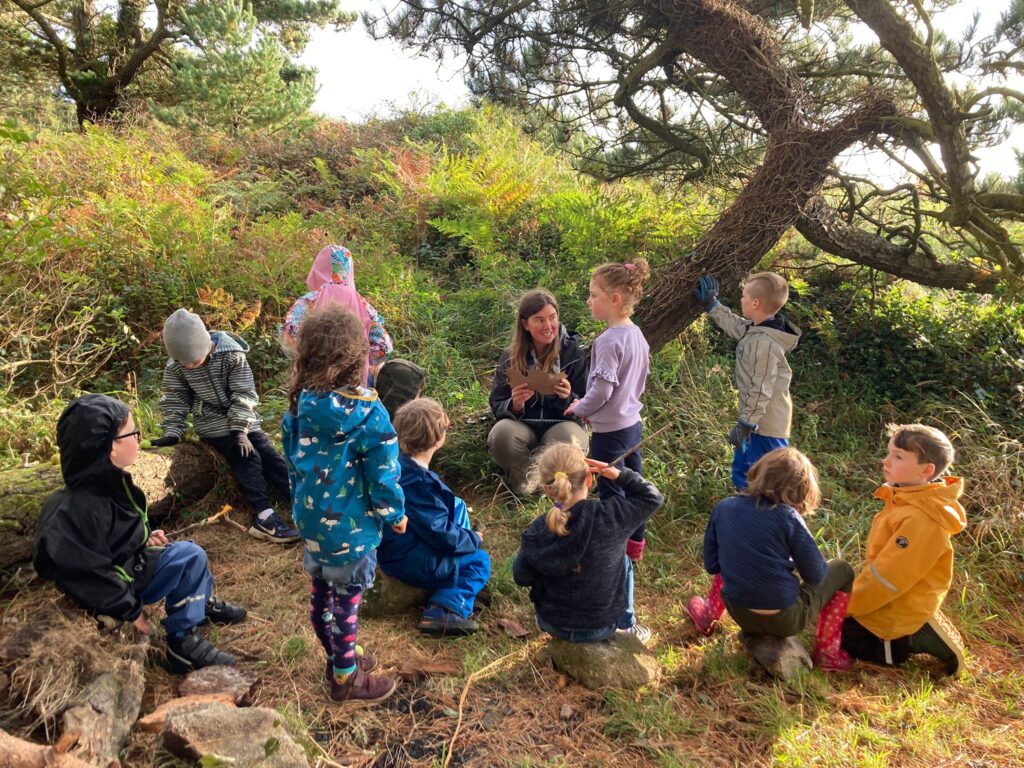
Then to the questions “do you have any friends?” and “how did you write the letter?”, she answered that “I have many friends in the forest, do you know who they are?” which made the children imagine what kinds of creatures might live around her. They thought about the small insects, fungi, animals and other plants which might have helped the grandmother tree writing the letter. Also the grandmother tree gave apples as presents, which we enjoyed eating later on.
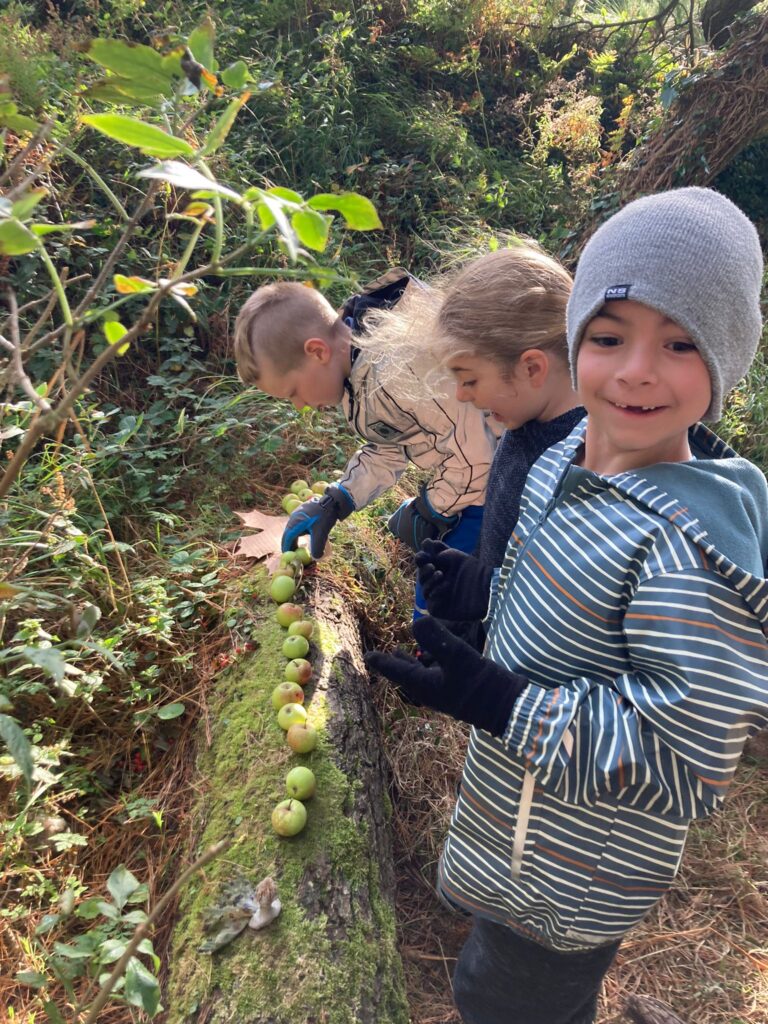
During the free play, the children who enjoyed digging the forest ground in the previous week went digging again. This time, they found living roots extending from distant trees which were an unusual colour. They had to stop digging then, so that they didn’t damage the roots. Each week, they found something new by digging, and they now have a better understanding of what was underneath the ground.
The child who liked catching the leaves in the previous week wanted to find another physical challenge. He wandered around, and started to throw the blackberries and tried to find where it went. It was a simple game, but another child joined in. These two children always liked to play together, and play seemed to be their communication tool.
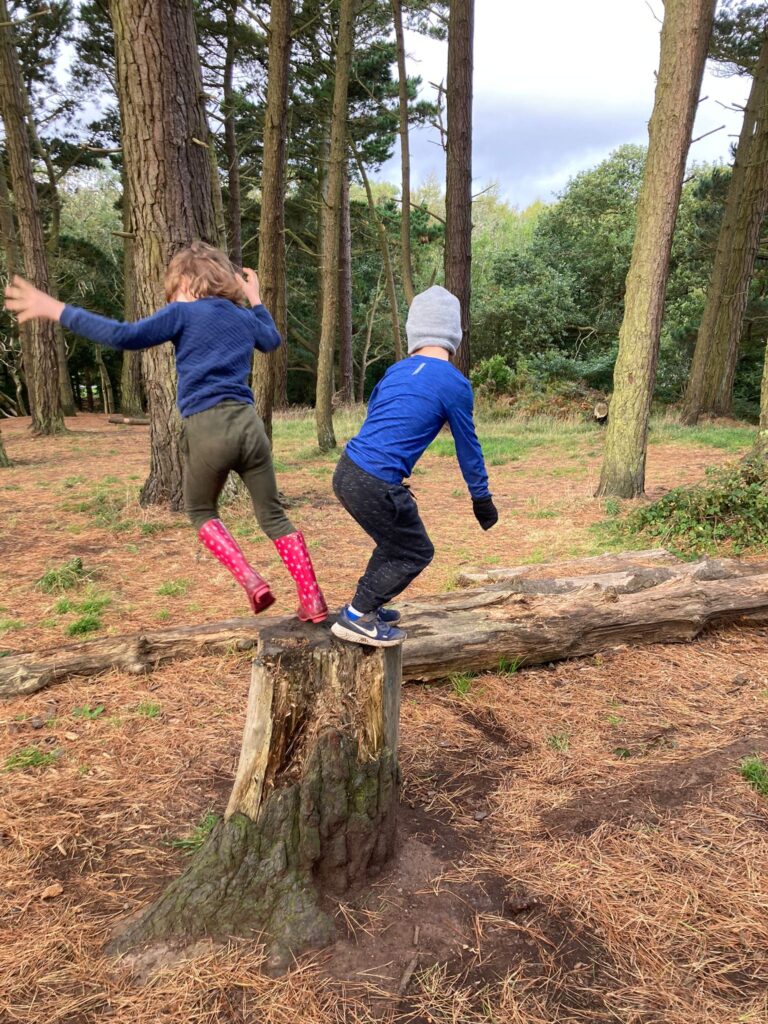
Five to seven children were working very hard on making a tree hut, which was named “the tree den”. They demonstrated great team work. Some of them were making a roof by putting tree barks and twigs on. One of them found a pile of soil with thin roots entwined, and put it on the gap of the roof like cement.
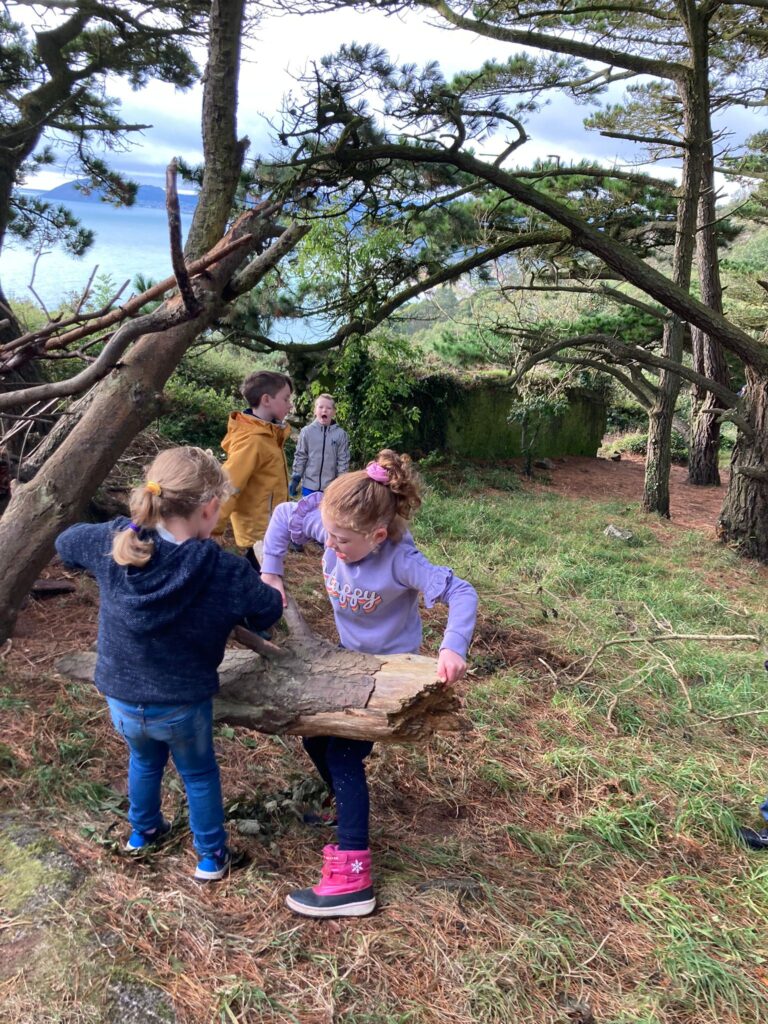
One of the children found a stick which looked like a hammer, and he started to tap the roof of the tree den with it. Then another child started to copy what he was doing, and they did it for the rest of the day, saying “I am checking if the roof is stable!”. The children copied each other, talked to each other, communicated in a constructive way, solved problems and found something fun together.
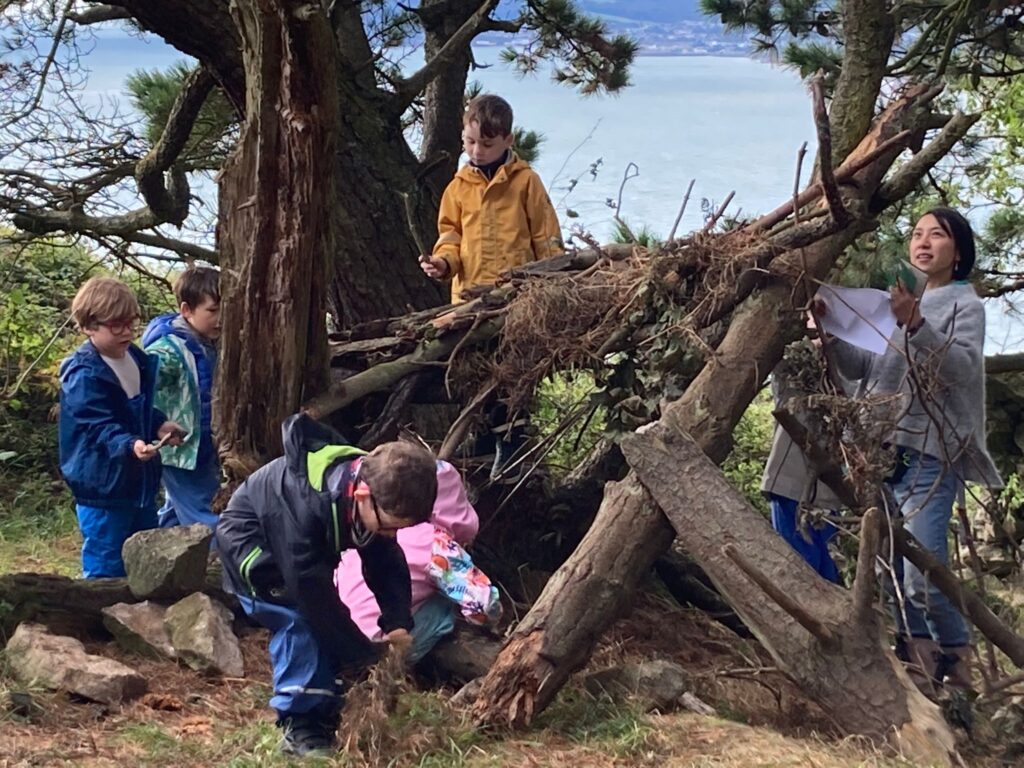
Meanwhile one child was building fairy place.
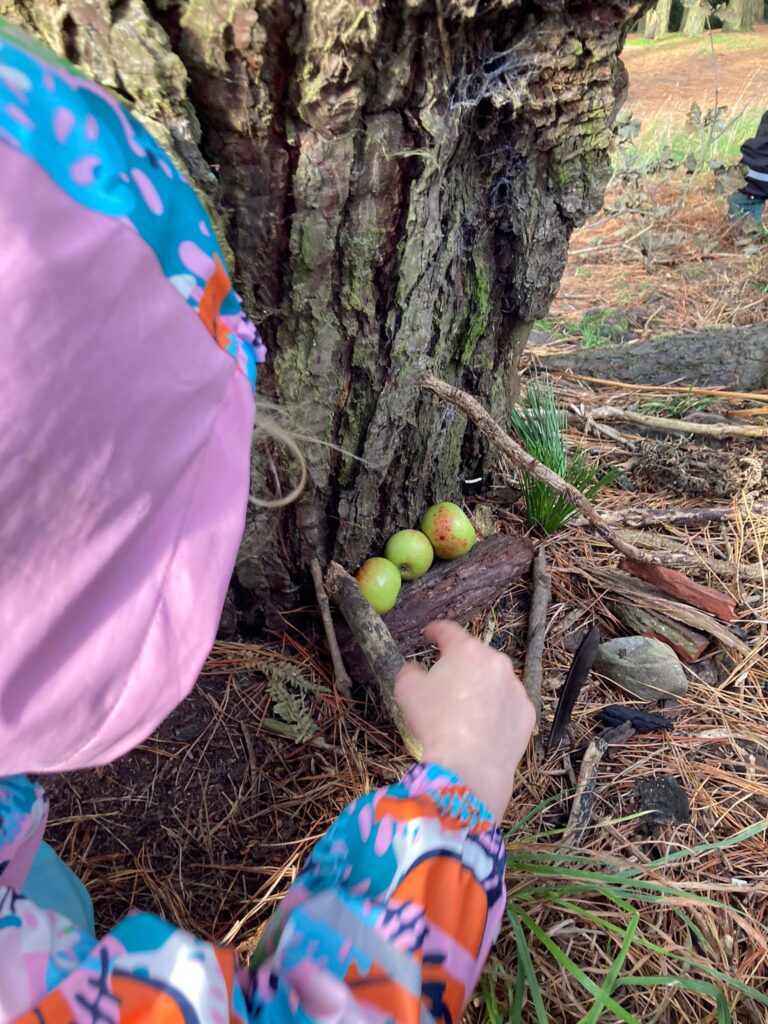
Another was writing a card to grandmother and grandfather tree.
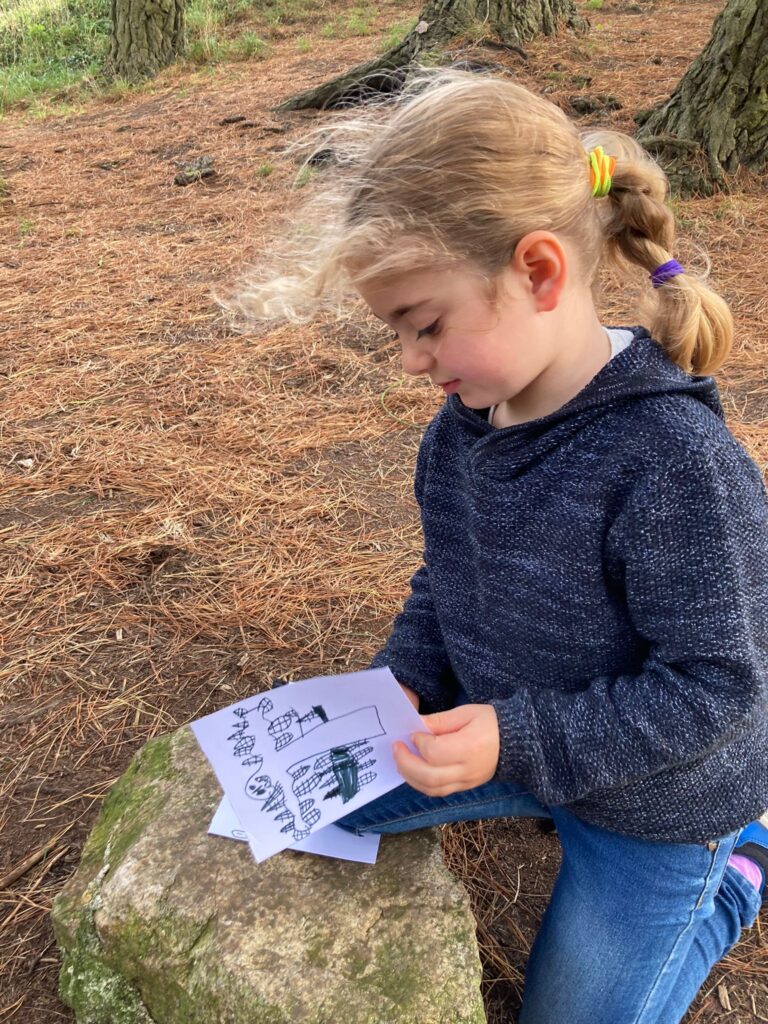
Another couple of children found a beautiful beetle.
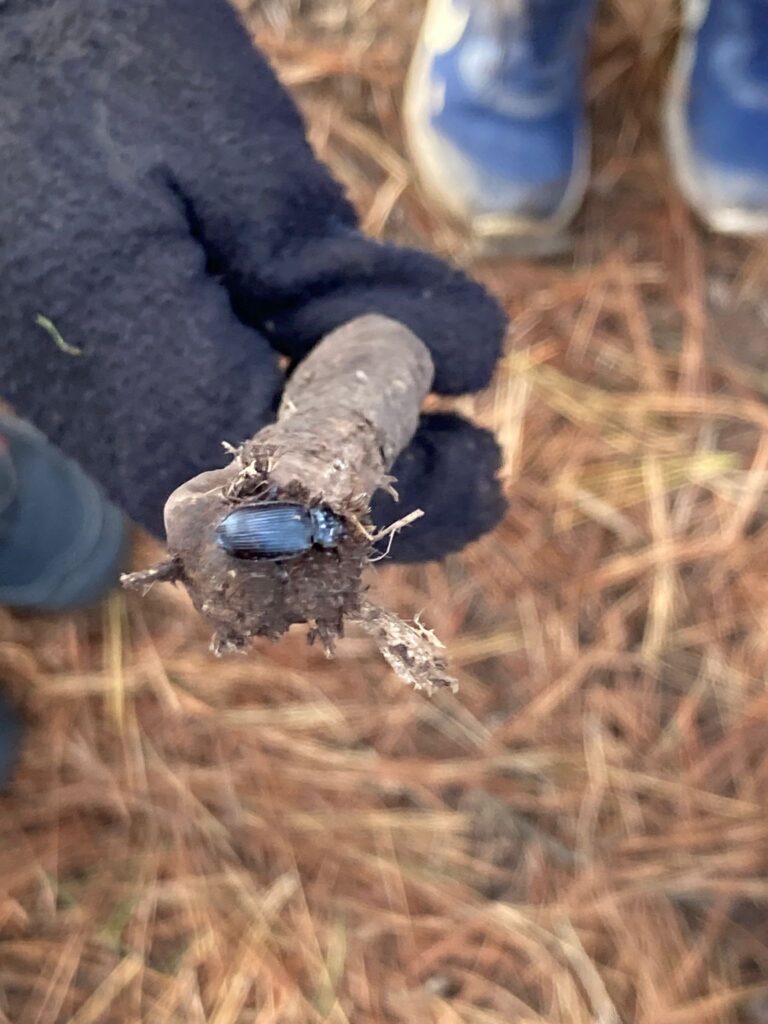
Another few played/invented a skipping game with a coat as the rope. One of the core skills we are aiming to develop is resilience and every chance the children get to learn and realise that everything they need is here and to be creative and resourceful helps them know that they can problem solve in other parts of their lives. No rope. No problem.
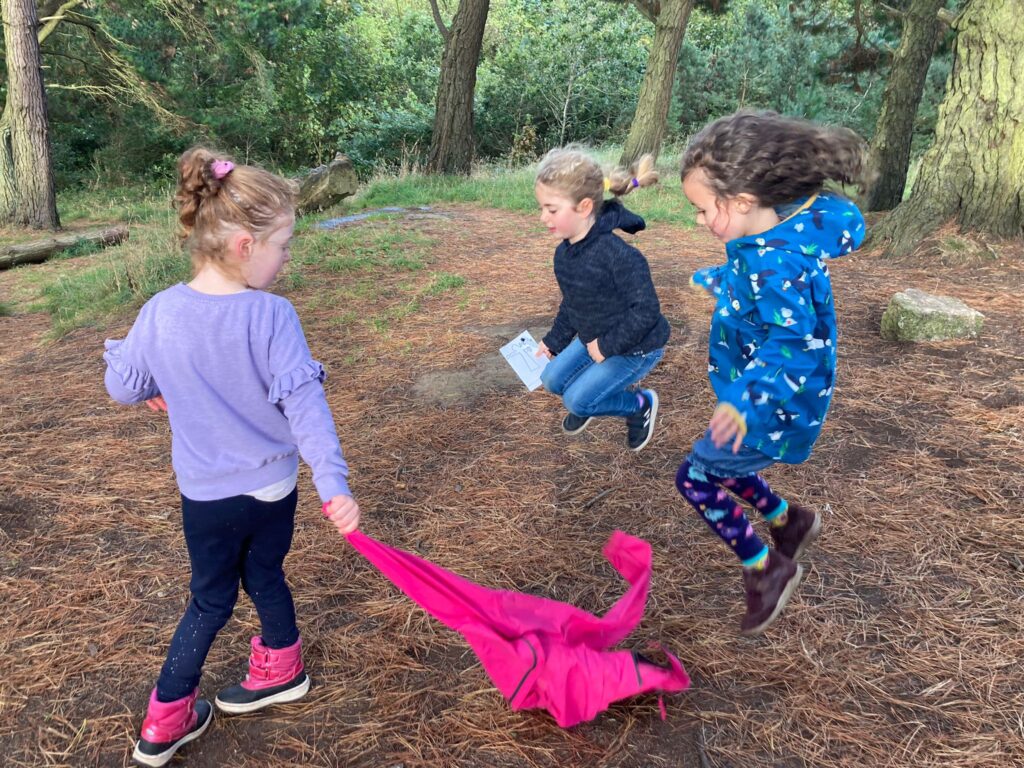
All of these demonstrated the meaning of having Forest School for a group of children. The children can learn from each other, and every child has a chance to be a leader within the group.
At lunch time, it was time for a story telling. The teacher told the “Apple Tree Fairy story”, by which the children thought about how apples grow from a seed, and they found a star-shape in each apple. We enjoyed eating apples and tasting the apple tea. We had a sit spot in the end and shared what we noticed during the sit spot and what they were grateful for from forest school. One of the children said “I am grateful for everything in the Forest School!”, and many followed “me too!”
Today was a cloudy, and mild day. In the beginning, the children enjoyed a game called “egg, caterpillar and butterfly”, which was a great game for team discussions, negotiations and developing quick thinking.
On the way to the basecamp, they remembered the “leaf pit” at the Rainbow Tree where they played in the previous week, and wanted to go back there. As there were even more fallen leaves, all the children were happy to stay there before going to their usual basecamp.
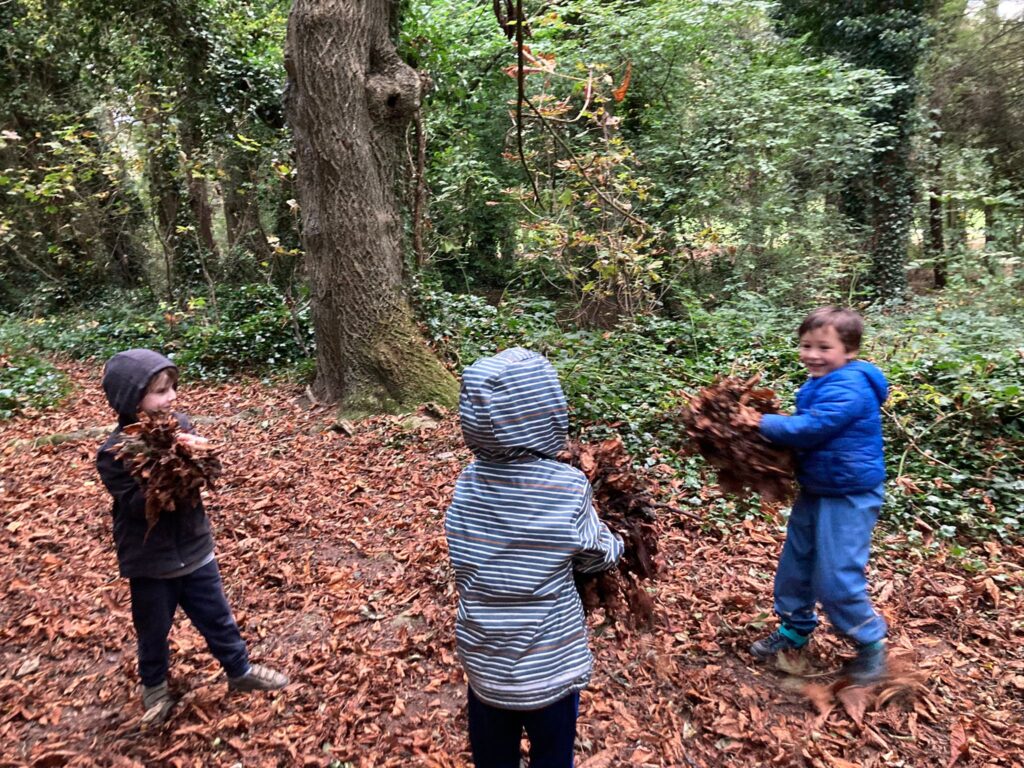
At the leaf pit, the children invented a new game, a more challenging one. They collected the fallen leaves and made a pile of leaves under the rocky hill, made a line and jumped into the leaf piles one by one. This game was called “the leaf explosion”, and the waiting system was made naturally by the children.
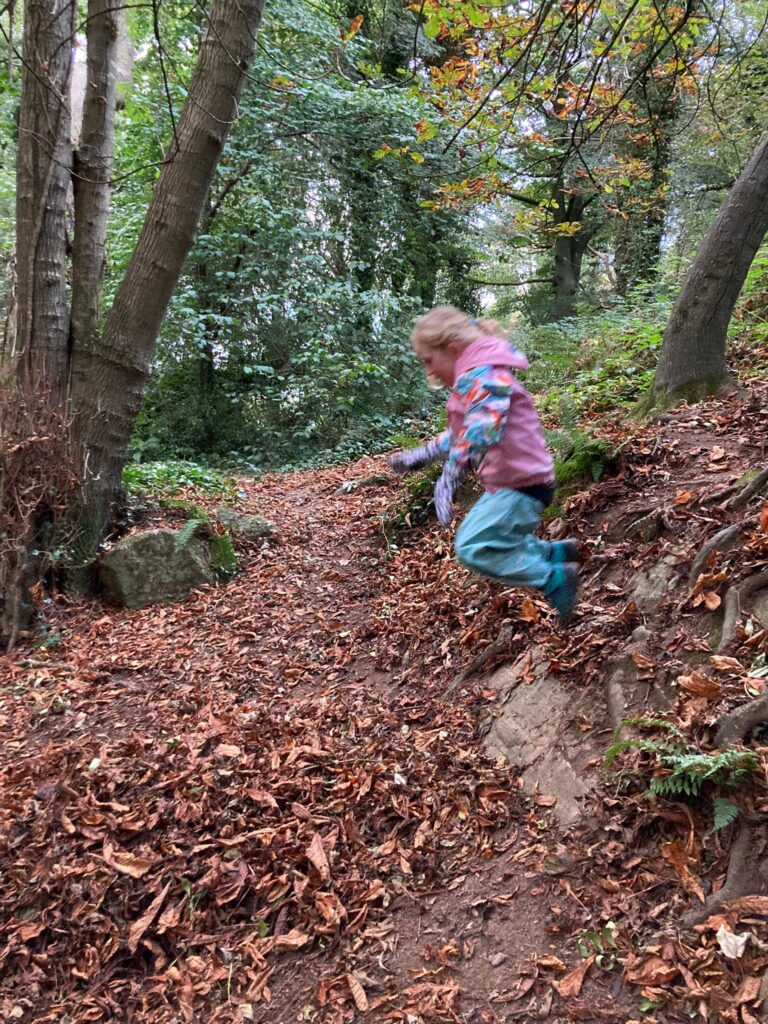
There were differences in the physical abilities and confidence level among the children, and each child tried in different ways based on their own judgments. For example, a child who had more confidence jumped from a higher place, and another child who had less confidence found a good foot point at the lower place and jumped gently onto the pile of leaves. They have to find their own solution not to hurt themselves. A child hurt his bottom the first time he tried. He was upset for a while, and soon his friends came to comfort him. After a while, he started to try again, jumping from a lower place to make sure his posture of landing was safe enough. He seemed to have more confidence in his own judgment.
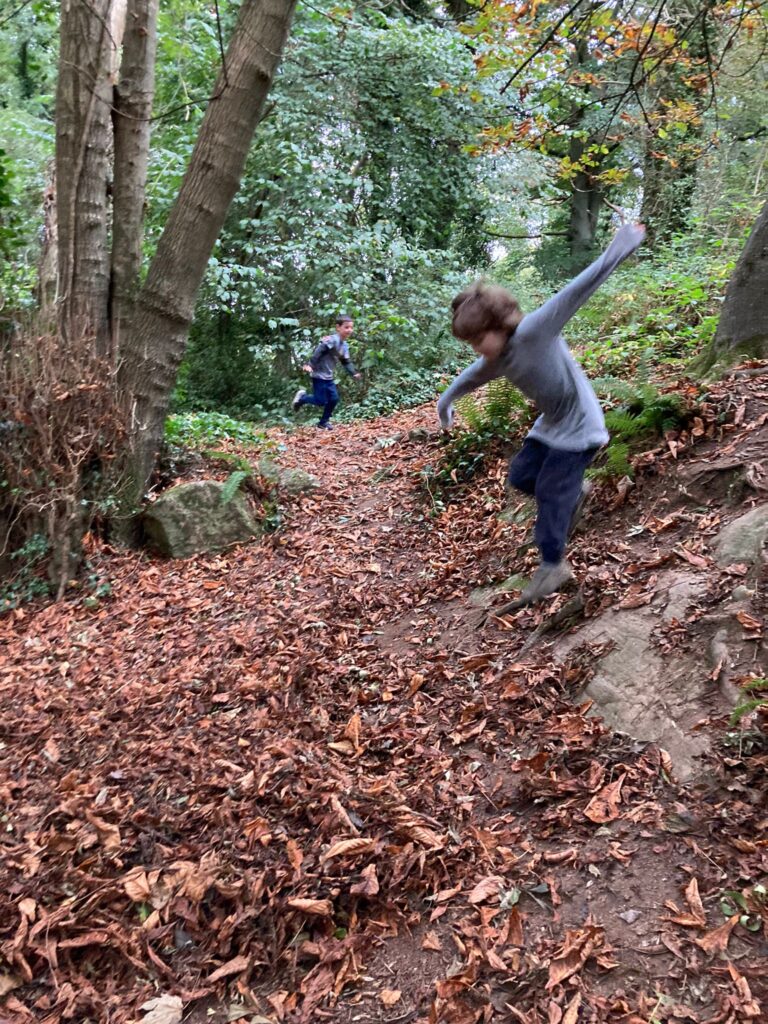
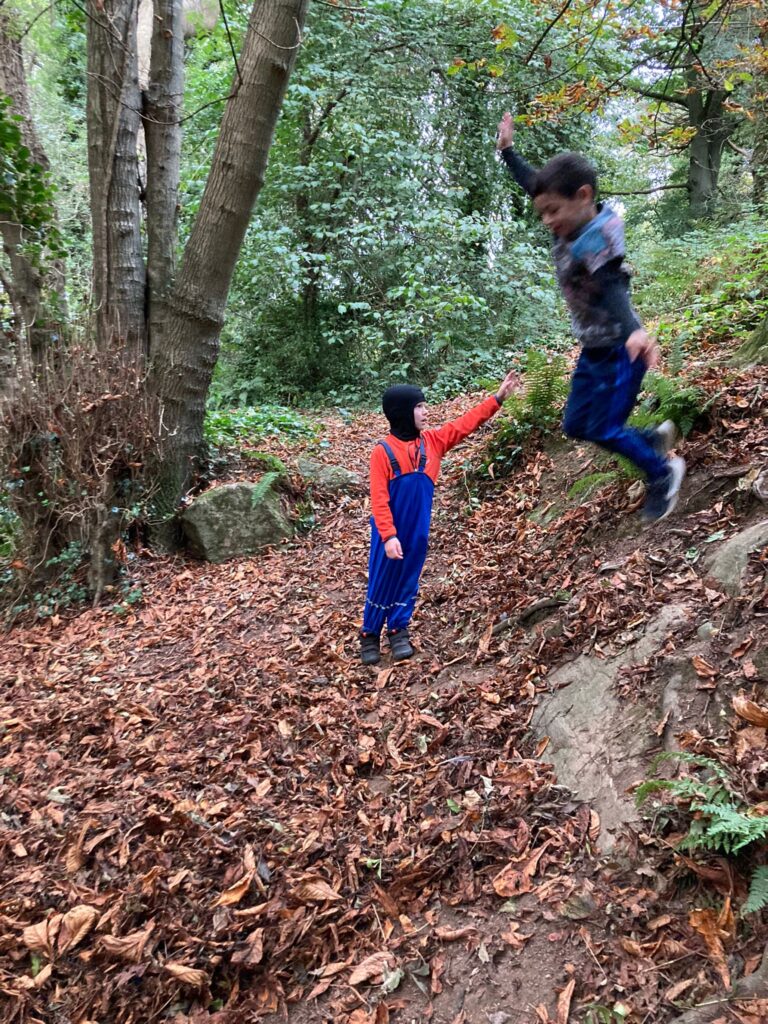
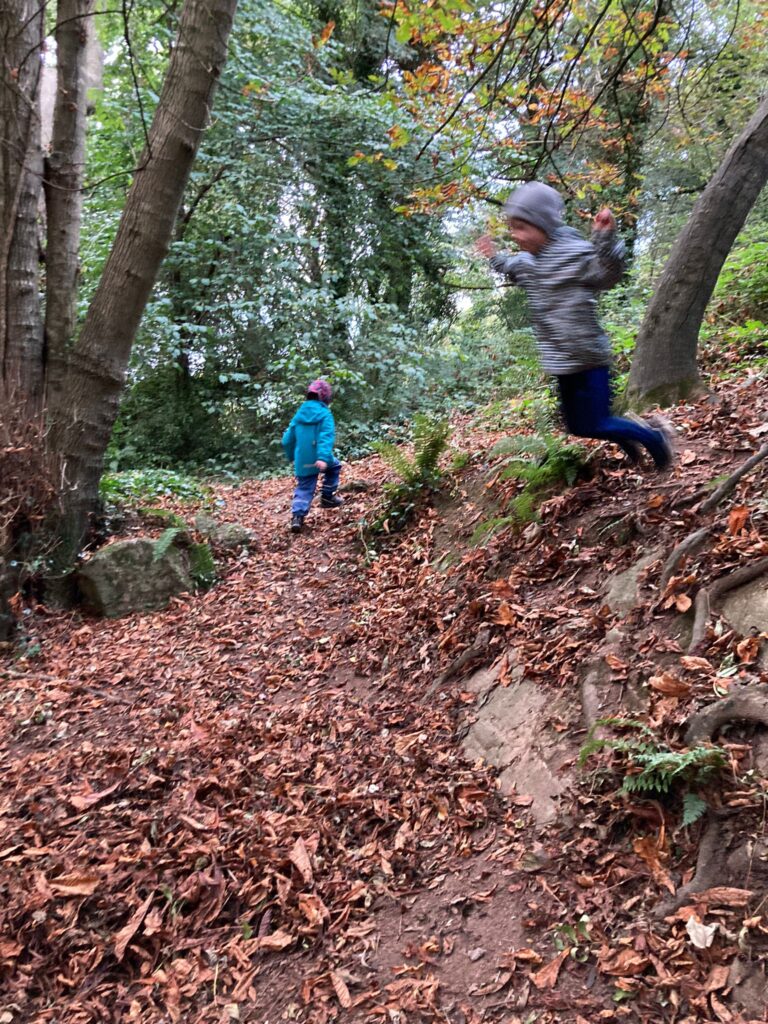
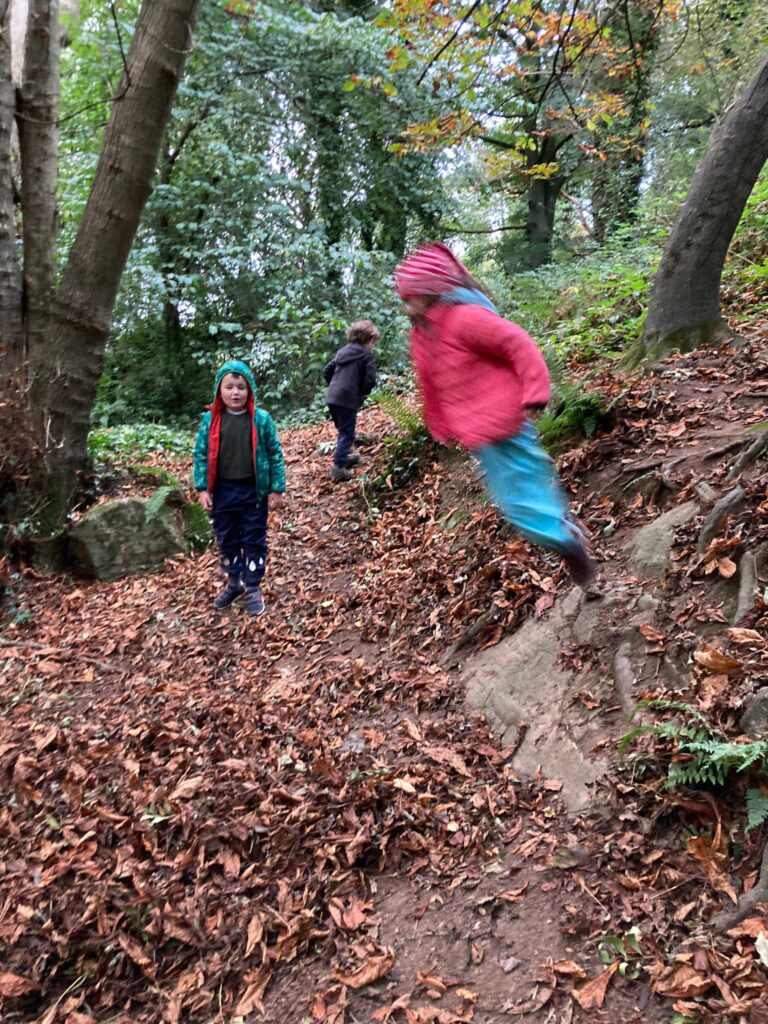
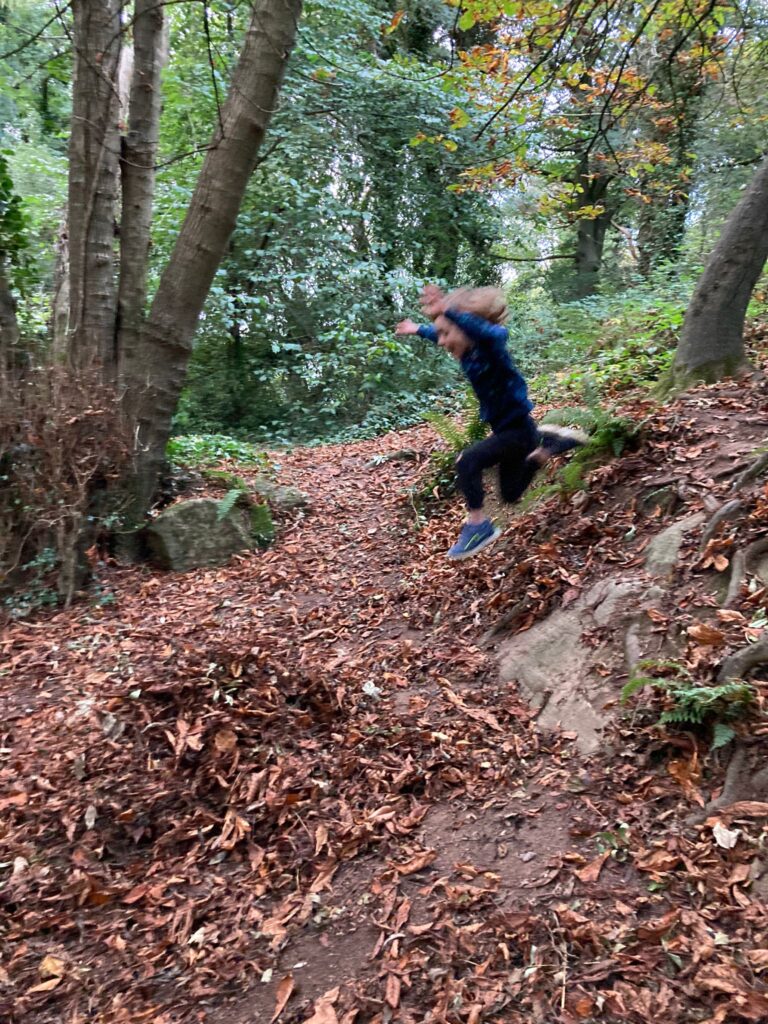
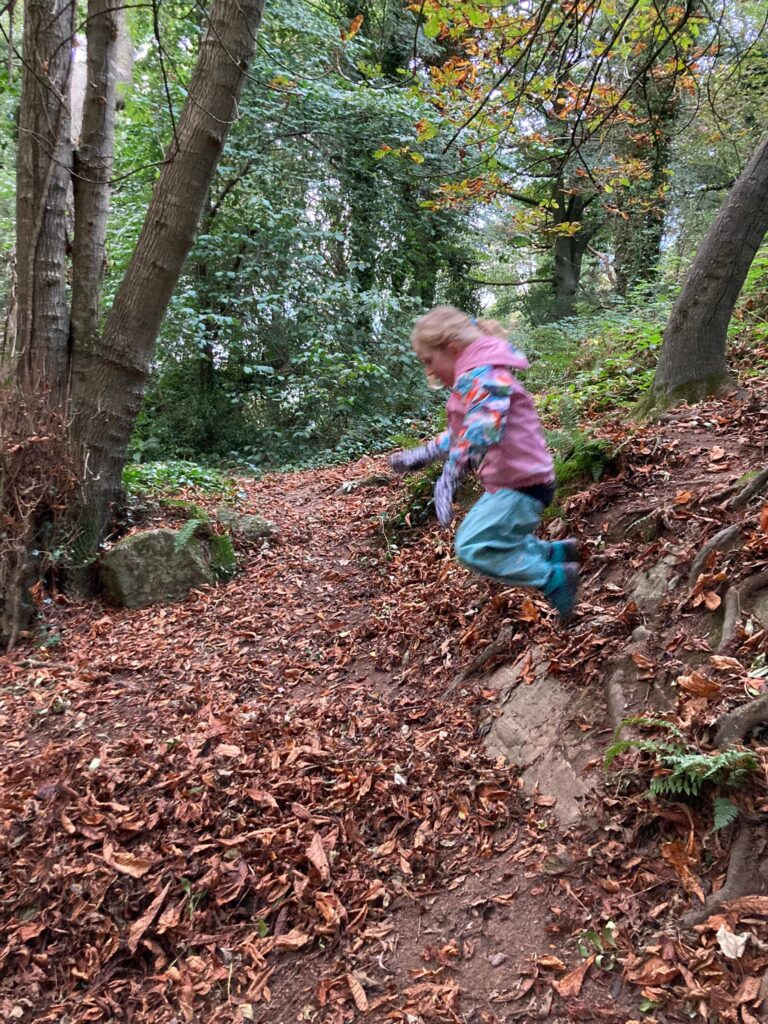
Although almost all the children were involved in this game, some children chose to play different roles, such as a police man role, which was to make sure that the next child jumped off when there was nobody at the pile of leaves. Another child played a leaf pile maintenance role, which was to gather more leaves onto the leaf pile to make sure there was enough cushion for everyone.
After playing in the leaf pit, a child who was not involved in the leaf explosion game said that he wanted to go to the usual basecamp. Some children heard him, and said they wanted to stay here. So the teacher gathered all the children, made a circle, and held a discussion. All the children had an opportunity to share their opinions. For example, “I want to go to the basecamp because I want to see the grandmother tree, she might have another presents for us”, “I want to see the grandmother tree too, because she said she was lonely when we left and we promised to go back every week”, “I want to stay here because it is so much fun”. Then a child said “I want to stay here a little more, and then go to the basecamp”. It seemed to be a good option to the group and they agreed that everyone would stay here for a little longer, and then go to the basecamp. They experienced how to solve the problems where there were different opinions – everyone was involved in their decision making.
So we stayed a little more in the leaf pit, and then went to the usual basecamp. They found another letter from the grandmother tree, which began with everyone’s name following “Dear…”. Everyone was so happy to see their names in her letter, except a girl who couldn’t find her name, because the grandmother tree forgot to put her name. The girl looked disappointed so the other children suggested writing to the grandmother tree again to tell her not to forget anybody in the group.
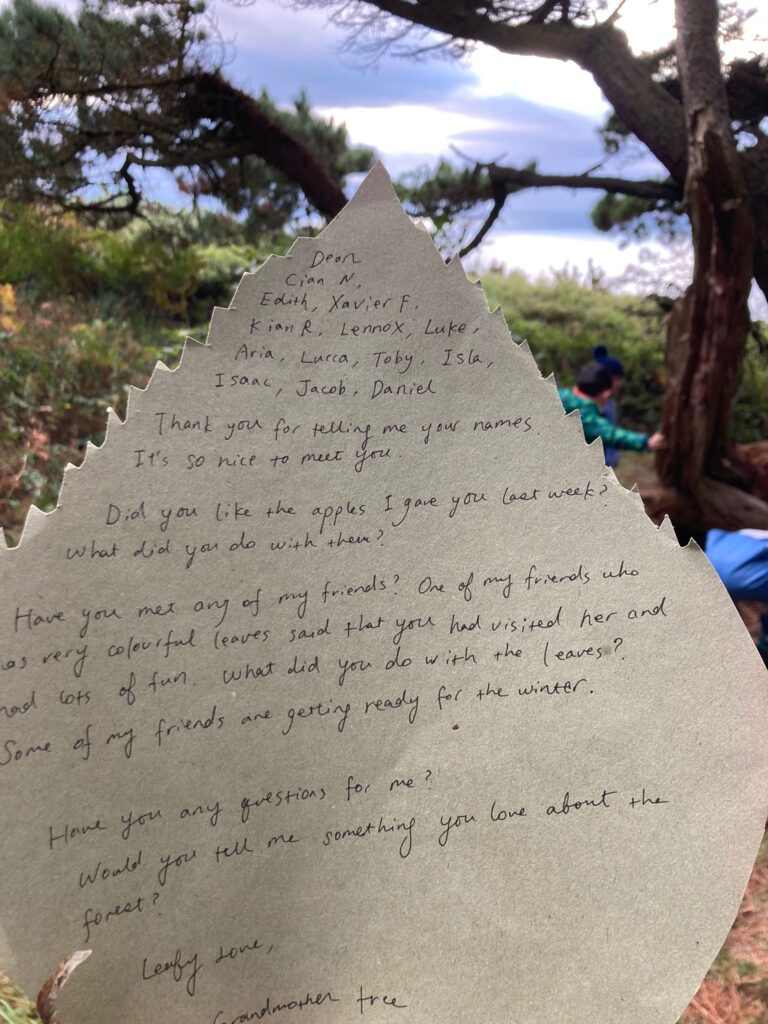
When all the children went off to their free play, a child came up to one of the teachers and asked for a pen and a paper. He wanted to write a letter to the grandmother tree. He thought carefully about what he wanted to write, took a long time to think, and finally came to the teacher again and said “would you write for me?” The letter went like this; “Thank you for the letter. You just had a tiny accident that you missed (the girl’s name) in the letter. We met the rainbow tree and we had fun in the leaf pit. From Senior Infants”.
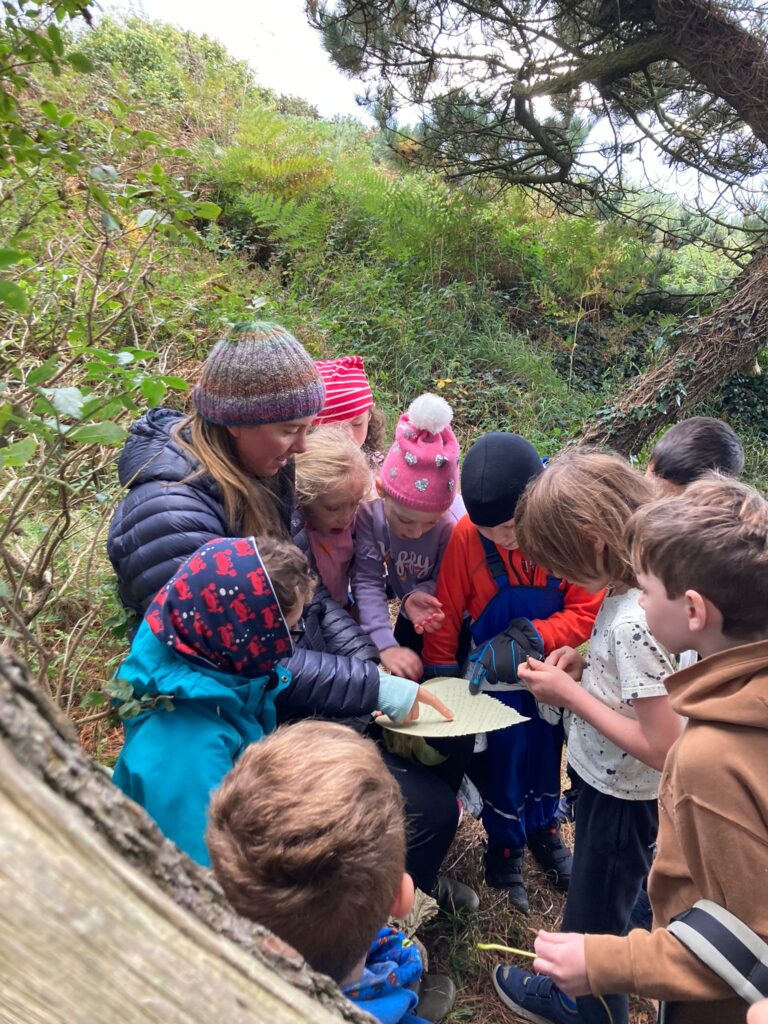
Free play gives the children their own time. So this particular child was able to think properly about what he wanted to write. There was no rush, no pressure and no right or wrong for what he would write. The teachers have more time to spend with each child during the free play. They are able to notice the signs of curiosity coming from each child, and spend time together to deepen his/her knowledge and interests.
During the free play some children were looking after a baby oak. Other children found a millipede whilst another group was busy digging and discovering.
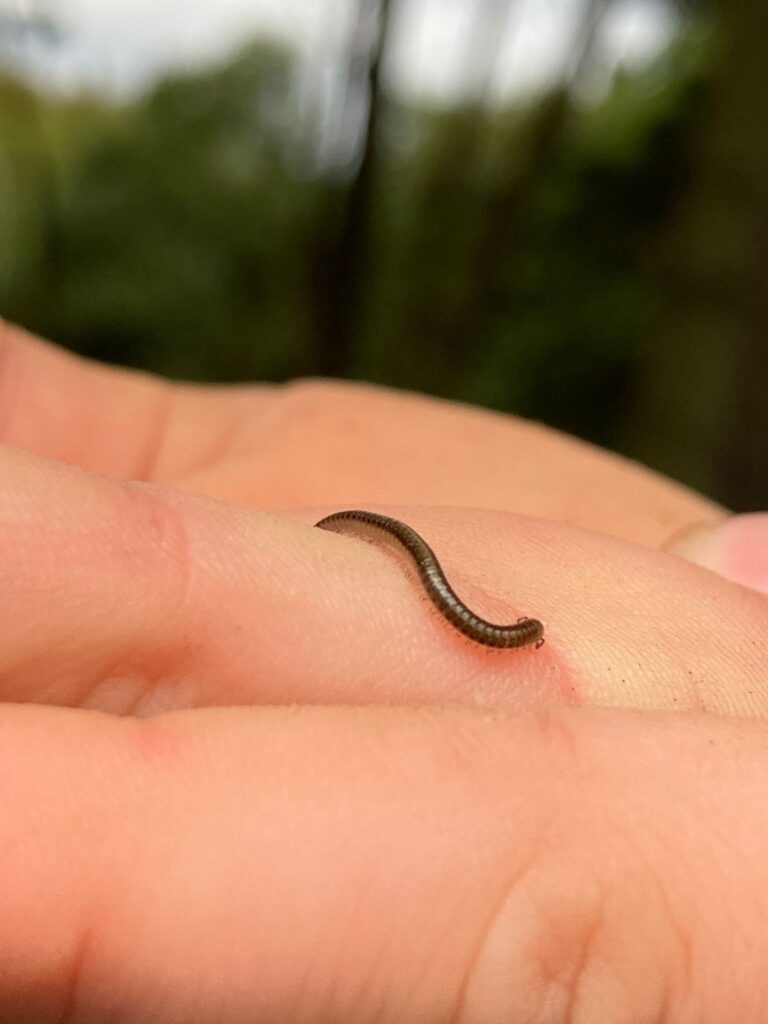
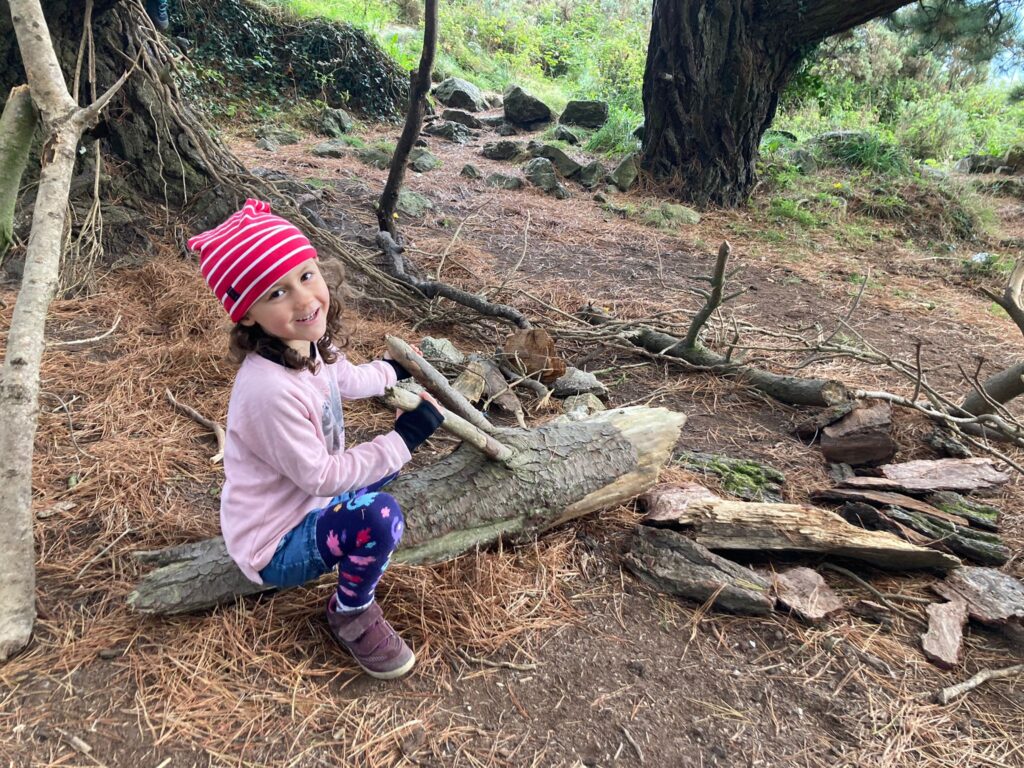
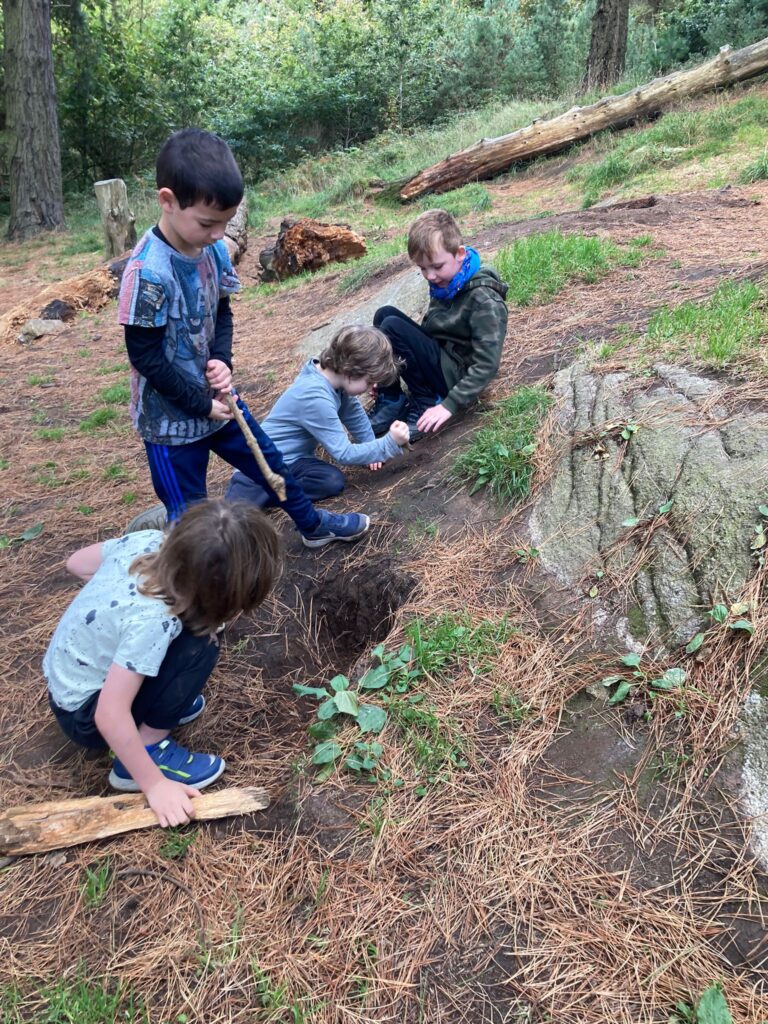
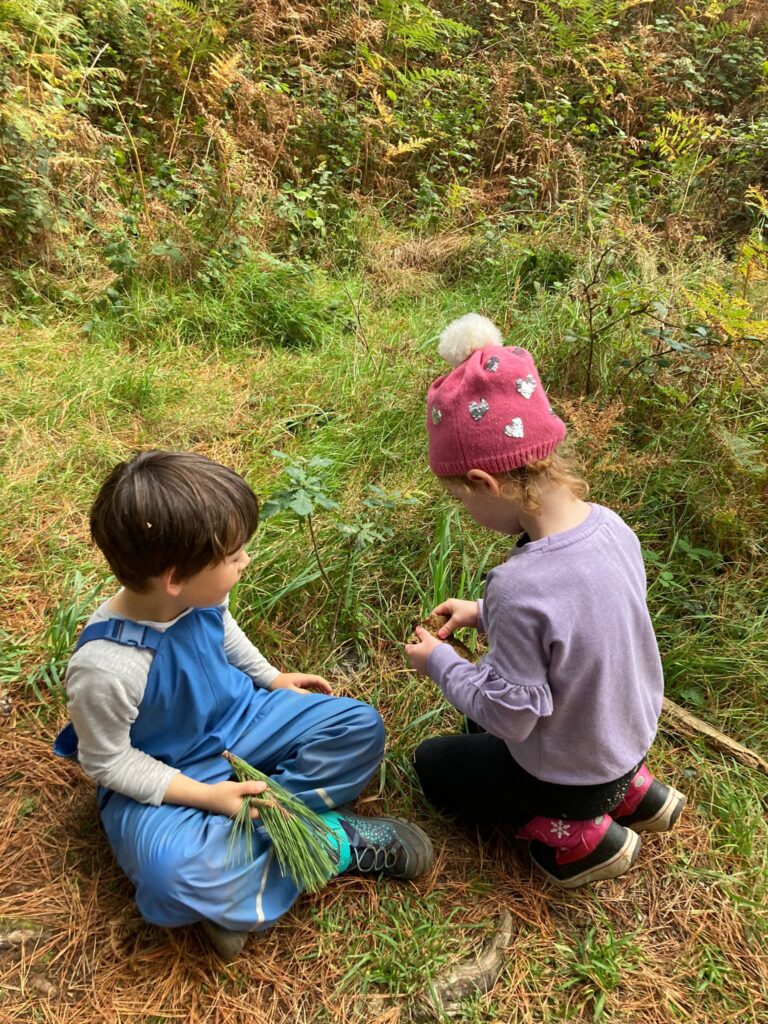
They then had their break time and listened to a story about a leaf man. This was followed by the sit spot, a quiet time in nature, and afterwards they shared what they noticed during their sit spot and what they were grateful for. Their ability to notice and to put into words what they heard or saw or felt develops each week.
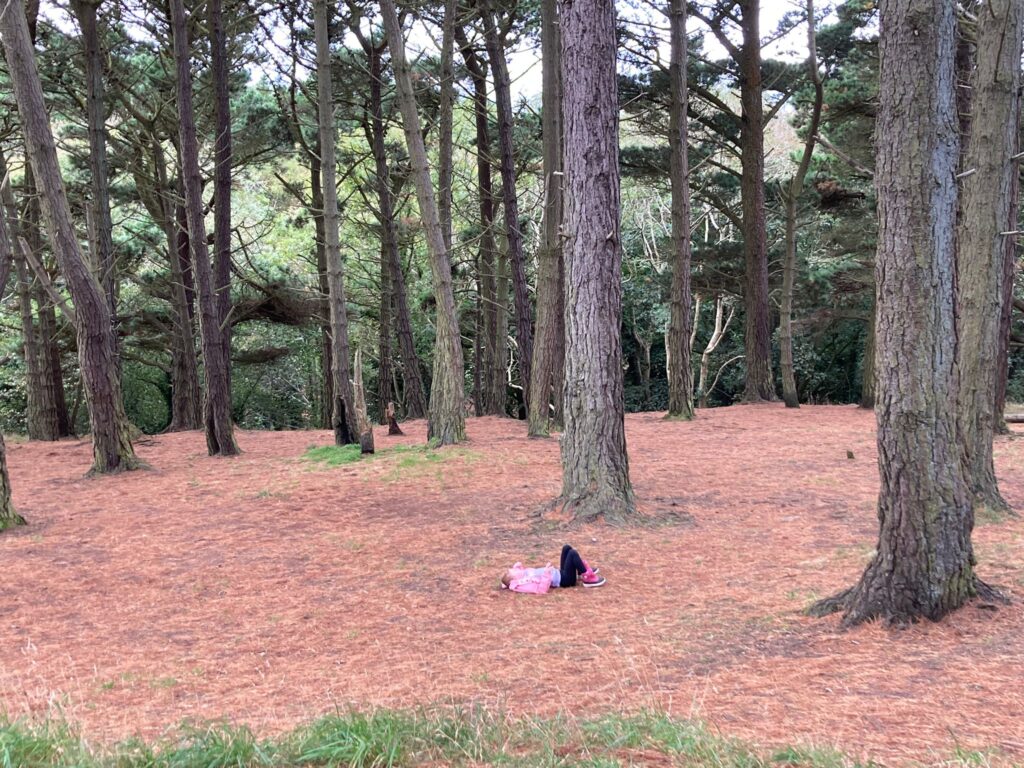
Today was cold and windy and a little spooky, in keeping with the halloween theme for our forest school session. On the way to the basecamp, we looked for scary features in the forest, and the children found many features such as ghost hands hanging from an ash tree, scary eyes on the oak trees, and four headed snakes etc.
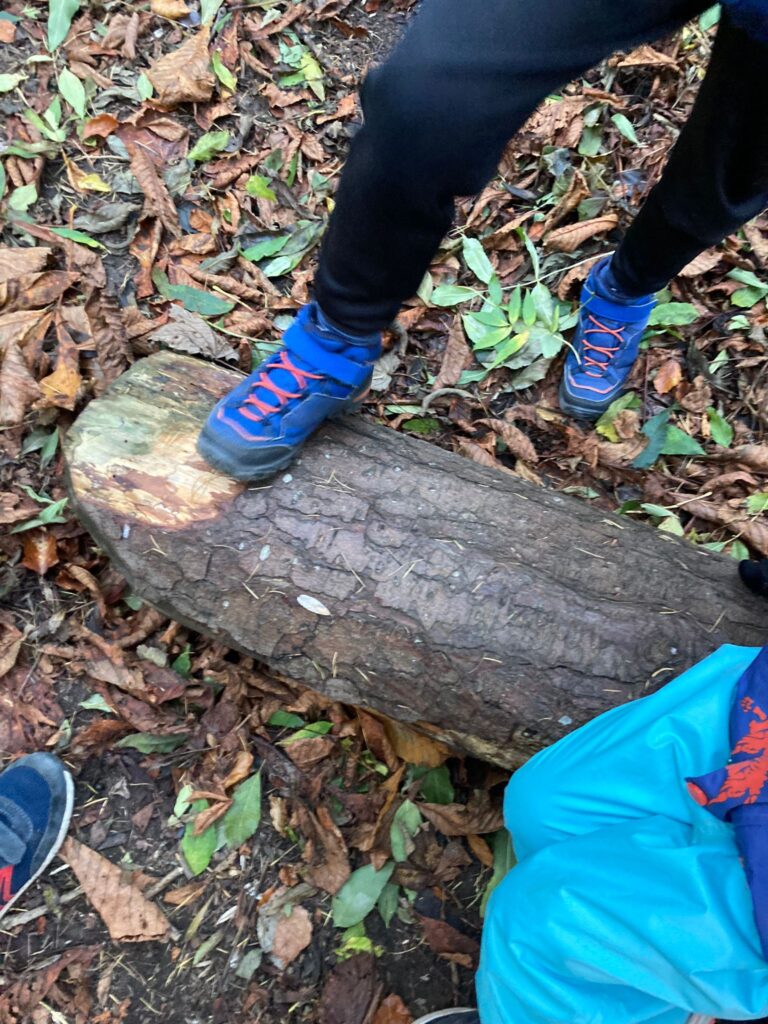
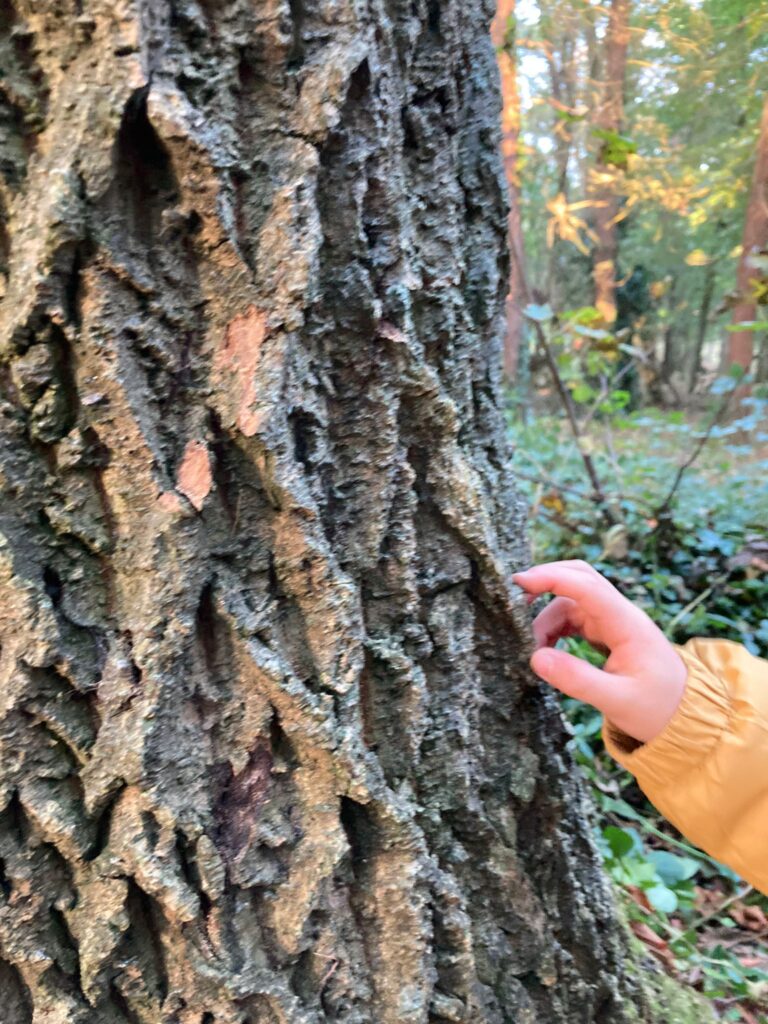
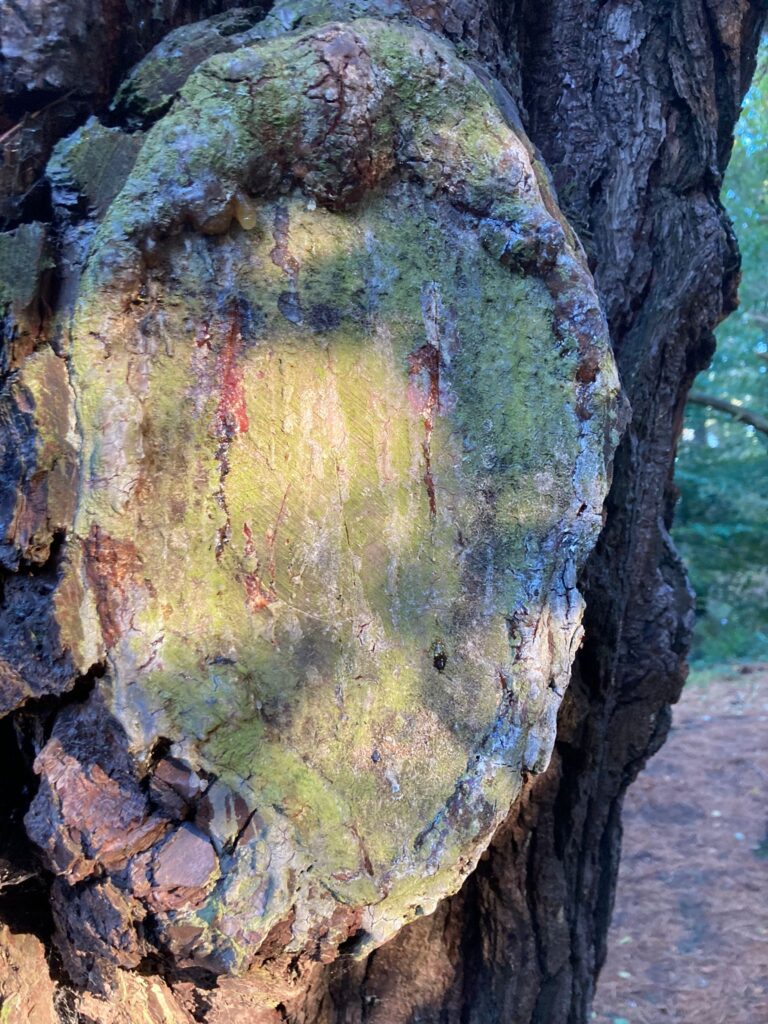
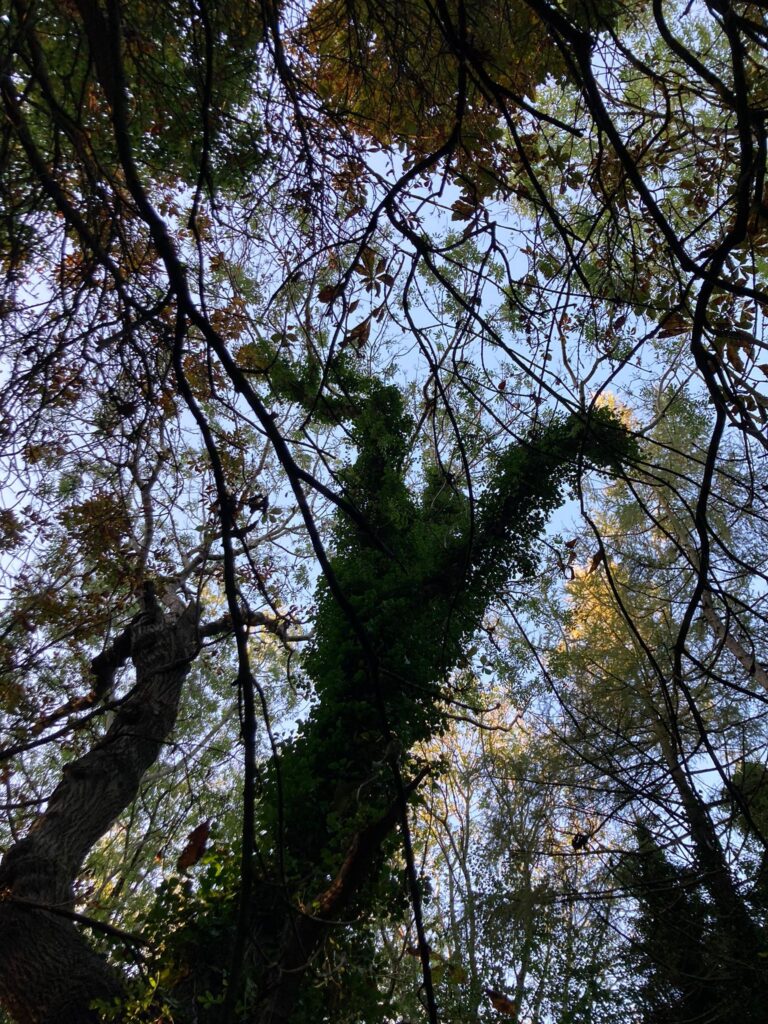
We stopped at the leaf pit under the rainbow tree, and played the zombie game. After everyone enjoyed being a zombie in the forest, we moved to the basecamp. On the way, we picked up some pine cones to make something spooky at the basecamp later.
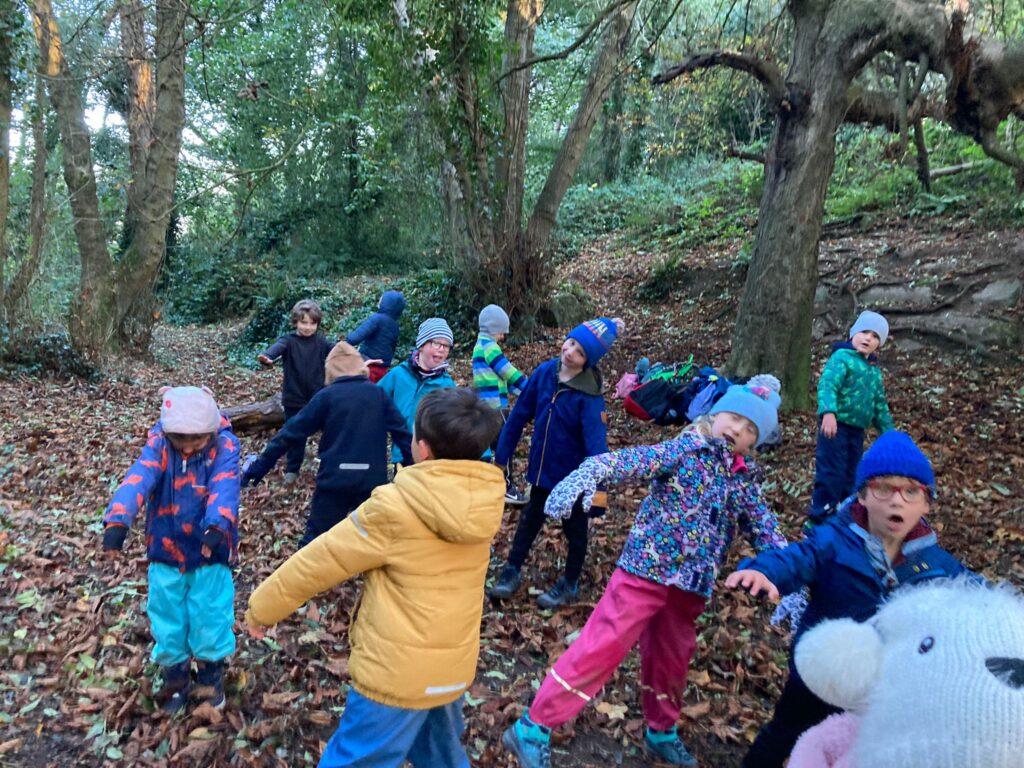
At the grandmother tree, the children found the new letter from the grandmother tree. In the letter, she answered the questions which the children asked her in the previous letter. To the question “Do you ever hug grandfather tree?”, she answered “Yes – I love to hug Grandpa tree. But mostly we touch each other with our leaves. We like to give each other enough space so our leaves can soak up lots of sunlight to make food for ourselves. ”. In this way, the children learnt about photosynthesis through the eyes of the grandmother tree.
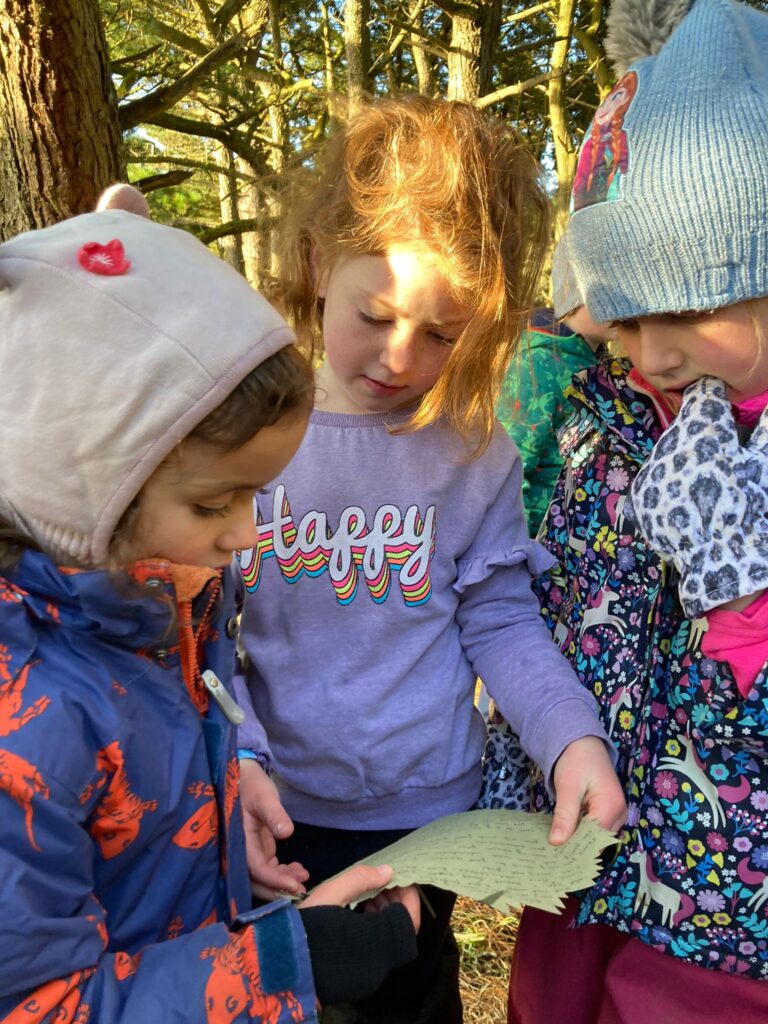
To the question, “How do you write letters?” She wrote “Well that’s my little secret! Have you any ideas?” and the children thought about who could have helped her. The ideas were such as “fungi”, “blackberries”, “fiaries”, “tiny branches”. The children already knew about the root system of trees and how fungi help trees to communicate each other from the previous grandmother tree’s letter. Instead of learning from textbooks, children in this age group are better able to understand ecosystems through stories, imaginary plays and by using all of their senses – observing, touching, smelling, hearing and tasting. The grandmother tree therefore can be an important feature in the forest school for this age group.
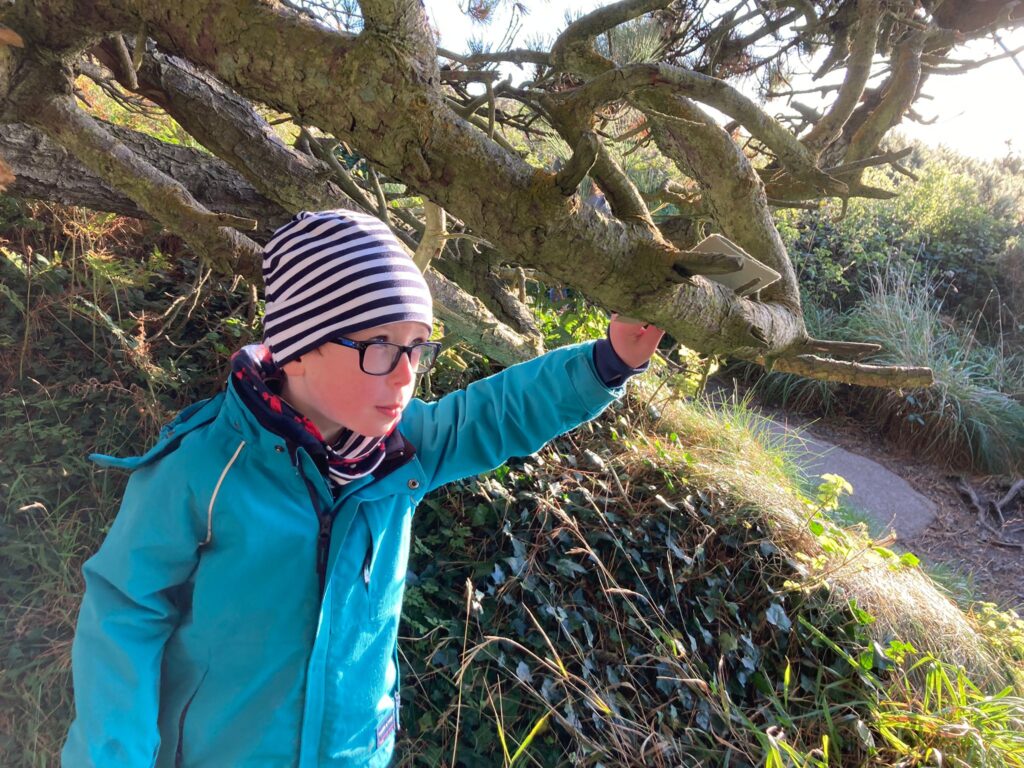
During the free play, a child who wrote a nice letter to the grandmother tree wanted to write another letter. He seemed to like the communication with her. A few children made spooky creatures using pine cones. Another child found a small insect and he wanted to show it to everyone.
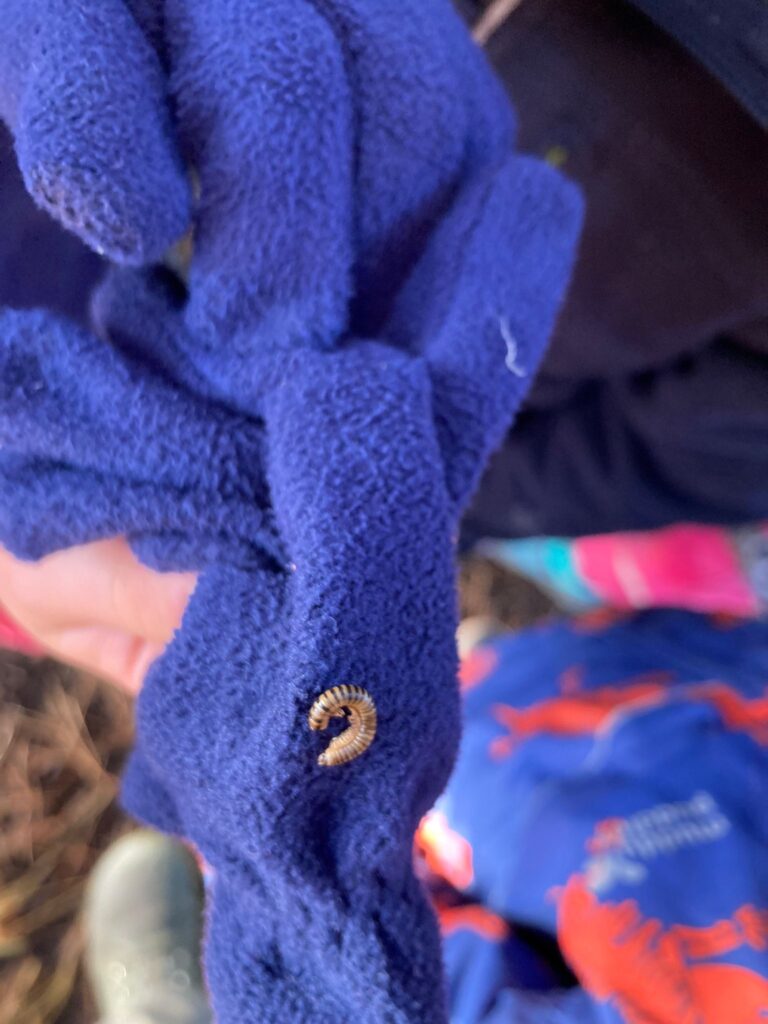
The group of children who enjoyed building a tree hut last week seemed not to be interested in the same activity this week. They found different things to do such as climbing trees, hitting the ground with a big pine tree branch which looked like an axe, or gathering leaves in a big pile.
Children who had not shown interest in it last week started to take initiative and play more in the hut this week. This play was gentler than the previous week. For example, one of the children made a few stairs from the stones, a dining room and a shower room made by the hanging branches. Two other children made a roof with small tree barks. They started from the small constructions, and gradually moved to the larger construction such as moving a branch as long as their own height. They discussed, tried, helped each other, asked for help, and tried again. It seemed that those two children watched how the children in the previous week played at the hut, and copied what they did.
All children are different. They have different abilities, talents, interests, curiosities, likes and dislikes. The developmental stages are also different, including writing, reading, speaking, and expressing their thoughts and feelings, and their physical skills. Forest school for this age group seems to allow each child to shine. The children can do their own thing at their own pace.
In this comfortable but stimulating environment, the children can enlarge their world by finding something new each week in nature, in themselves and in each other.
After a break, the teacher introduced the “bonfire jumping game”. The children made a pile of leaves and jumped over it by taking turns. They made it higher each time. This game involved leaf collection, physical challenges and playing with imagination. By collecting lots of leaves, and jumping as far and high as possible, the children developed their tactile senses, vestibular senses, proprioceptive senses and visual senses.
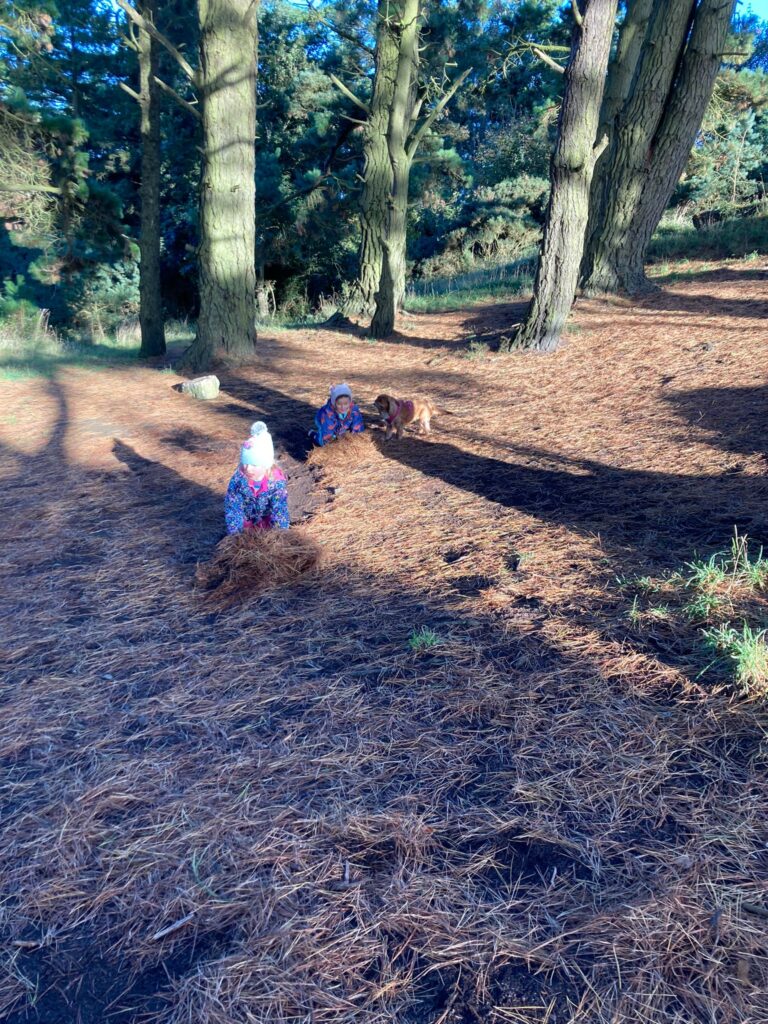
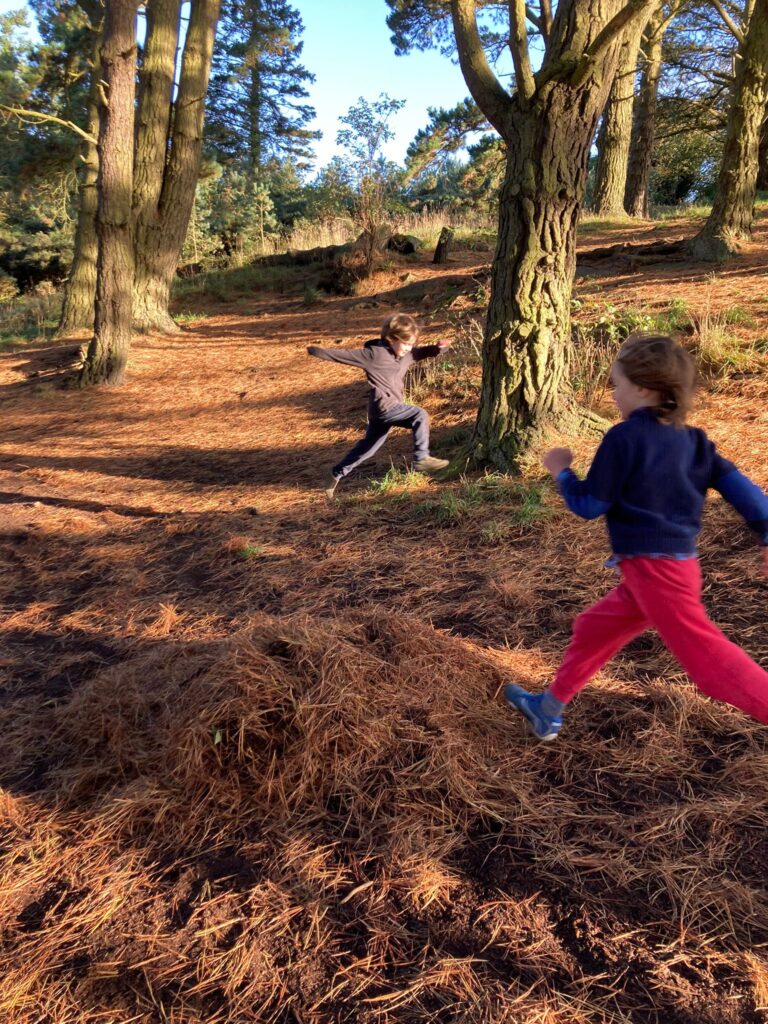
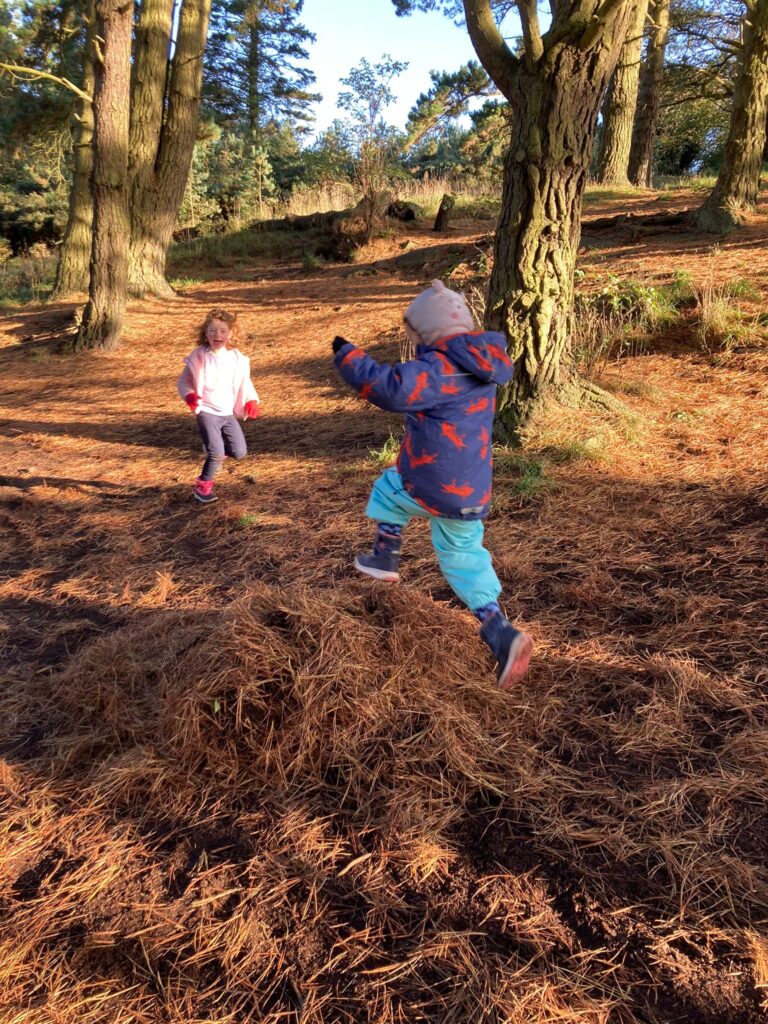
Some children developed a Halloween games called ‘Black blood river’. Allowing children to use their imaginations freely within play is very important for their development and well being. The ‘rules’ changed as the children found ways to make it more fun.
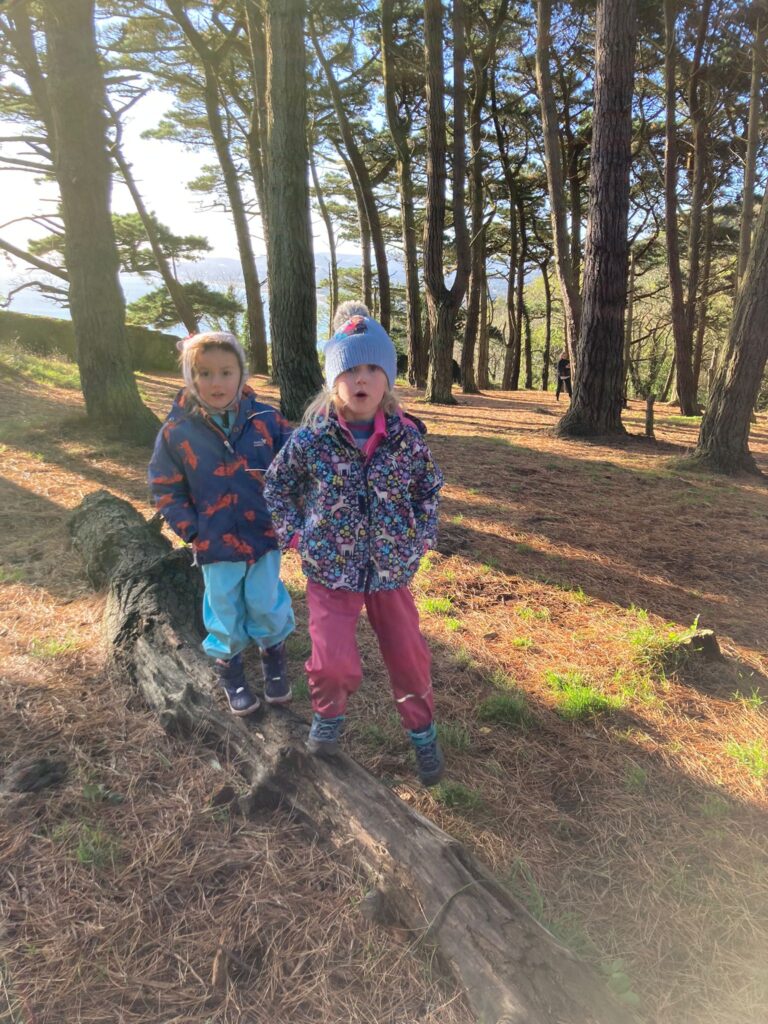
After that, the children had a time for the “sit spot” and shared what we noticed and what we were grateful for today. Every session the children and adults share what they are grateful for from the session. This is a core part of the structure of Forest school as gratitude helps us to:
Today was cold and dry, and everyone looked refreshed after the midterm break.
We found some pumpkins left behind at the Killiney hill, and the children were wondering why they were there. The teacher asked why people would leave pumpkins there, and some of them said it might be for the wild animals to eat. It was a kind thought, but wild animals such as hedgehogs may eat them before going to hibernation, and could cause diarrhea or sickness. So we agreed that the things which do not belong to the natural environment should not be brought there.
We stopped at the leafy pit under the rainbow tree. Most of the children started to queue up for jumping off from the rock, and some other children who were not interested in the game explored the surroundings and found a secret place.
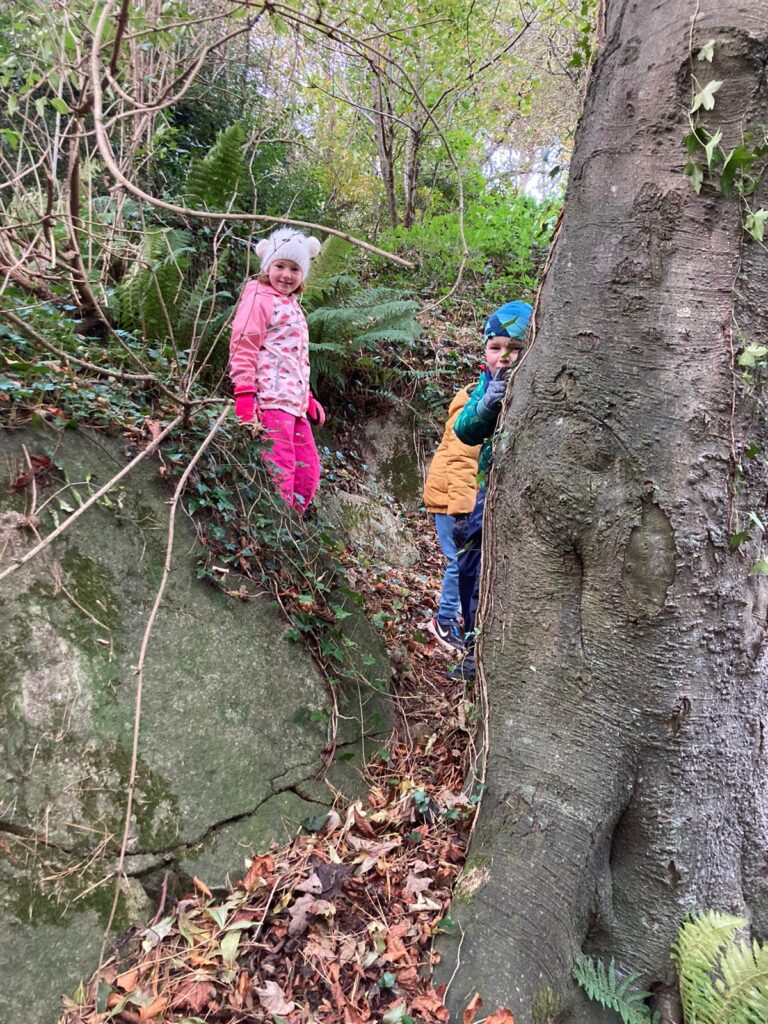
On the way to the usual basecamp, one of the children found a beautiful leaf skeleton. We looked at it carefully, and discussed how it could be made. Someone said that it might be eaten by tiny creatures. Another child said that they wanted to bring it for the grandmother tree as a present. The more they looked for them, the more they could find the leaf skeletons on the ground. They were like ornaments.
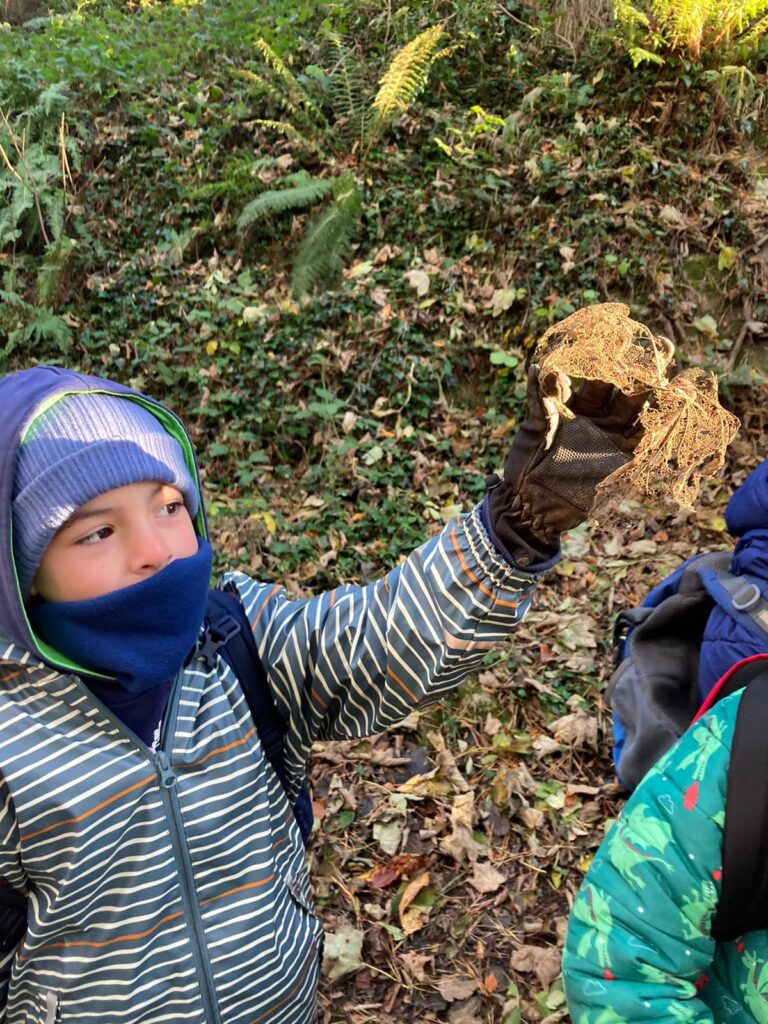
At the base camp, we found another letter from the grandmother tree. This time, she offered her pine needles to make pine tea. She added that “grandfather tree said you could use some of his needles too as it’s a good idea not to take too many from one place.” So that the children knew that they could pick just a few pine needles from each tree and in this way they didn’t have to disturb the tree. In forest school, we make tea from different plants each week, such as blackberries, nettles, apples and pine needles. The children have been enjoying the taste from different plants, and learnt each plant had a unique fragrance and taste.
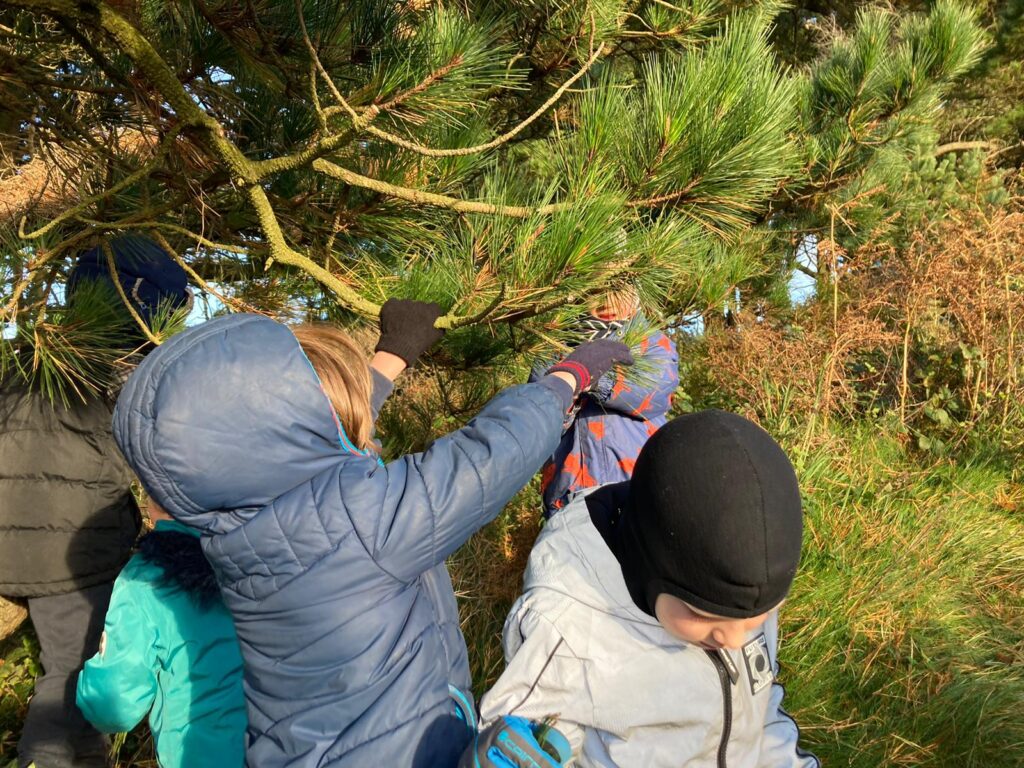
During the free play, some of the children started to make a hut again. They made a roof with the tree barks, like the previous week. This time, the hut was upgraded – one of the children made a “water construction” where the water can drain. He explained “because this roof has to stay here forever.” The forest provides the experimental place for new innovations and engineering works for the small scientists and engineers.
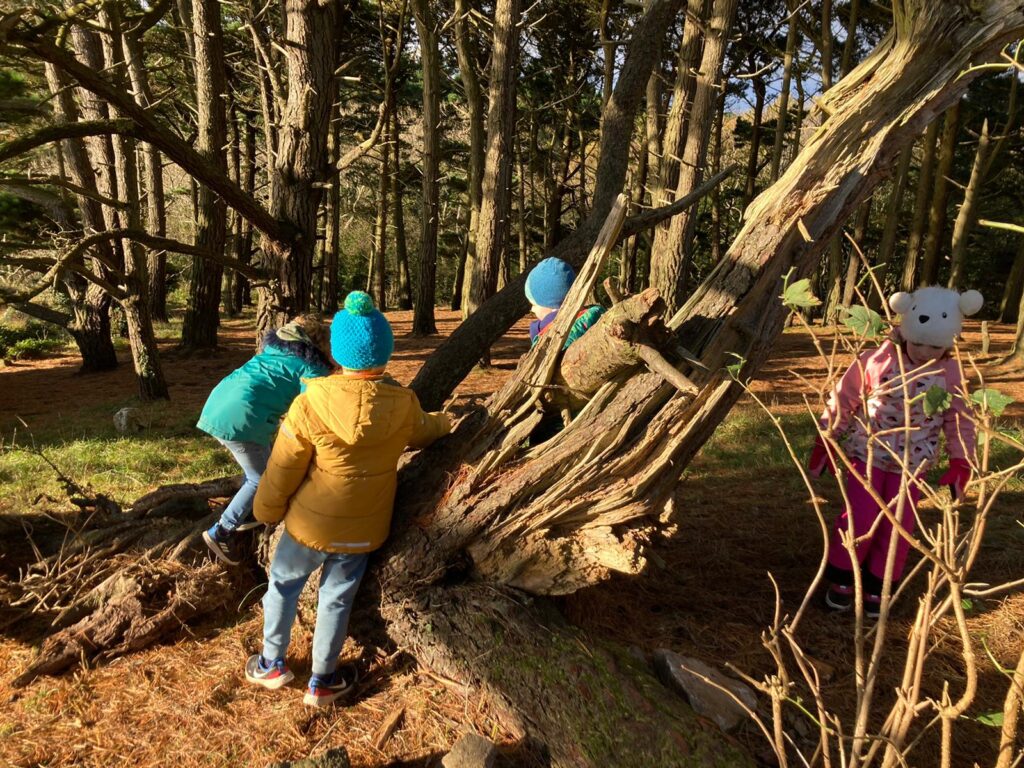
Some children started to become Forest Ninjas, and enjoyed hiding behind trees or logs not to be seen by the adults. Other children collected pine cones and said that “These are the bombs to attack bears.” They imagined that they were in the forest in Japan where lots of bears live and might attack humans when they are hungry.
Some children continued their digging from last week. Overheard:
“I wish I had a big stick to dig with.”
” Well, you could go find one!”
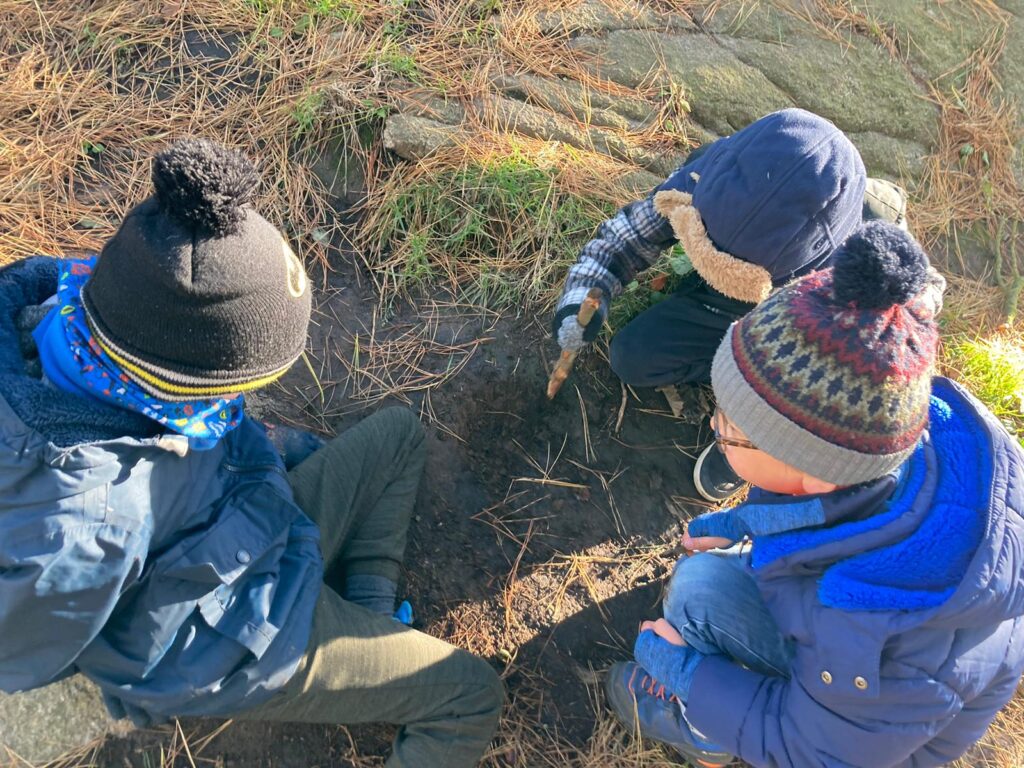
Some other children found a big hole under logs, and they were discussing whose home it could be. “Foxes?”, “Rabbits?”, “Hedgehogs?” They looked into the hole and it looked very deep into the ground. Another child found a twig that looked like a spider. He was happy to find the twig, and played with it for a while, but soon he started to make a little home using the twig. He put it on the ground and covered it with fallen pine needles.
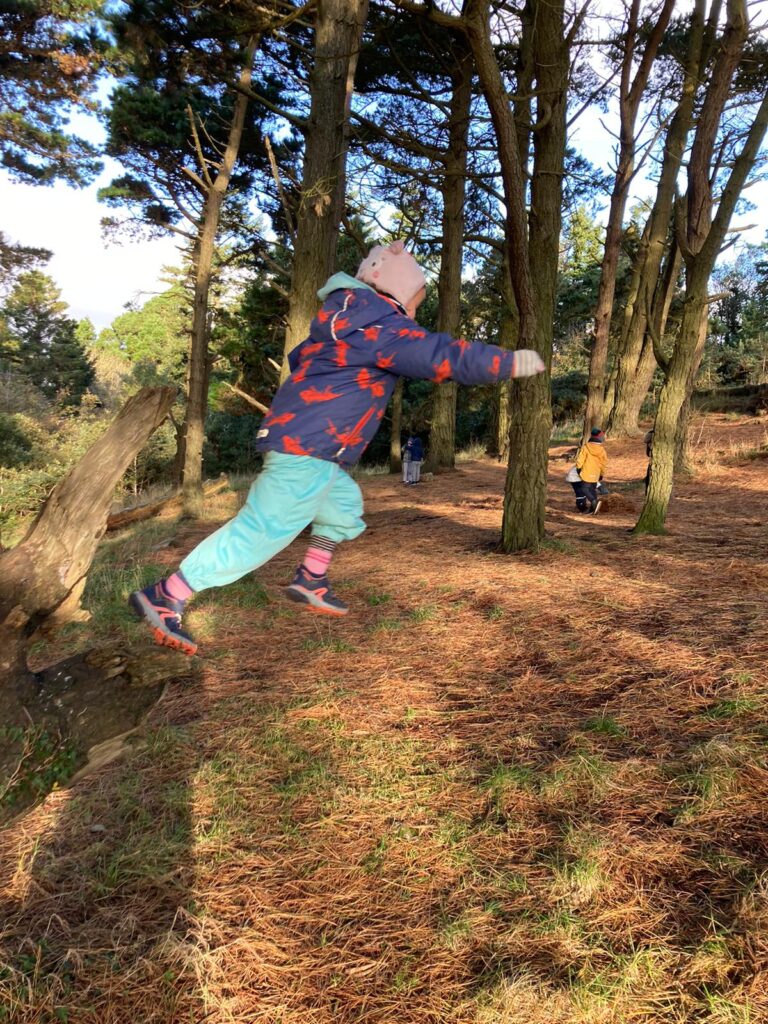
Some continued to connect with the grandmother tree by writing letters and drawing.
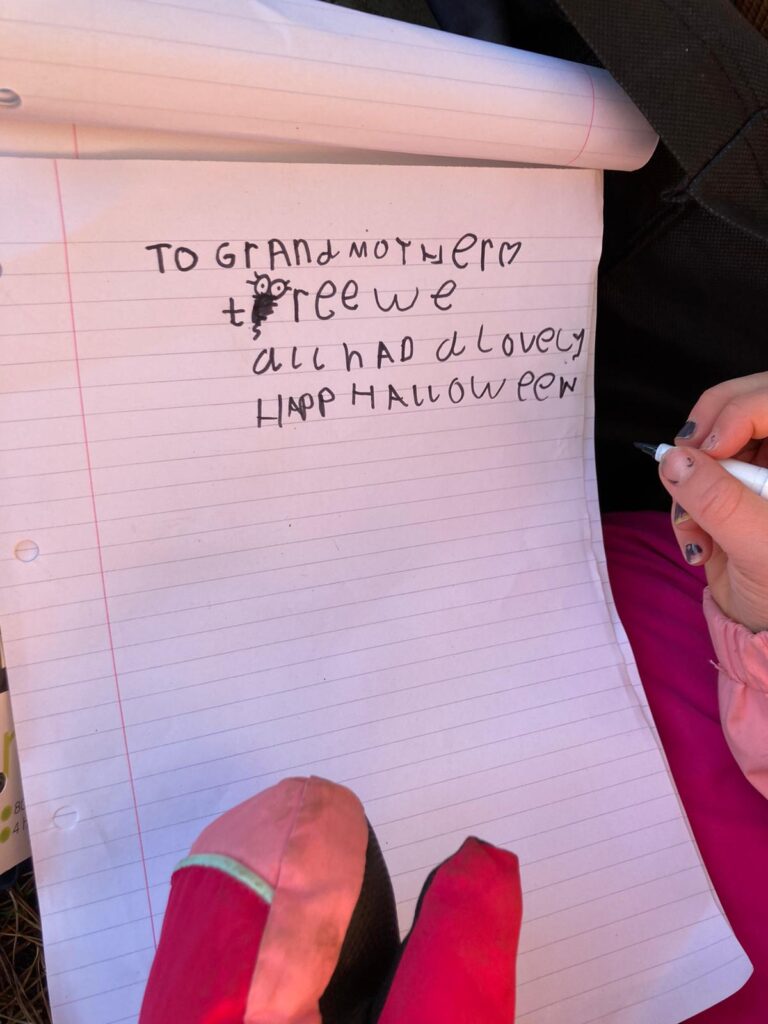
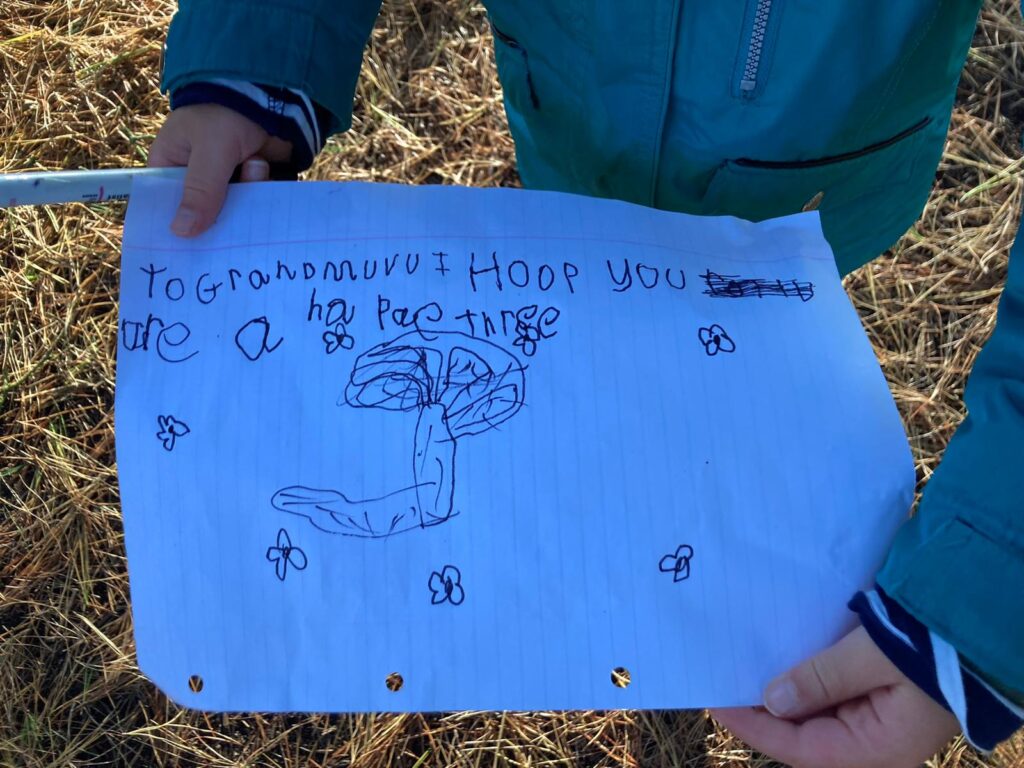
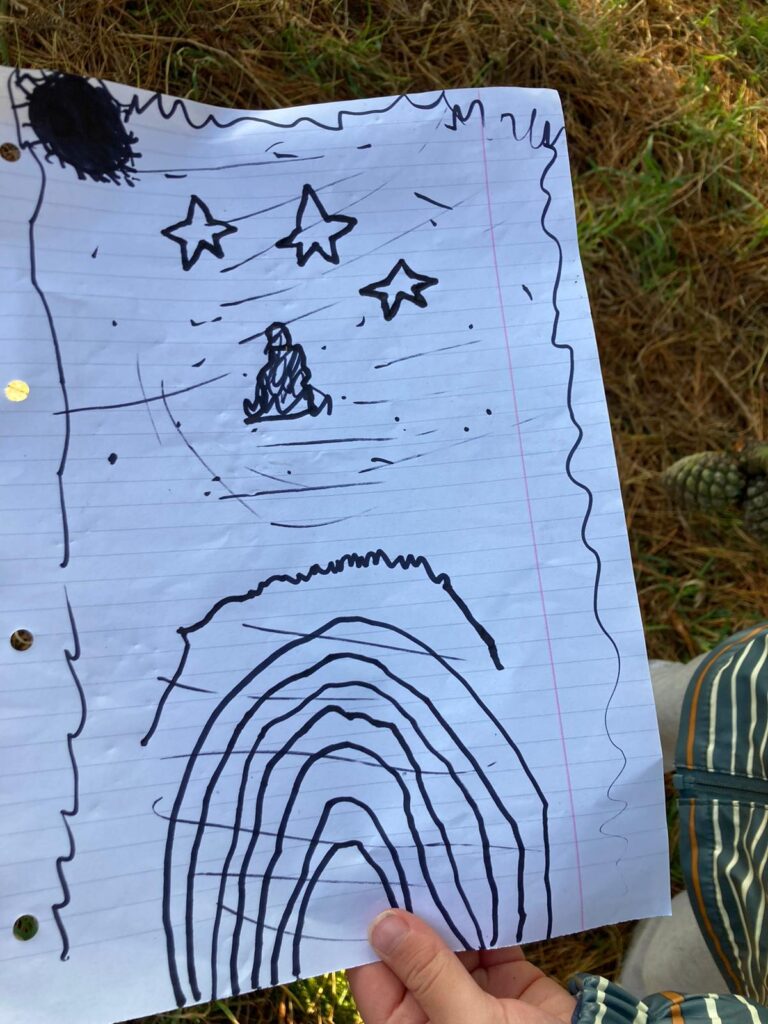
During the lunch break, the teacher talked about bats, and the children learnt the body structure of bats. Bats are mammals like humans so they have five finger bones. These bones are shaped like wings so that they can fly. With pairs, they made bats on the ground using sticks and twigs. Some pairs made bats on the ground very well, and some started to draw pictures of bats. Some started to play a battle game instead.
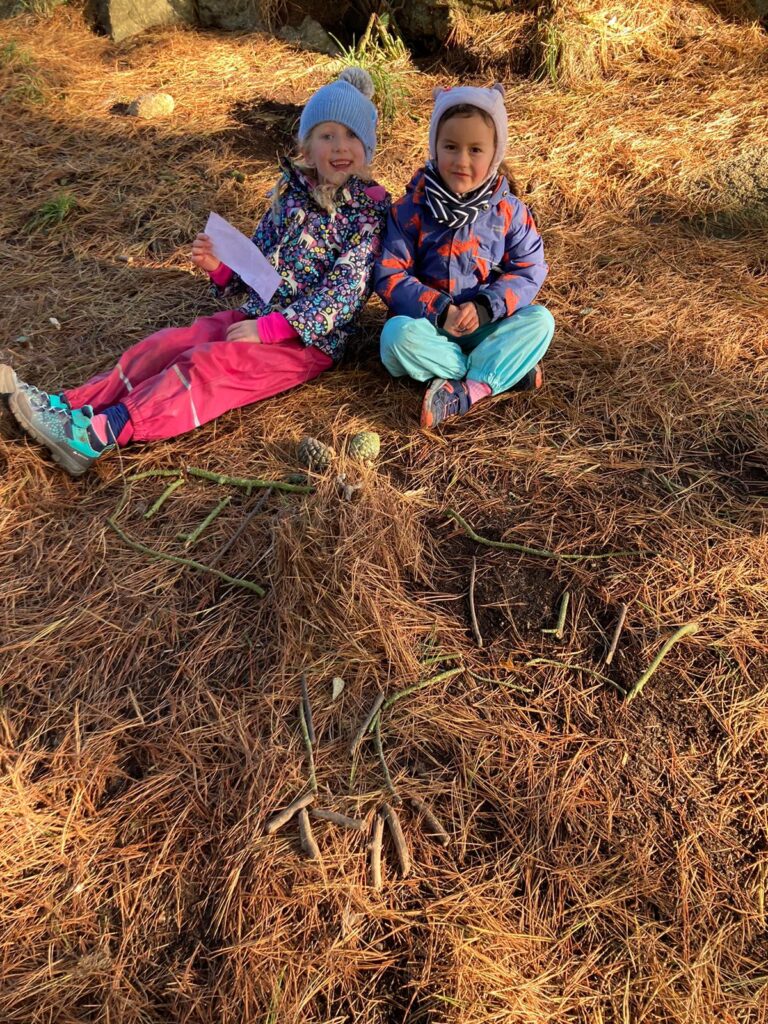
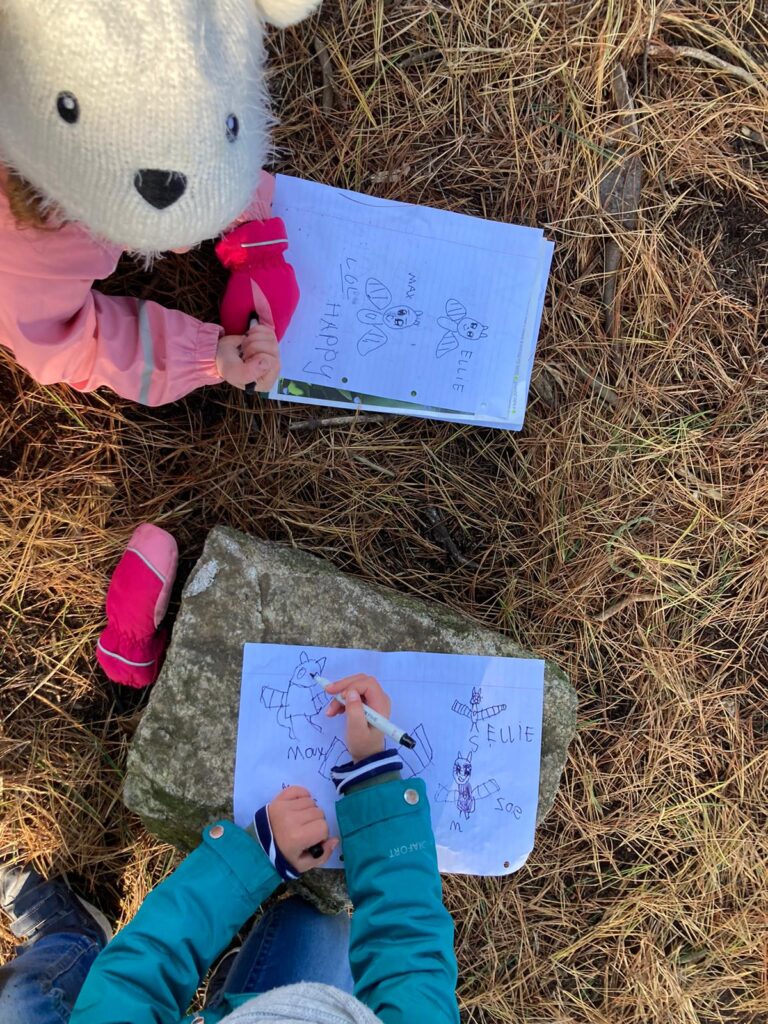
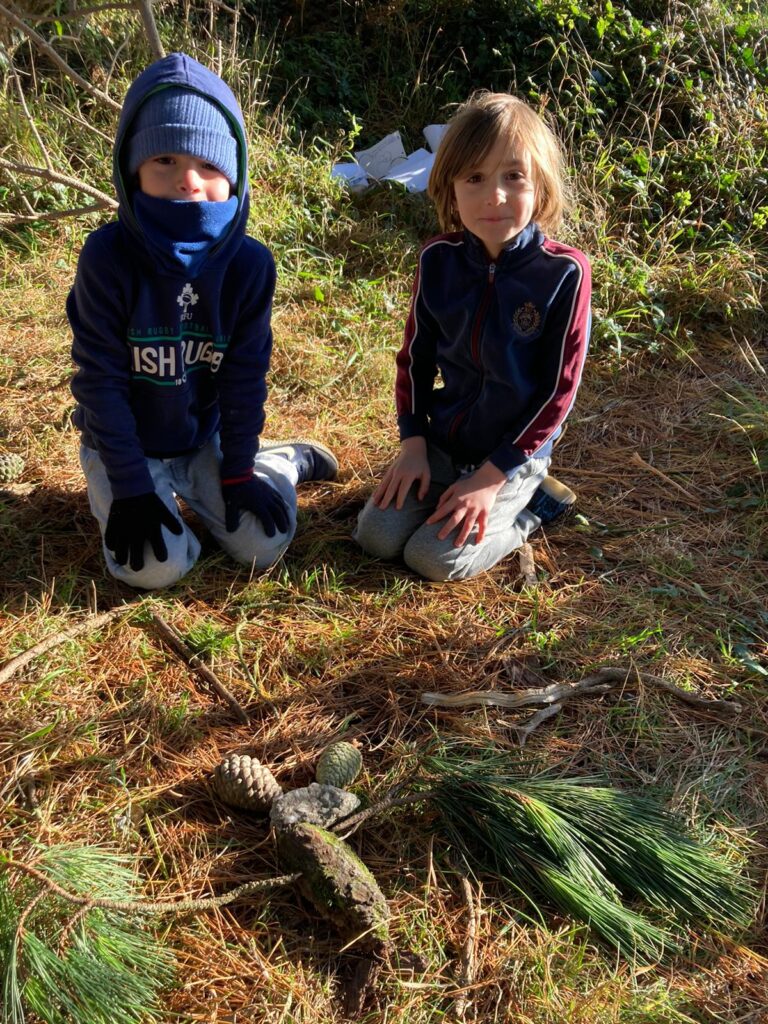
After the children enjoyed their time in the forest, we had a sit spot, and shared what we found during their sit spot and what they were grateful for from today’s forest school. The children noticed wind, sunshine, the tree moving, birds singing. By now, they learnt how to be quiet and observe their surroundings and their own feelings during the sit spot.
Because the teacher had told the children to protect each other in the beginning of today’s session (some of them are afraid of dogs), one of the children said “I am grateful that (name) was safe and happy today”. Forest School gives opportunities to notice other people’s fear and feelings, and opportunities to help each other.
Today was a foggy day with a grey sky, but the temperature was relatively mild. To start they played a ‘catch the wishy leaf’ game. If they caught a leaf before it touched the ground they got to make a wish.
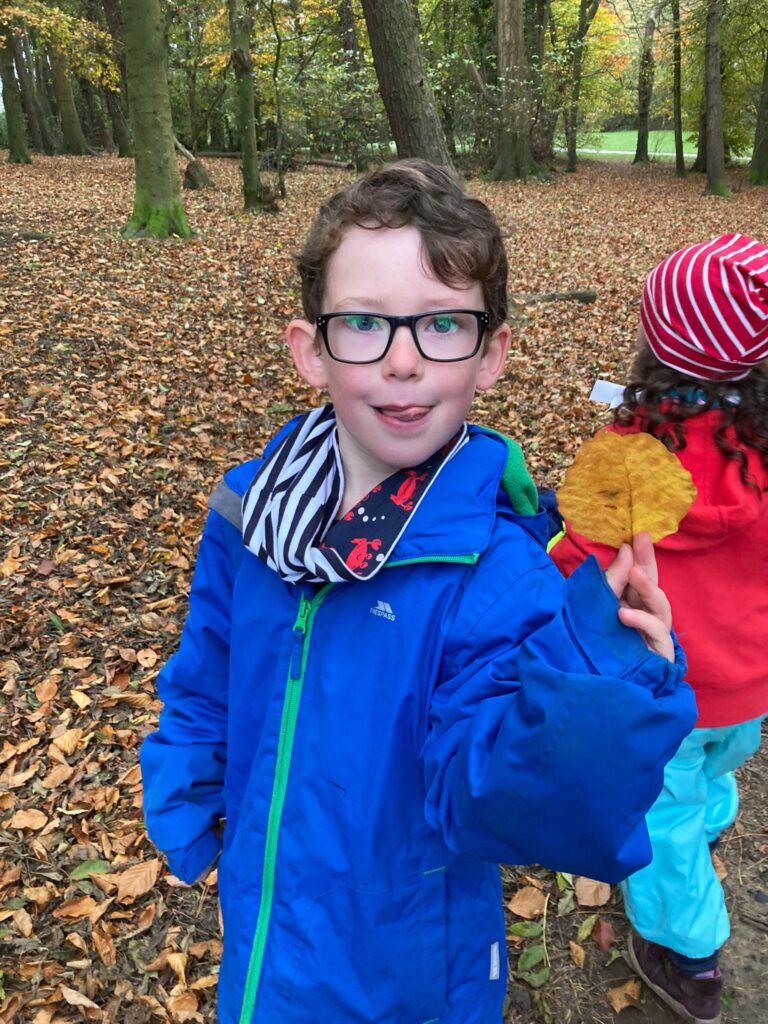
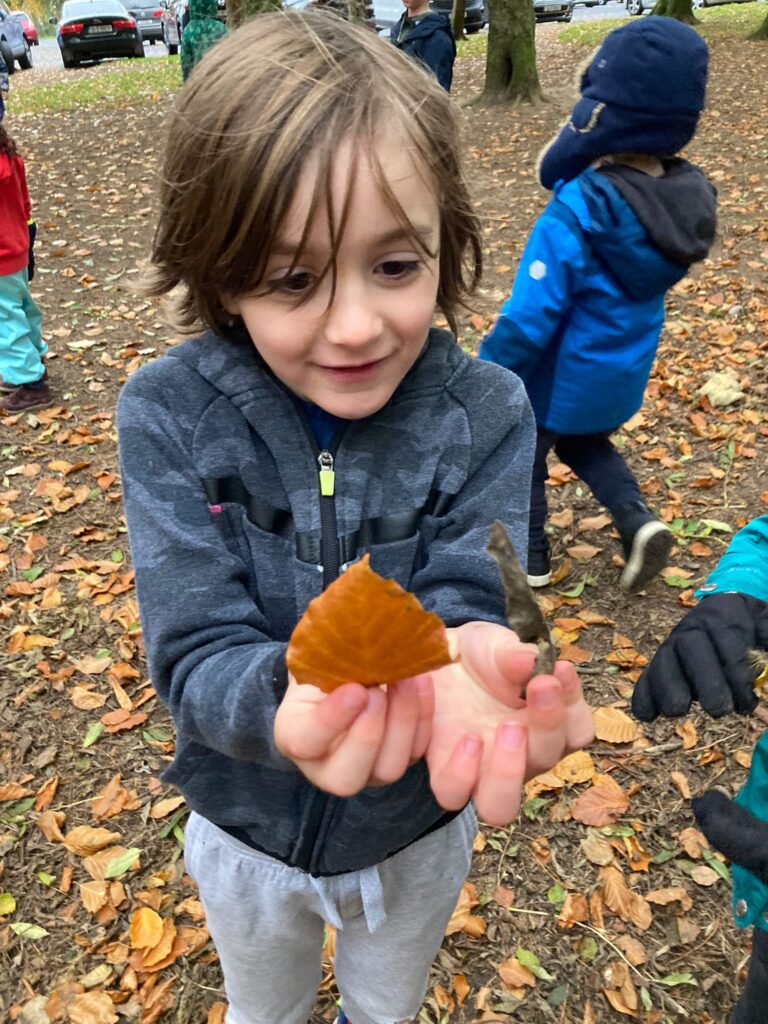
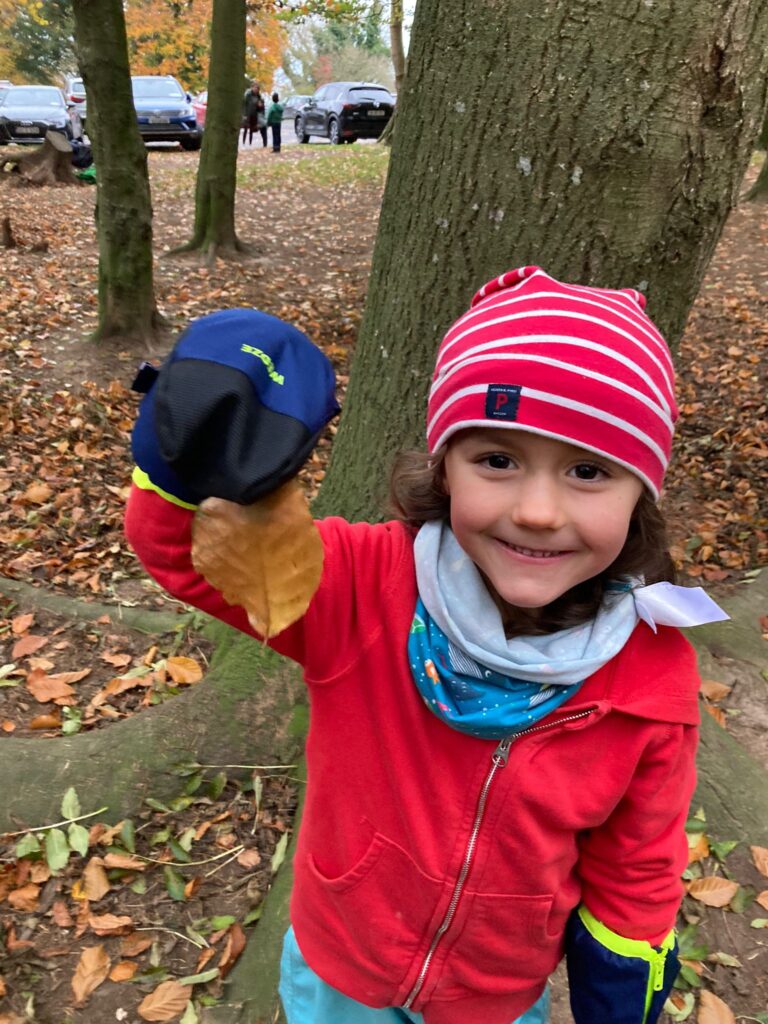
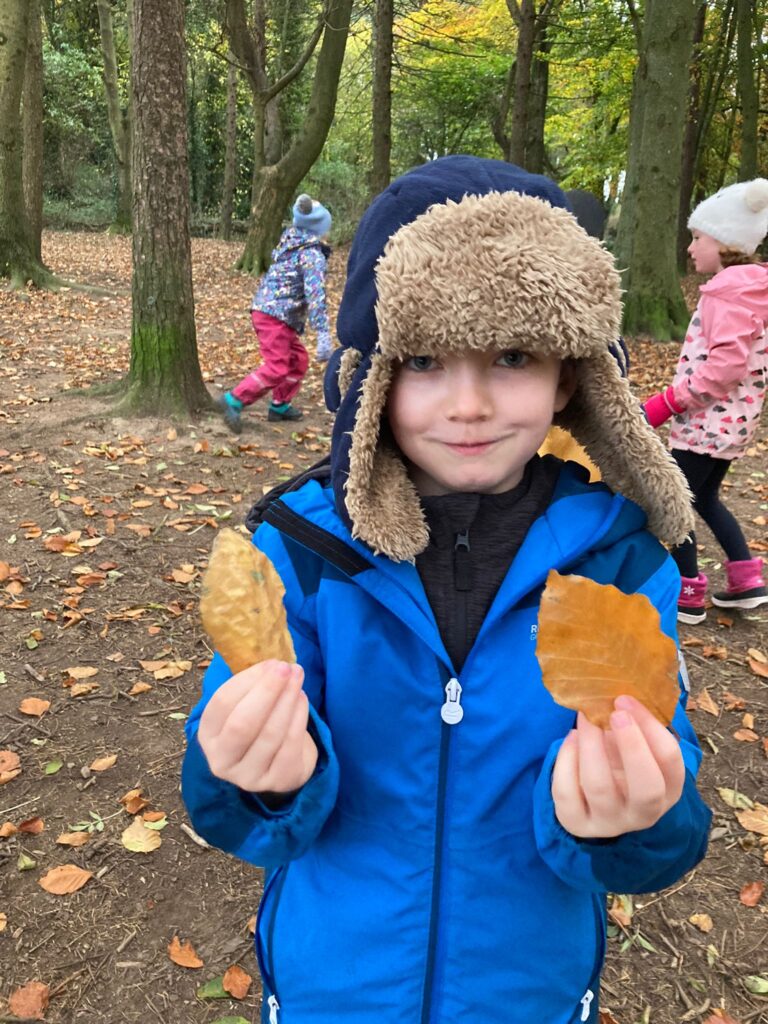
Today’s theme was “hedgehogs” which hibernate in the winter. The children were told to pick up some sticks for the hedgehog game on the way.
At the rainbow tree, after some free time, we played the hedgehog stalking game. For this game, the children needed to walk silently like foxes. Before the game, the children tried walking as silently as possible, and shared the ways which worked for them. Each child found their own way, such as “I walked where there are no leaves”. “I walked with tiptoes and stepped where there were no leaves”, “I made big steps and walked very slowly”. Learning from and sharing their learning with each other happens every session in Forest school.
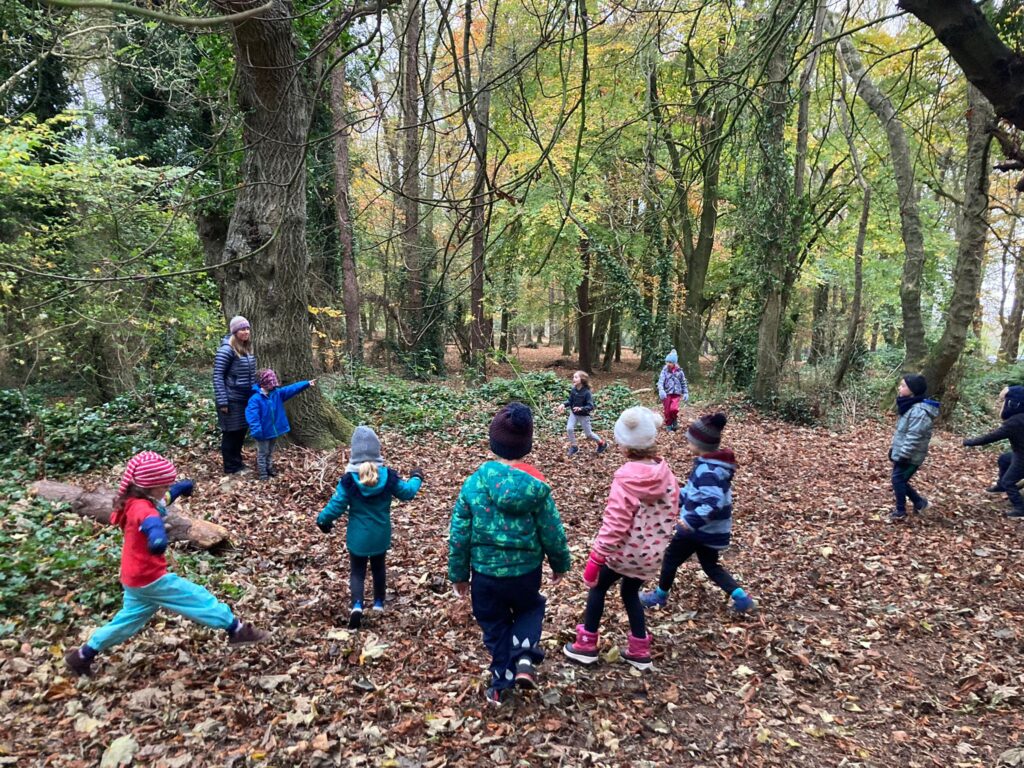
Then we stuck lots of sticks in a pile of leaves in the ground to resemble a big hedgehog. One of the children was a hedgehog protector, whose aim was to protect the sticks on the big hedgehog on the ground from the rest of the group, the stealers, by blindfolded and pointing at them. The stealers aimed to steal the hedgehog stick without the blindfolded protector hearing them and pointing at them. When the protector pointed to a stealer correctly then the stealer had to go back to the start. Everyone was so concentrated. The hedgehog protector used his sense of hearing, and the rest of the group used their body muscles not to make any sound, and walked as silently as possible just like prey and predators in the animal world.
After the game, the children played at the rainbow tree for a while. Most of them started to queue up for jumping from rocks just like the previous weeks. A few children voluntarily helped to maintain the leaf pile for everyone to be safe for jumping. Also a child played the role of a police man to make sure everyone was safely landing on the leaf pile. He ordered the maintenance guys that “We need to make the pile little rounder like a hill shape!”
At the basecamp, the children found the letter from the grandmother tree. In the letter, she firstly thanked all the letters she received in the previous week, and also she wrote about her friend, a hedgehog. “I noticed a heavy hedgehog snuffling around me last night. I think he was looking for food. Or maybe a little place to make a hibernaculum. What do you know about hedgehogs?” The children learnt the word “hibernaculum”, and shared what they knew about hedgehogs.
Because it was a foggy day, the usual basecamp looked different today, as one of the children described “as if we are in the clouds!” Some of the children started to hide behind trees and logs, and looked for someone to chase them. Soon, they started a ghost chasing game in the foggy forest.
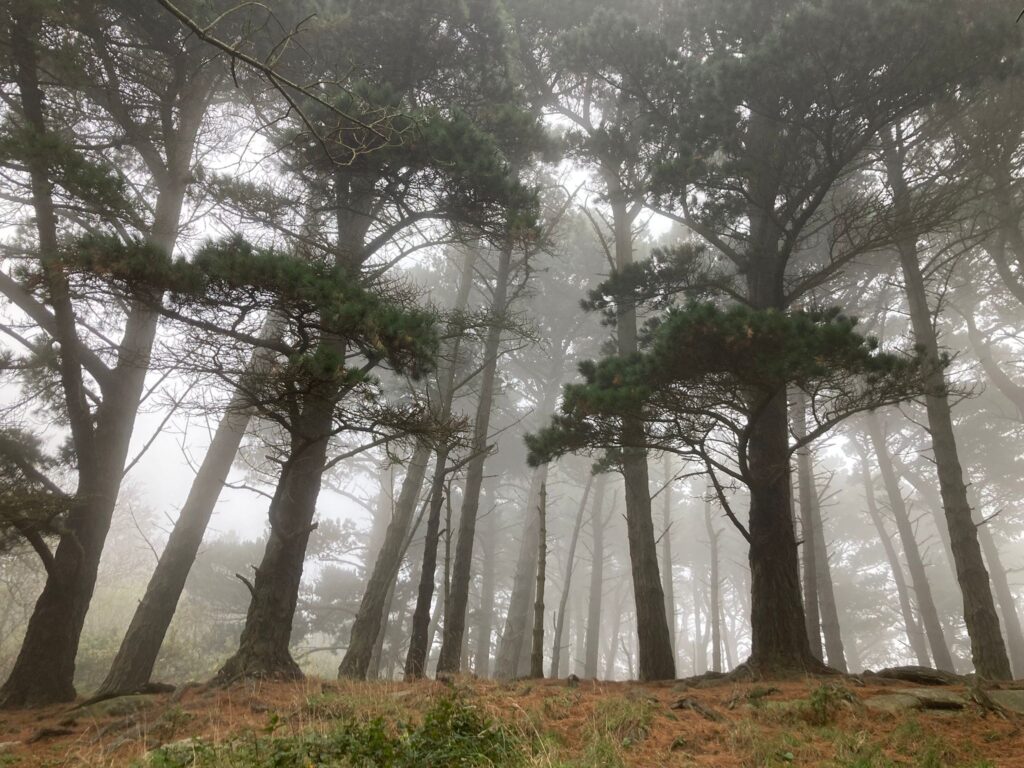
The atmosphere and the mood in the woods are different each day, and the children seem to pick suitable play on that day. In the same way, the mood of each child is also different each day, and forest school seems to be able to provide a suitable space for everyone. One of the children who was normally energetic was quiet today, and he spent time alone, and drew some pictures.
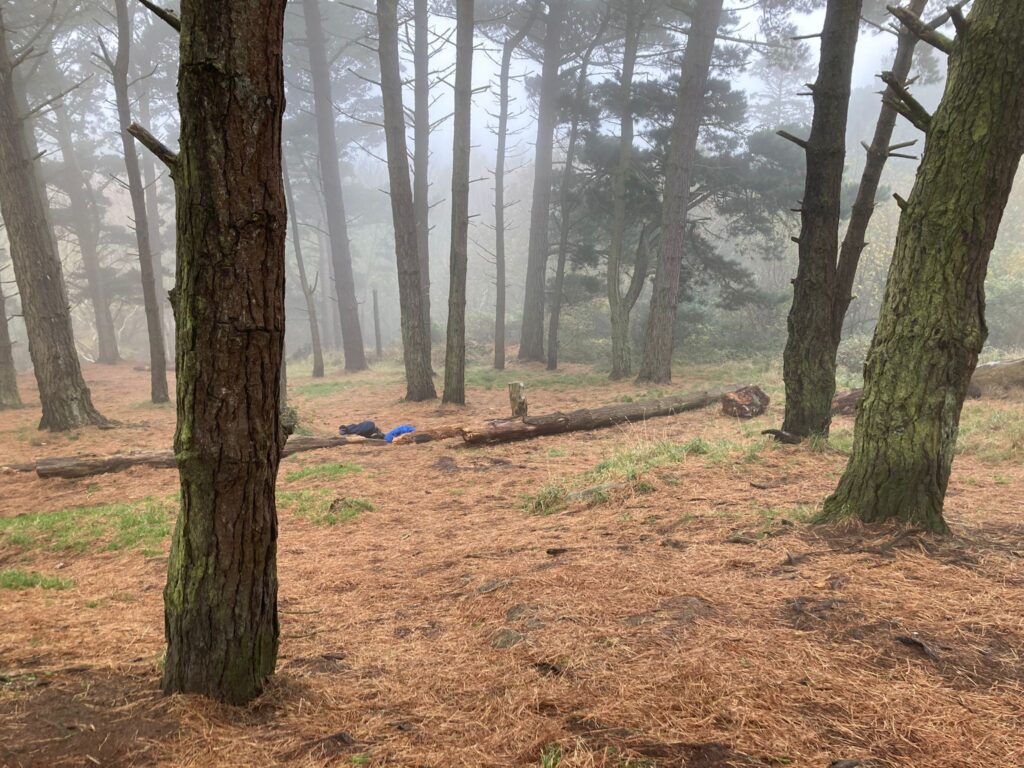
At lunch time, the teacher read a story about a hedgehog called Harry. The children learned hedgehogs like to eat “gooey snails”, “fat caterpillars” and “slimy slugs”.
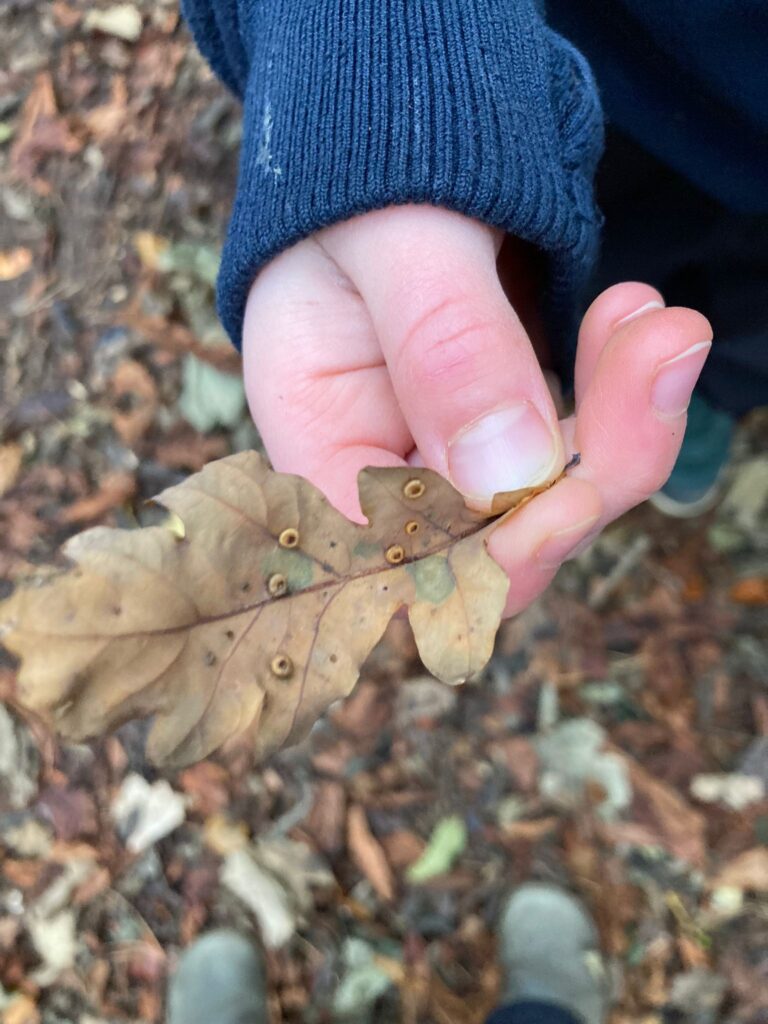
After lunch, some of them made their hedgehogs using teasels and clay, some of them continued making the tree hut, and some of them enjoyed playing the ghost chasing game.
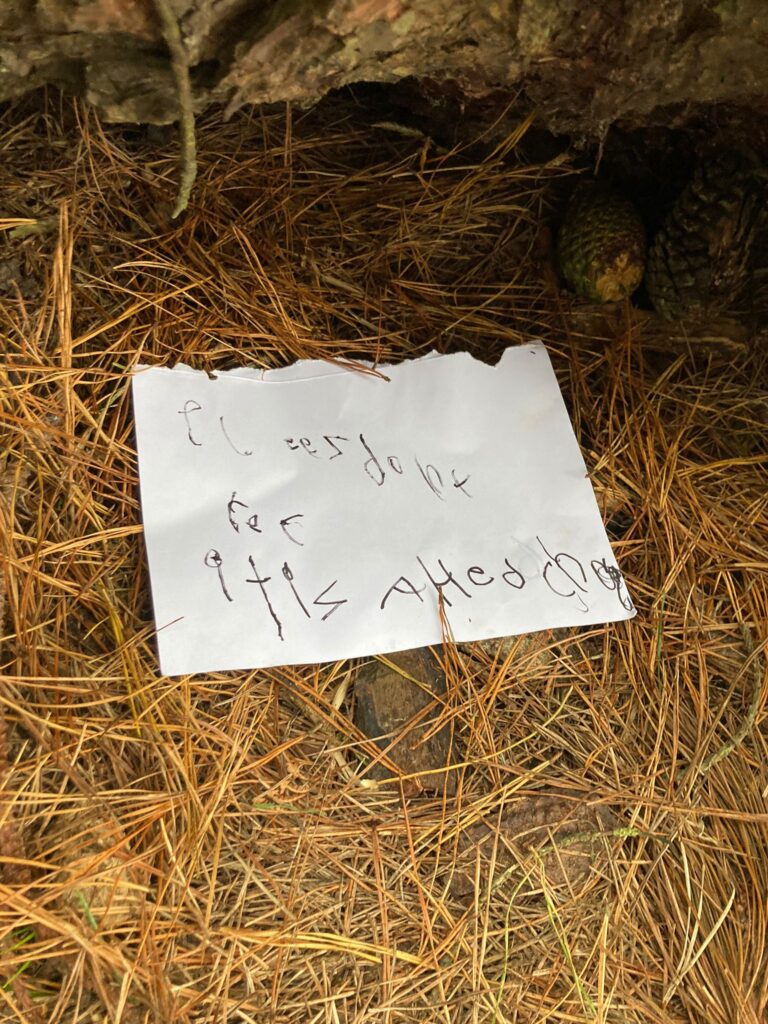
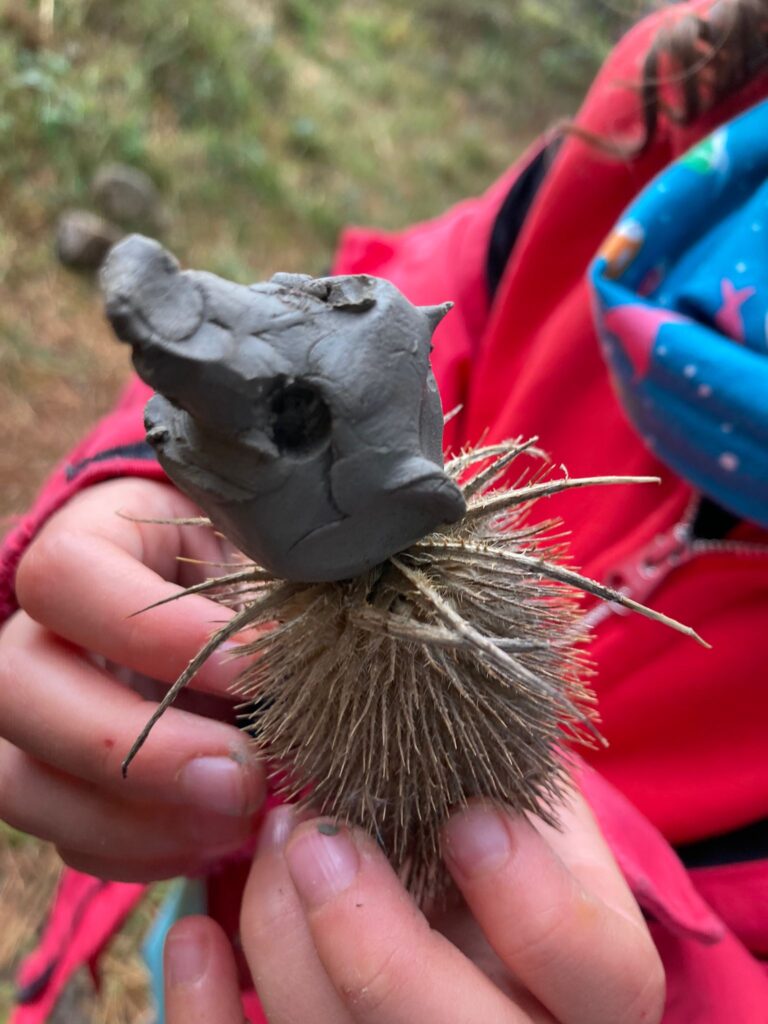
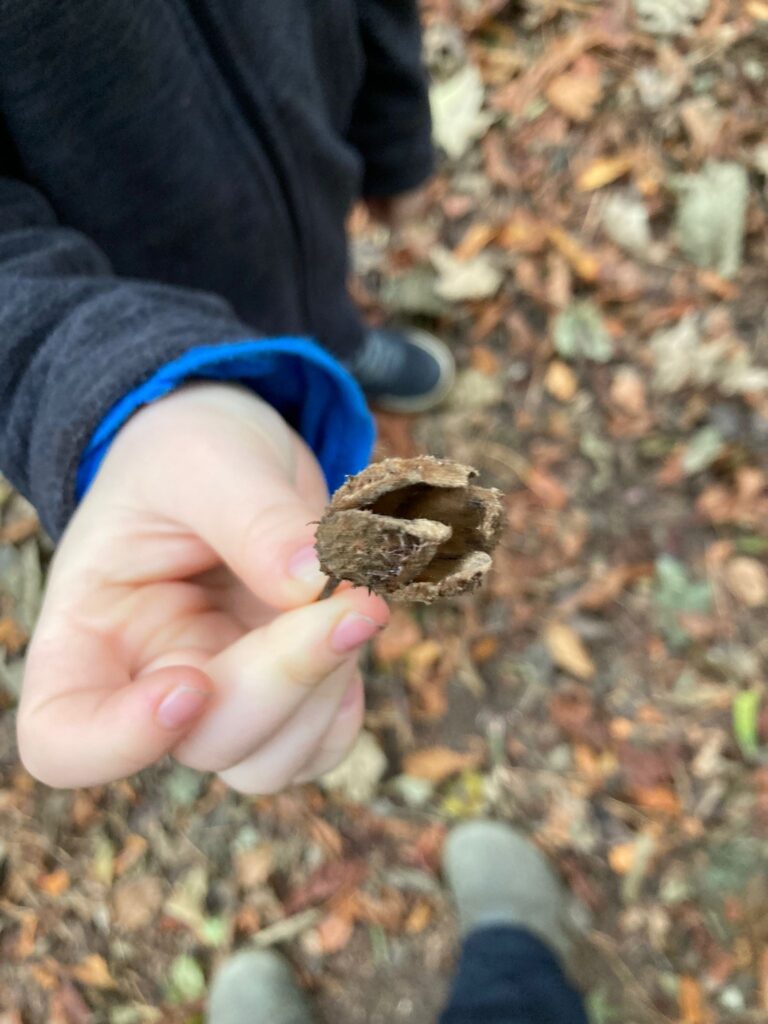
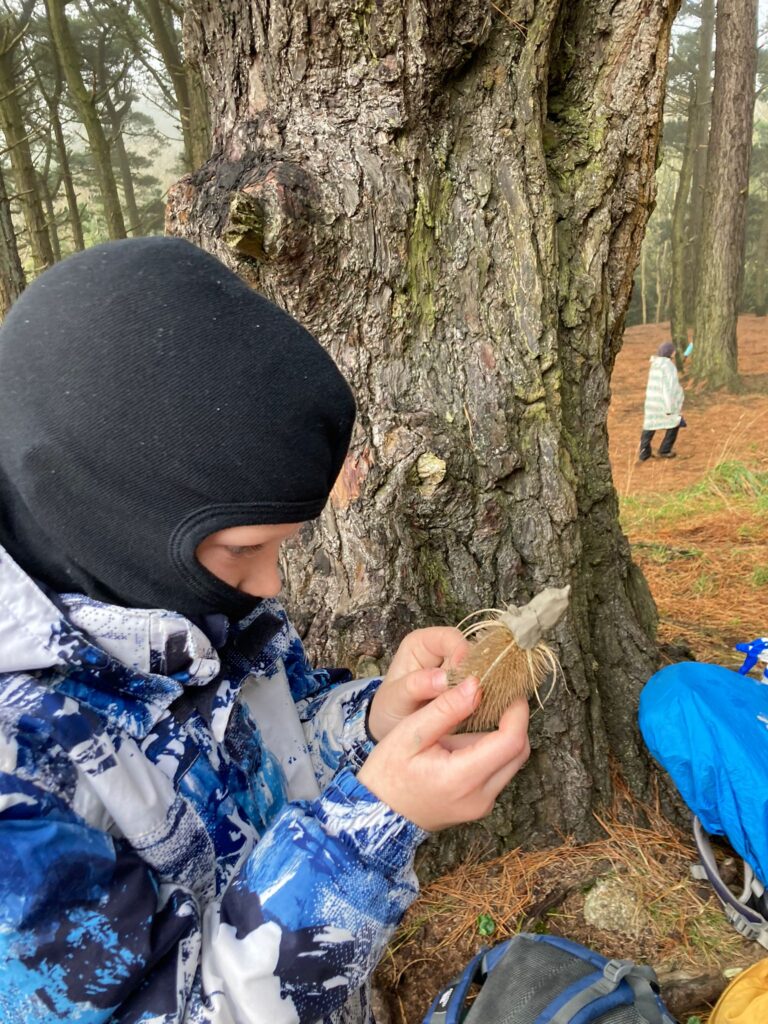
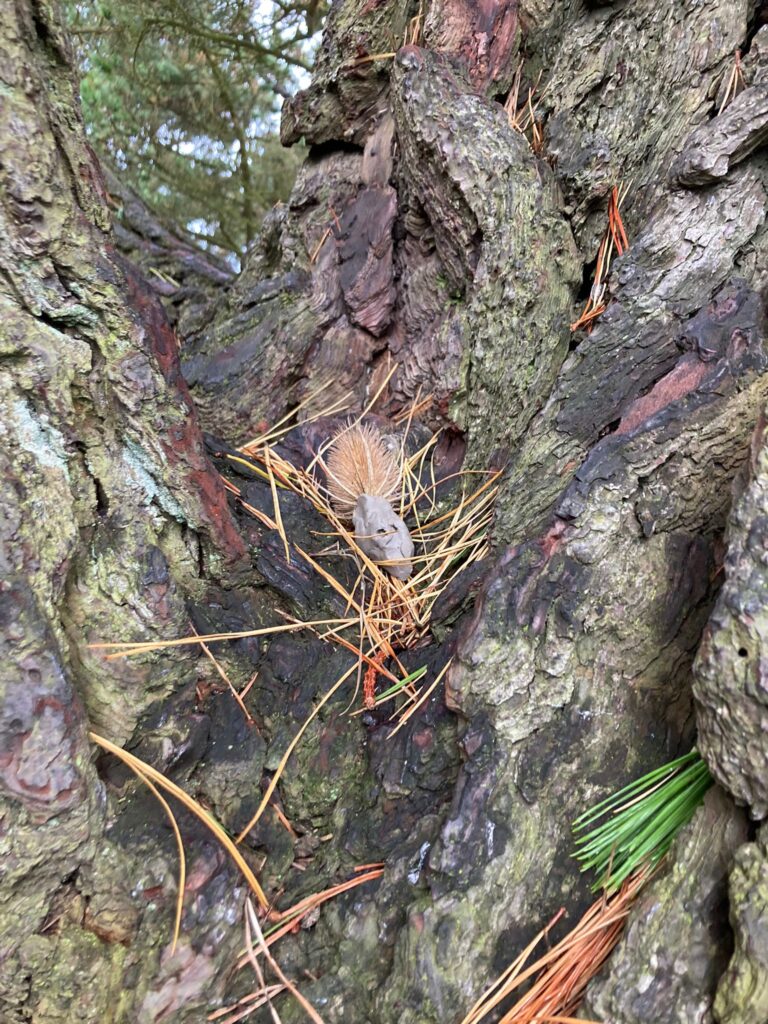
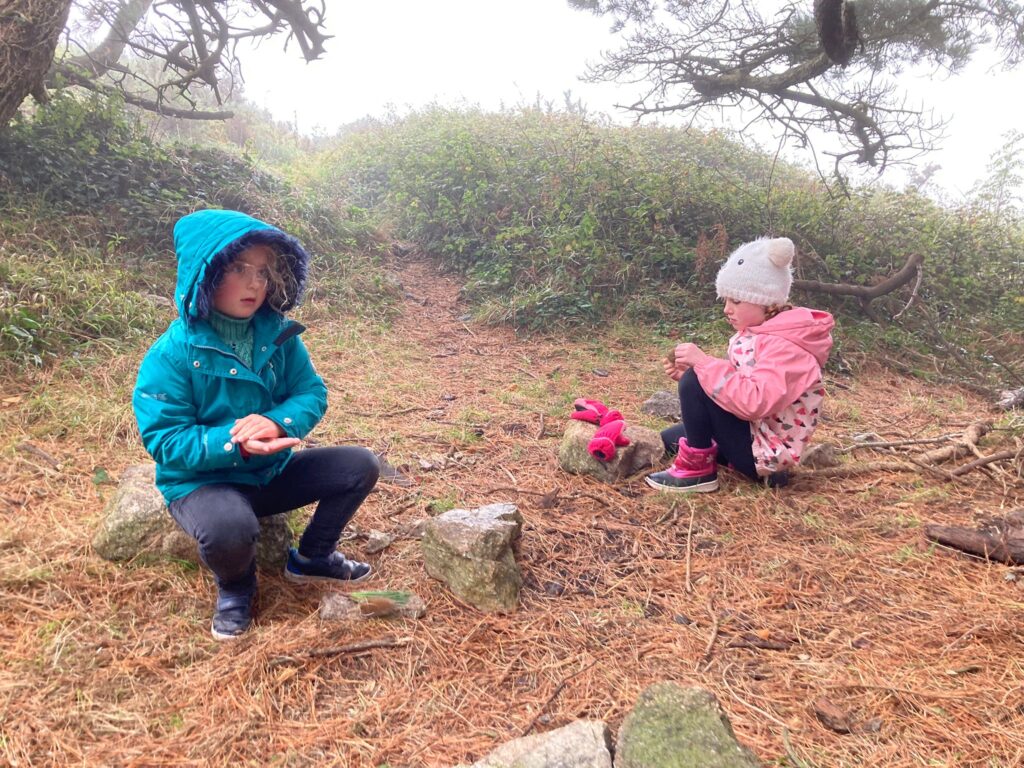
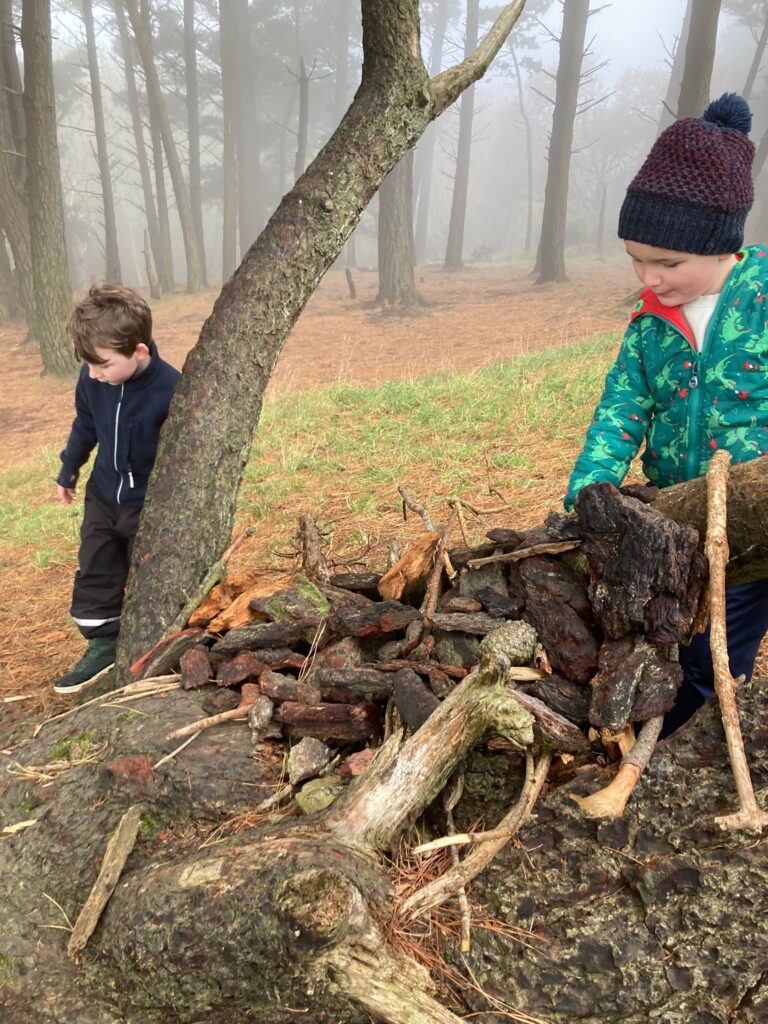
The session was nicely closed by the quiet sit spot time, followed by sharing what they noticed during the sit spot and what they were grateful for from the forest school today. We listened to each other’s findings, experiences and feelings. One of the children said “I was grateful for (his best friend’s name) and the forest!”
Today was our last session together this term. The air was mild, and there was warm sunlight coming through between the trees. The woods looked so calm and peaceful. The children enjoyed the last day of their forest school for this year.
The trees at the meeting point had shed most of their leaves, and there was a thick layer of fallen leaves on the ground. While waiting for everyone, some of the children played the hedgehog stalking game, and the others enjoyed playing with the fallen leaves. They collected the leaves, made a pile, and started to throw them at each other. One of the children told the others to put up their hoods so that the leaves would not get inside their jackets. They knew how to play with the fallen leaves by now.
Soon everyone joined playing with the fallen leaves. It was so much fun. Anyone who wanted be buried in the leaves lay down on the ground, and others helped cover them with the leaves. They said it was nice and cosy. When the children on the ground moved their hands and legs, they could make the “leaf angel” marks on the ground. Some of them jumped on the leaf piles, or threw the leaves into the sky like fireworks. Playing with the fallen leaves looked like the best present they could get. Children played as wild as they could – jumping, rolling off on the ground, scooping leaves, throwing, shouting with excitement and laughing.
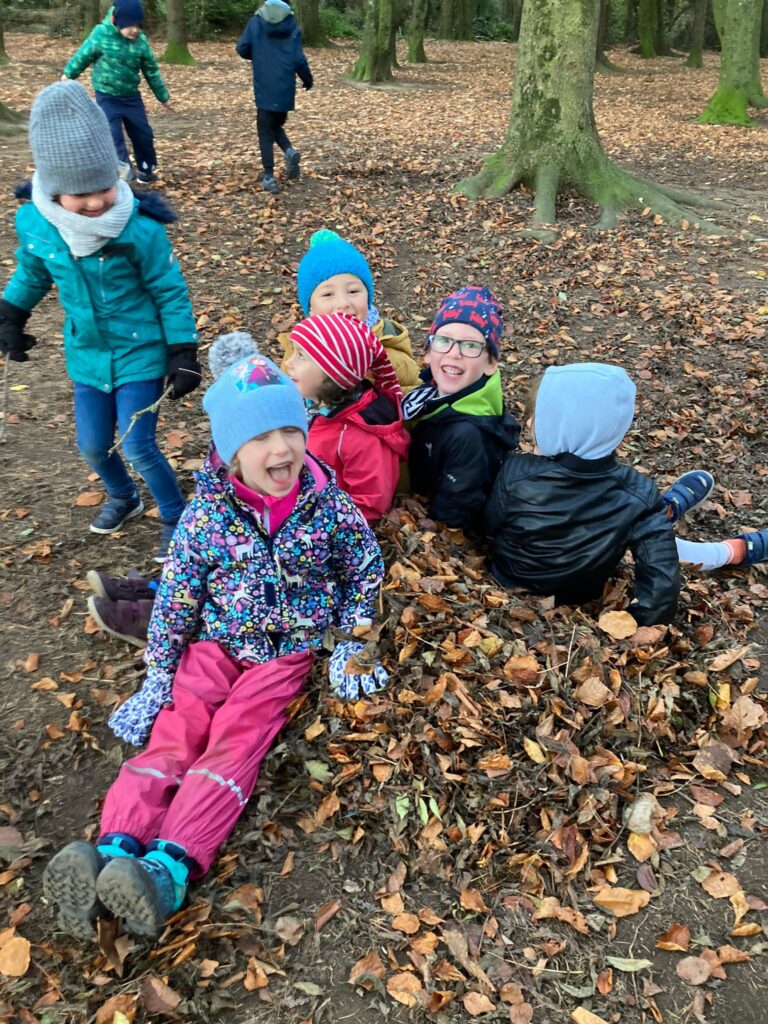
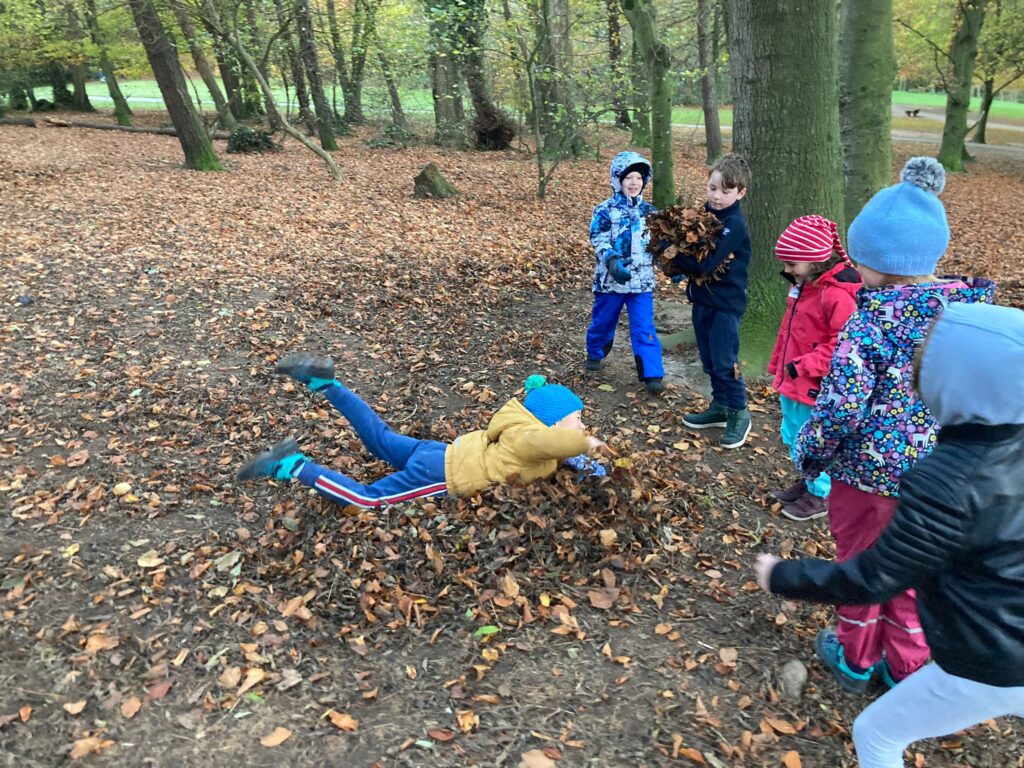
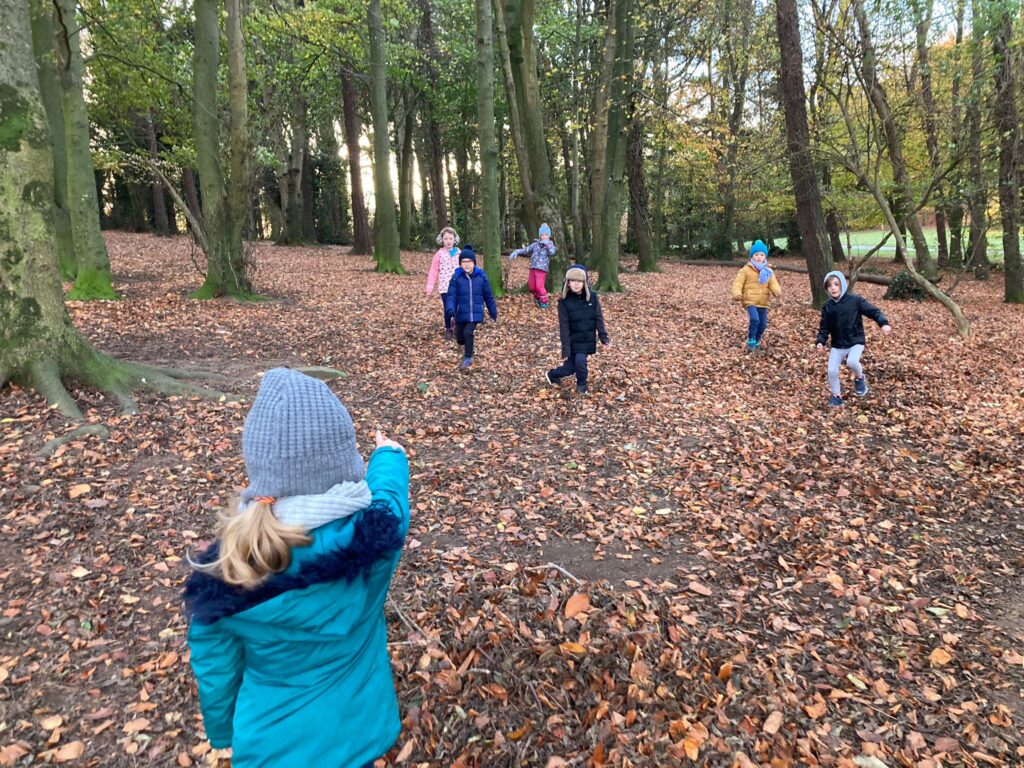
After the excitement with the fallen leaves, we had the opening circle, and the teacher asked everyone what they would like to do on their final day of forest school. There were many suggestions coming up from the children such as; playing at the leafy pit, having some pine needle tea, drawing pictures for the grandmother tree, playing games which they liked from the previous sessions, introducing a new game, playing with the grandmother tree, and making land art.
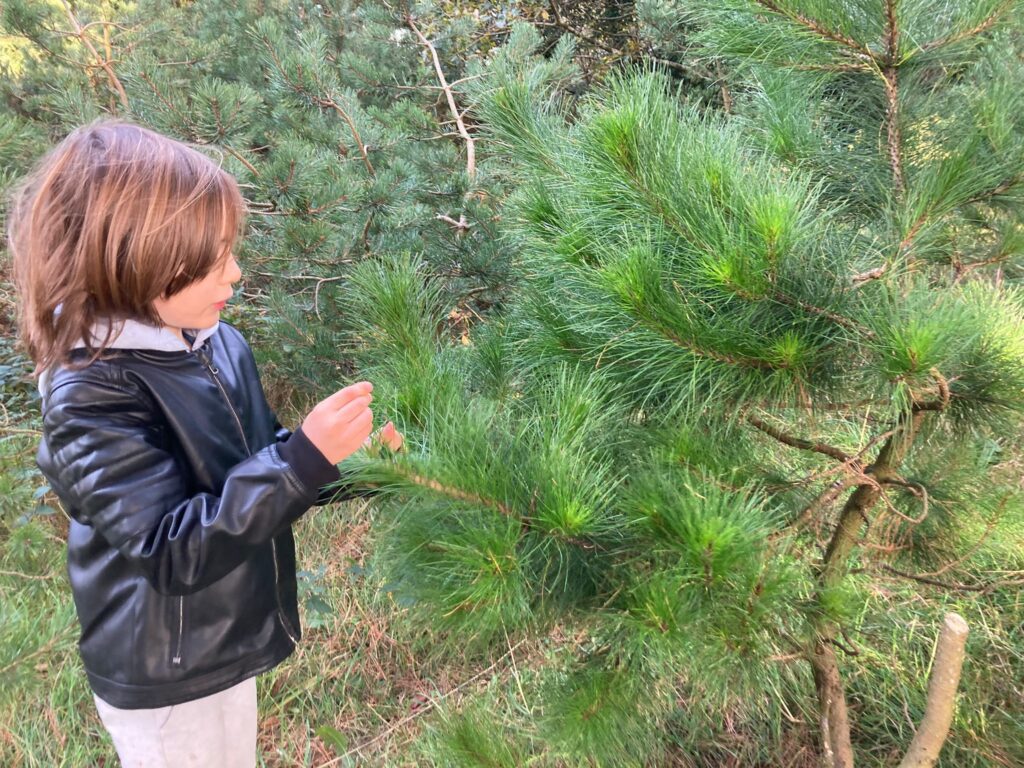
On our way up we found more of nature’s treasures.
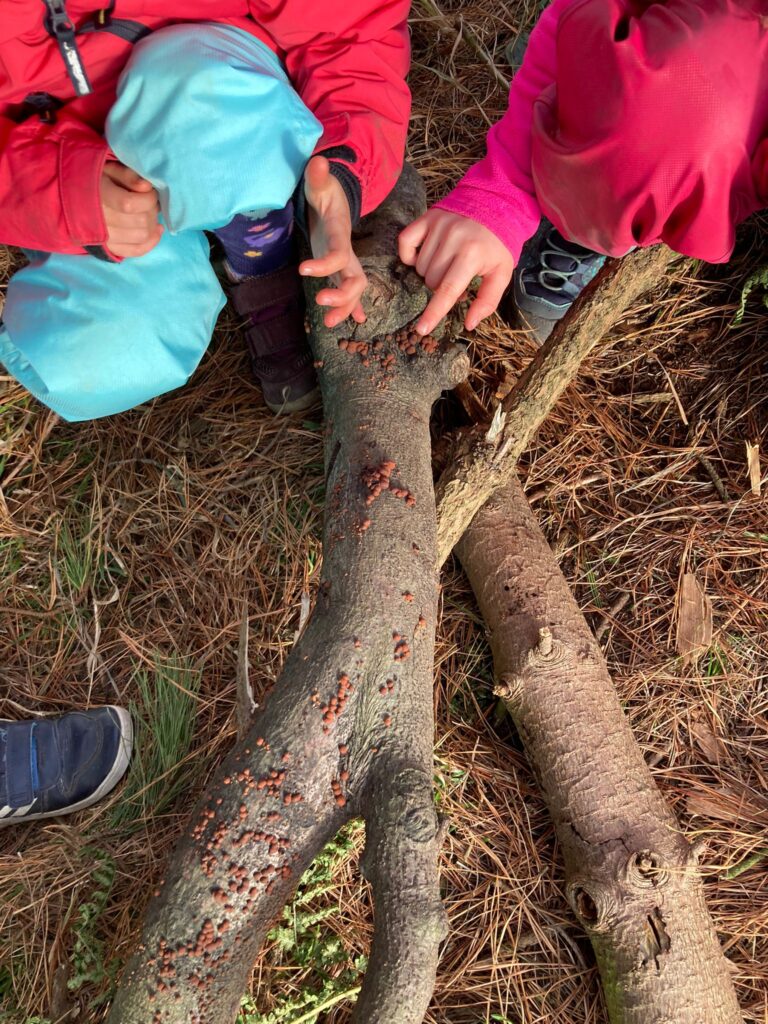
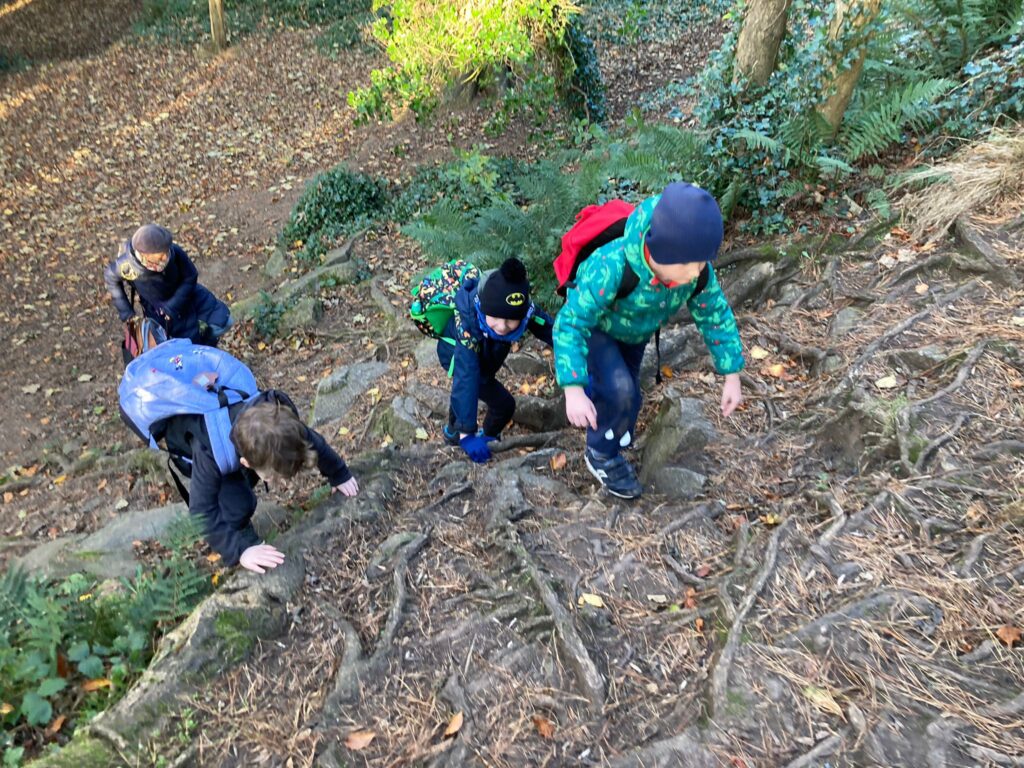
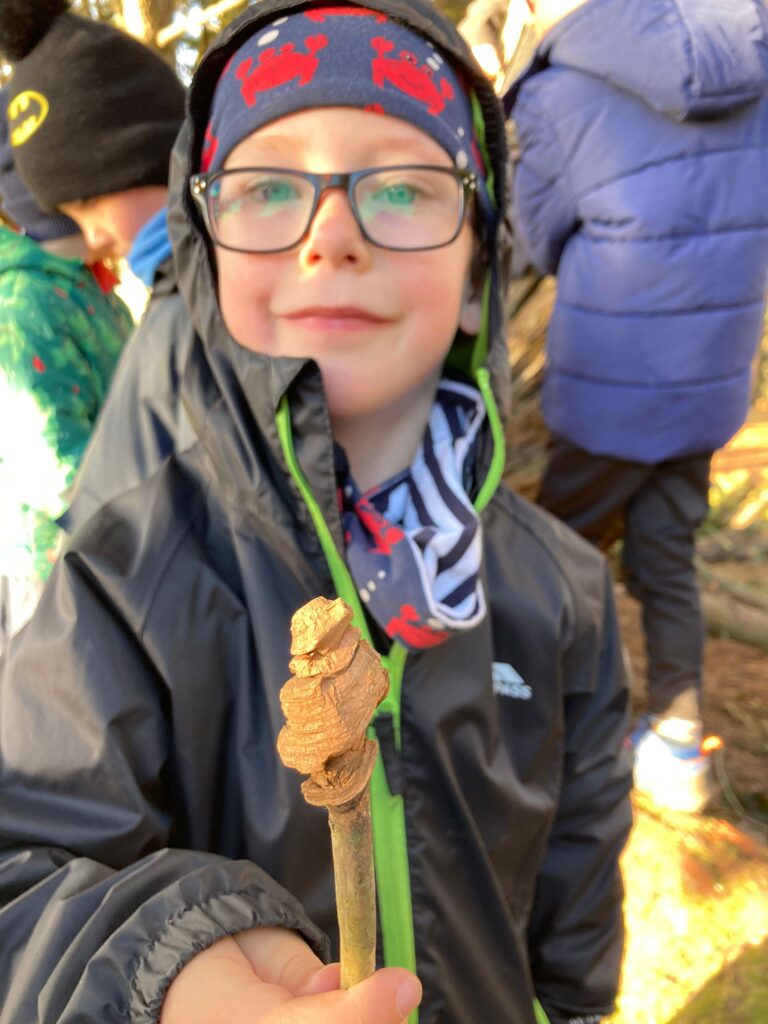
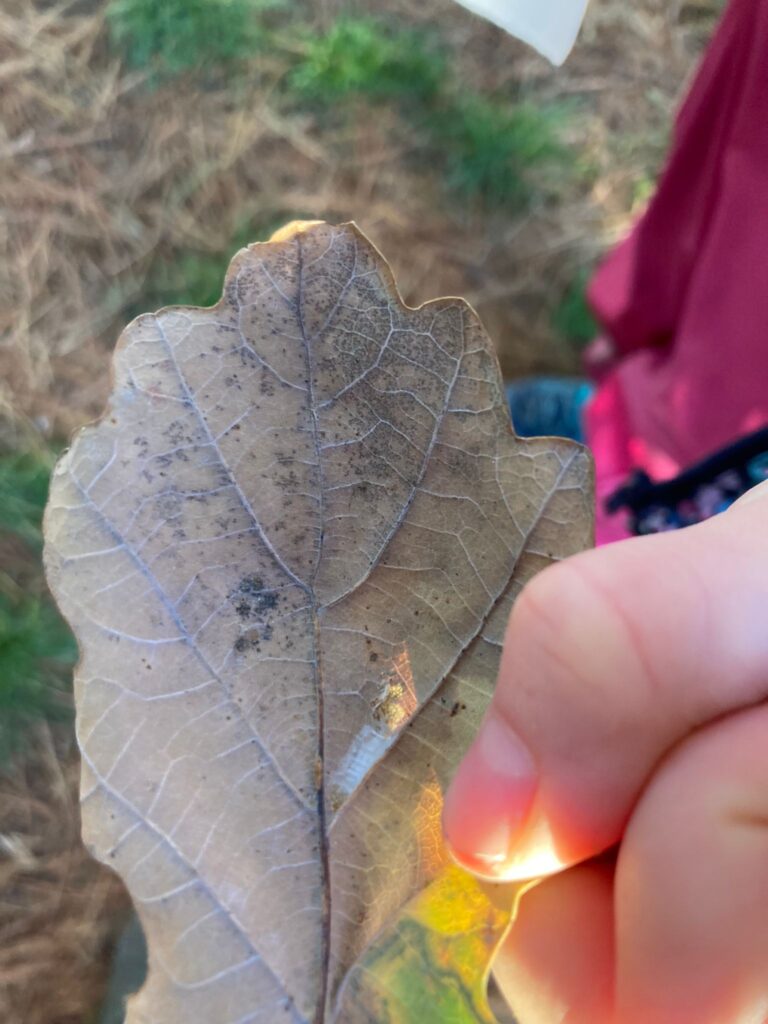
After playing at the rainbow tree for a while, we moved to our basecamp, and found the last letter from the grandmother tree. In the letter, she thanked everyone for being so kind to her and her friends, and for having fun around her. She also mentioned that she was wanting to get quieter and slower because there was not enough light to make lots of food. The children learnt that the trees also get sleepy during the winter like hedgehogs. The grandmother tree asked the children if they would come back to say hi to her after finishing the forest school, and most of the children said “Yes!”
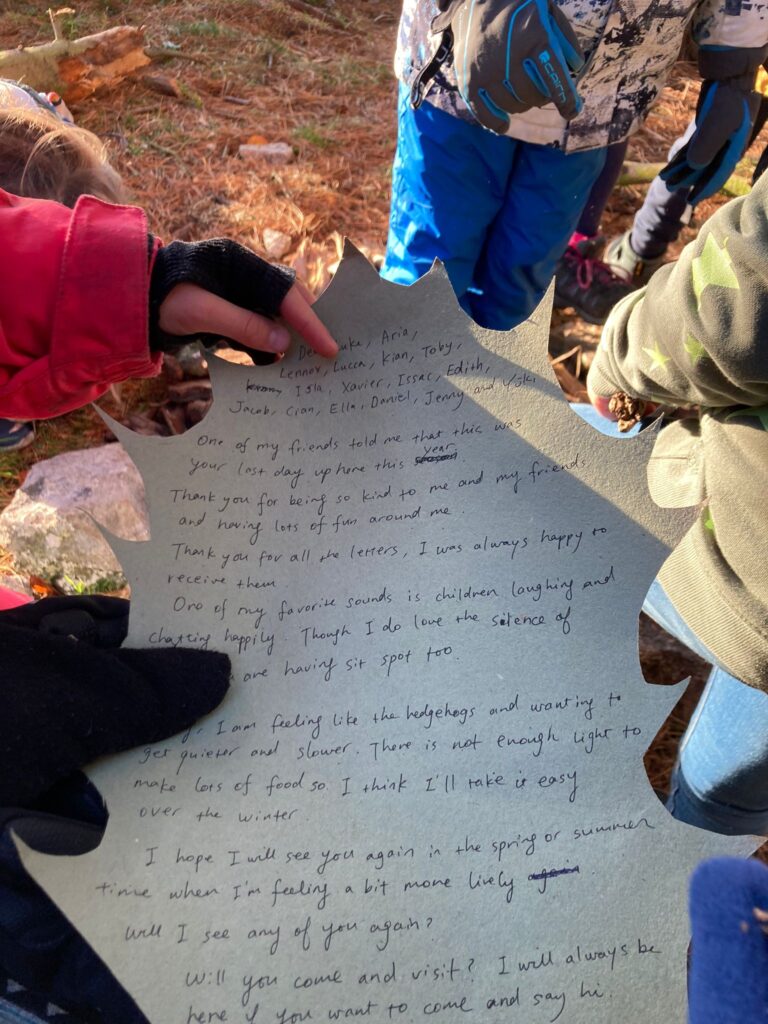
During the free play, one of the children noticed that the pine cones he had put on the grandfather tree in the previous week had gone, and he believed that it was because hedgehogs took them. He was so excited and started to look for the hedgehogs that might be hiding under the leaves.
The teacher brought some magnifying glasses, and some of them started to look for bugs. One of the children was particularly interested in insects and tiny creatures. In the previous sessions, he was the one who always found some insects and showed them to everyone. With a magnifying glass, he was so desperate to find some insects, and he looked everywhere he could think of – under the rocks, logs, tree holes or barks. However, what he found was that there were not many insects out this time of the year, and this was a great finding also.
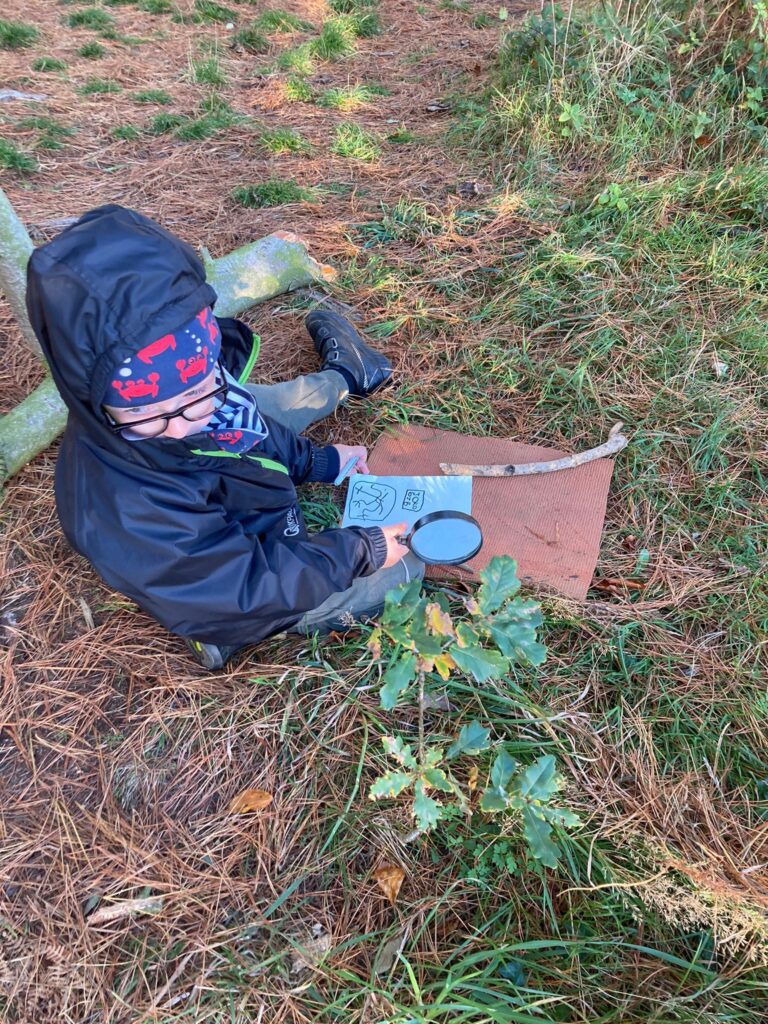
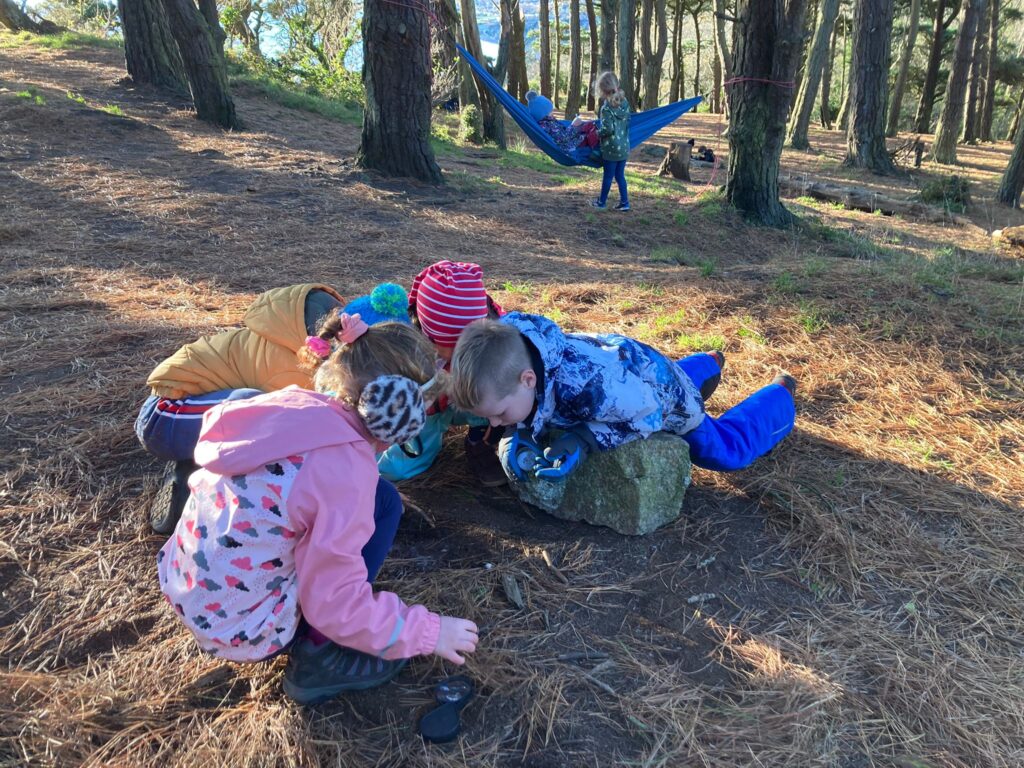
The teacher put up three hammocks at the basecamp, and the children enjoyed lying on them and being relaxed. At the tree hut, a few children were building its roof. This time, two of them wanted to be the leaders, and they had to decide a rule to satisfy both of them, which was challenging. It was a great opportunity to learn to solve emotional conflicts.
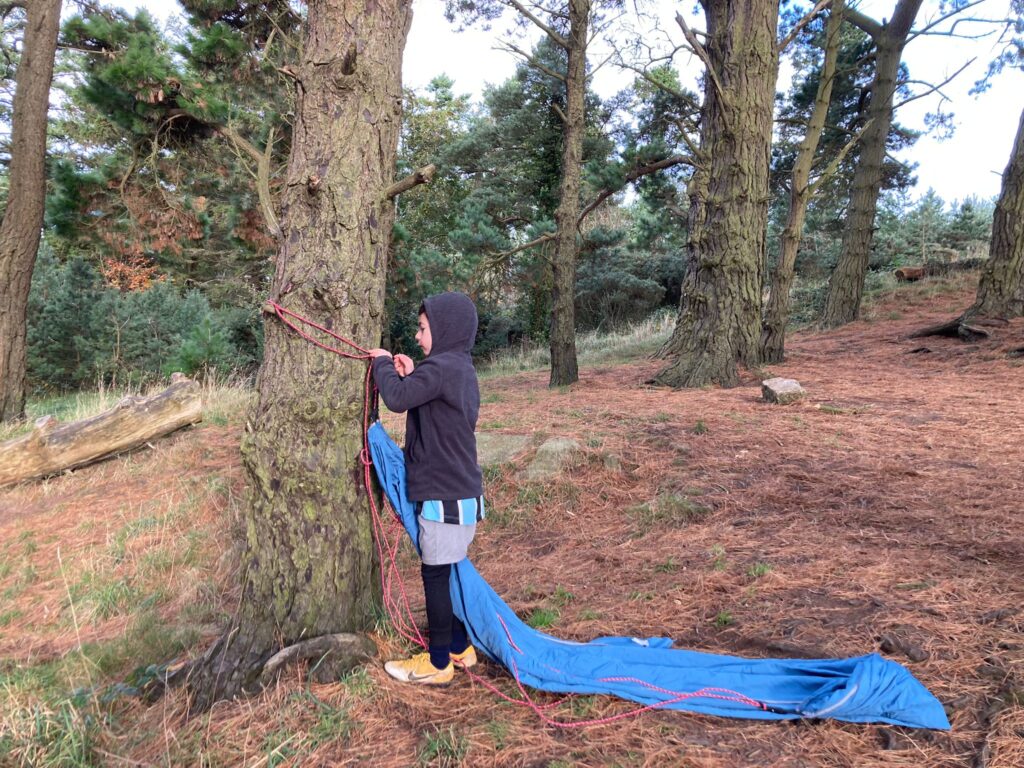
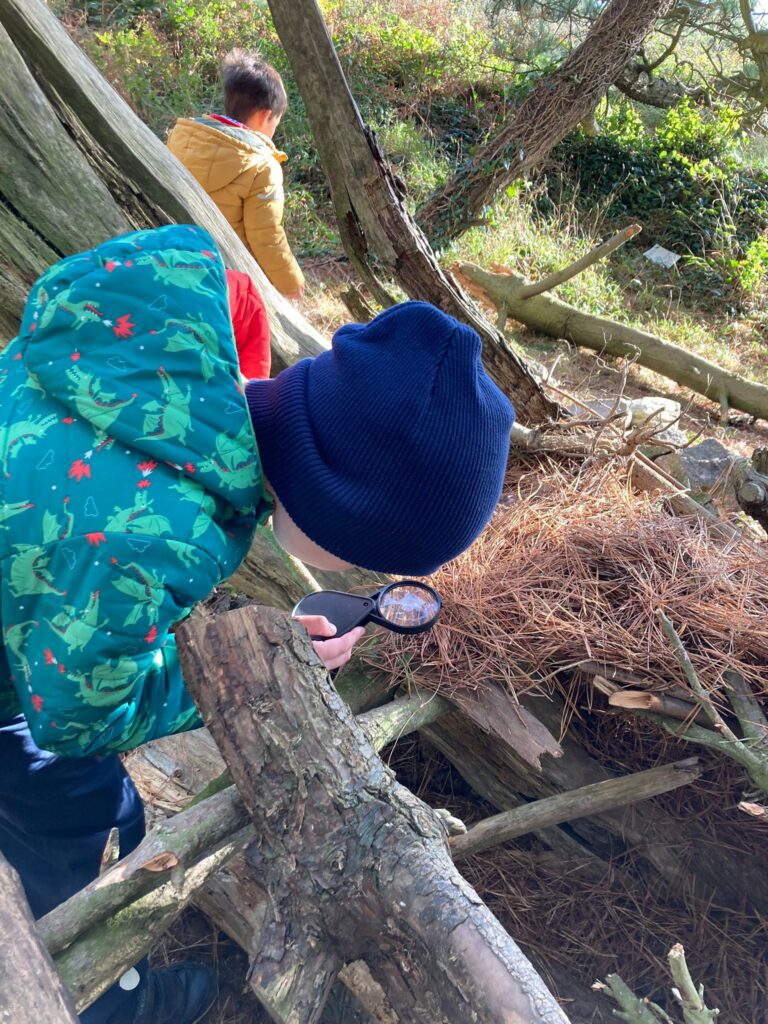
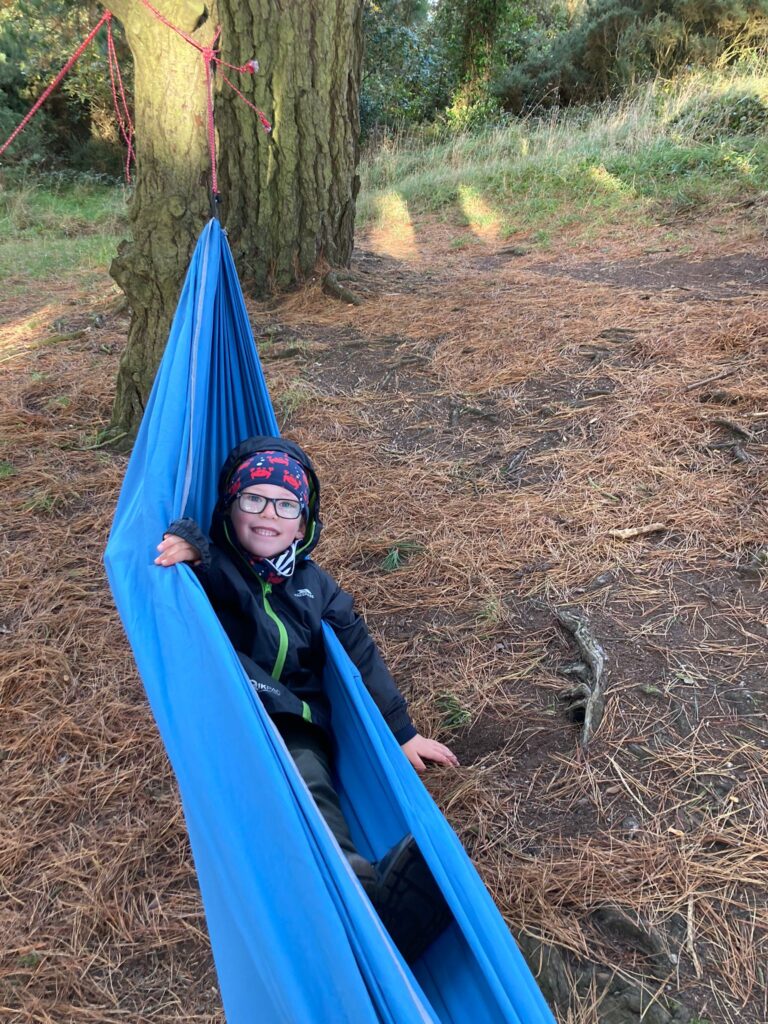
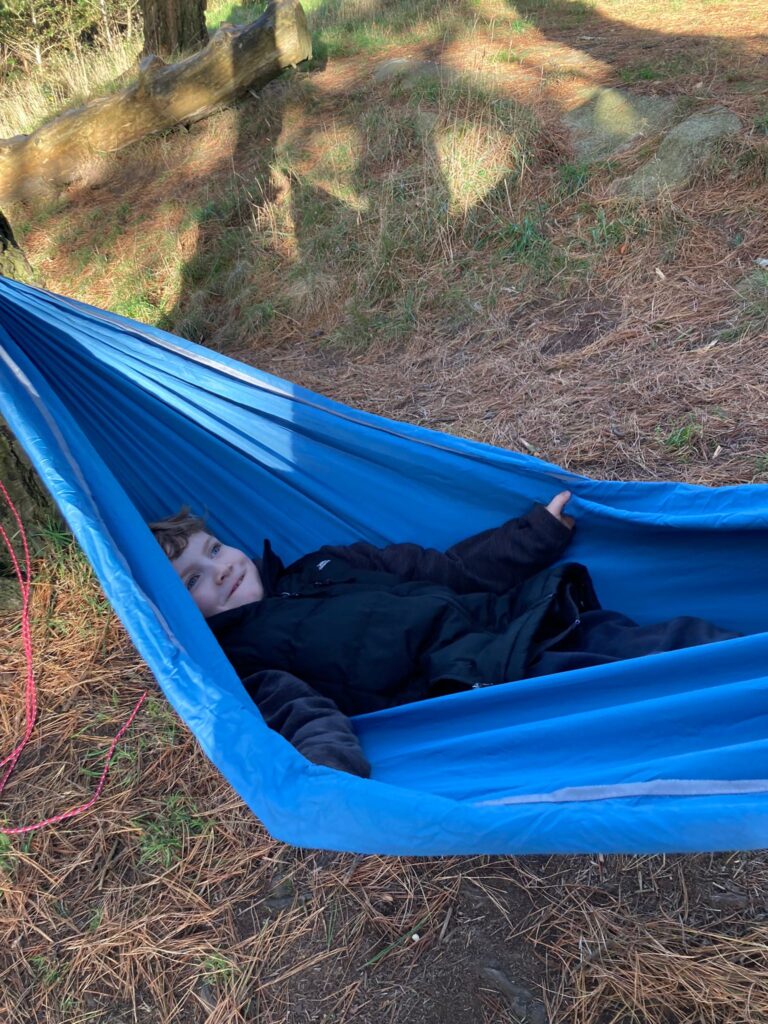
At lunch break, we talked more about the life of hedgehogs. Then we had a little more time for free play. One of the children made a small hedgehog hibernaculum, some of the children made a big hibernaculum as a team, and some others played the ghost chasing game.
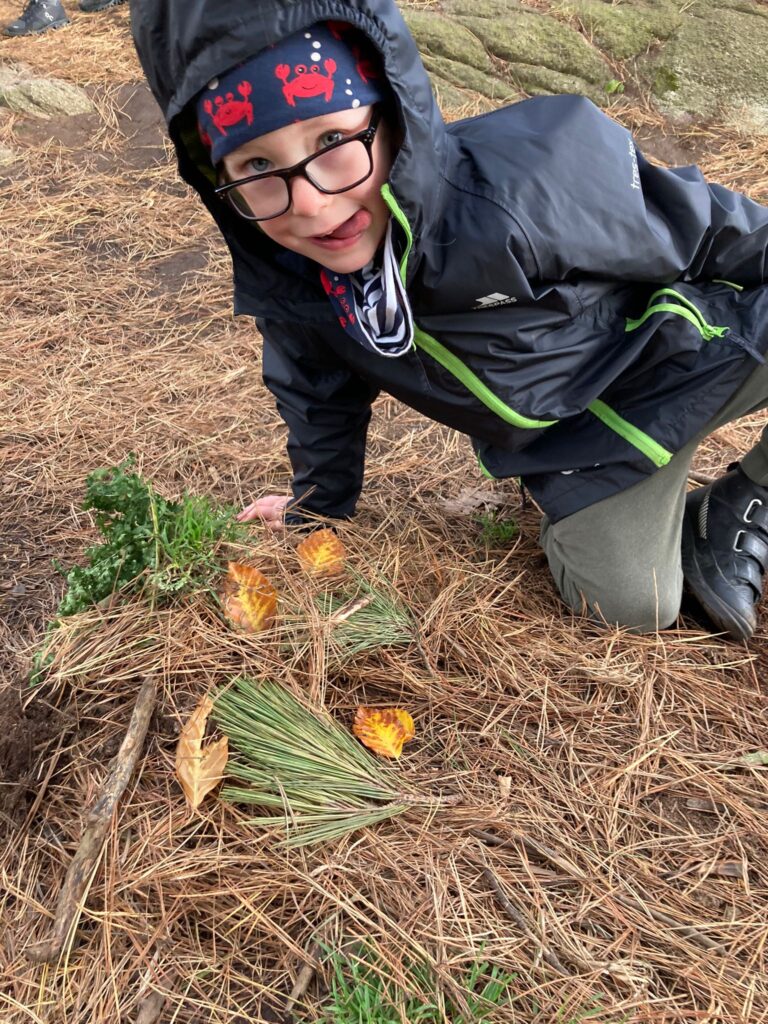
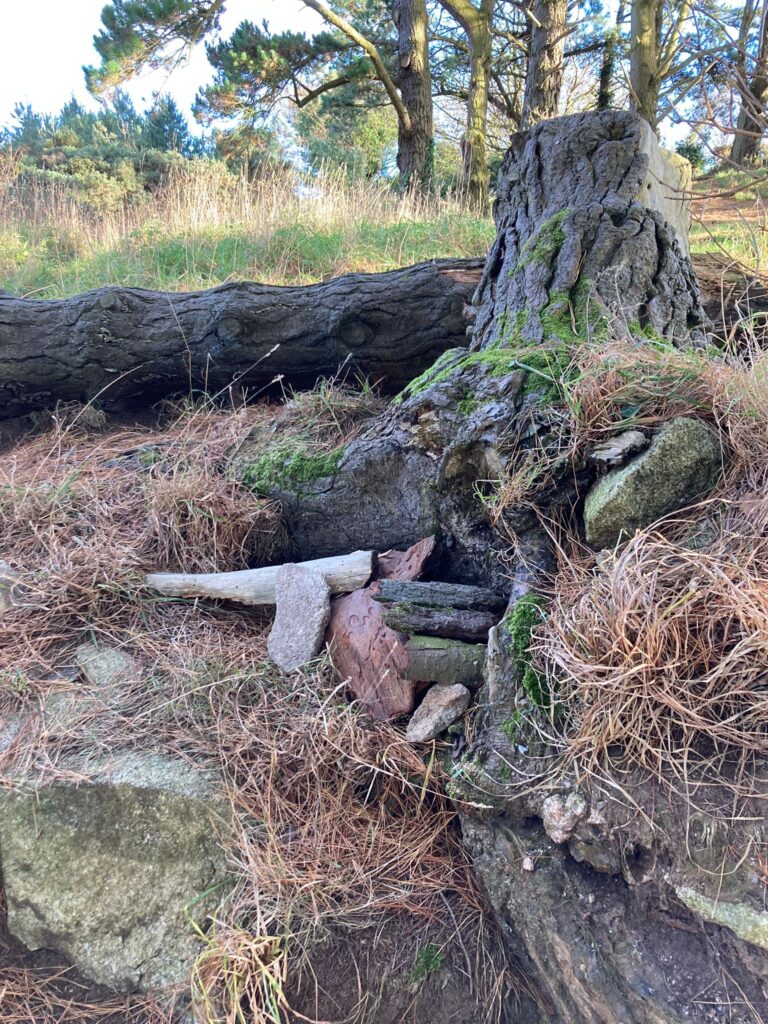
During their final sit spot the children noticed that the sea looked like it was moving really fast, that the clouds were moving quickly and the wind blowing in our faces, that the heat from the sun was warm, the trees dancing happily in the wind, the pine needles blowing, the trees waving hands and talking to each other, and the scenery was very beautiful.
There was a magic in the Senior Infants forest school, which was something unique about their age. The relationship which the children could build with nature seemed to be so intimate. This could be seen in the attachment with the grandmother tree, digging holes and finding something new each week, building fairy tree houses, talking and giving tea to a baby oak tree, or finding insects and looking at them carefully. These attitudes, full of imagination, driven by their curiosities, finding the incredible things in nature with innocent eyes, could disappear with their development, as they get older.
However, having these experiences at their age could influence their attitudes toward nature for the rest of their lives.
Lastly, the children shared what they were grateful for from forest school. We shared the same moments in the woods, yet everyone had different flashbacks. They were grateful for: